
FLOOD INSURANCE
FEMA's New Rate-
Setting Methodology
Improves Actuarial
Soundness but
Highlights Need for
Broader Program
Reform
Report to Congressional Addressees
July 2023
GAO-23-105977
United States Government Accountability Office
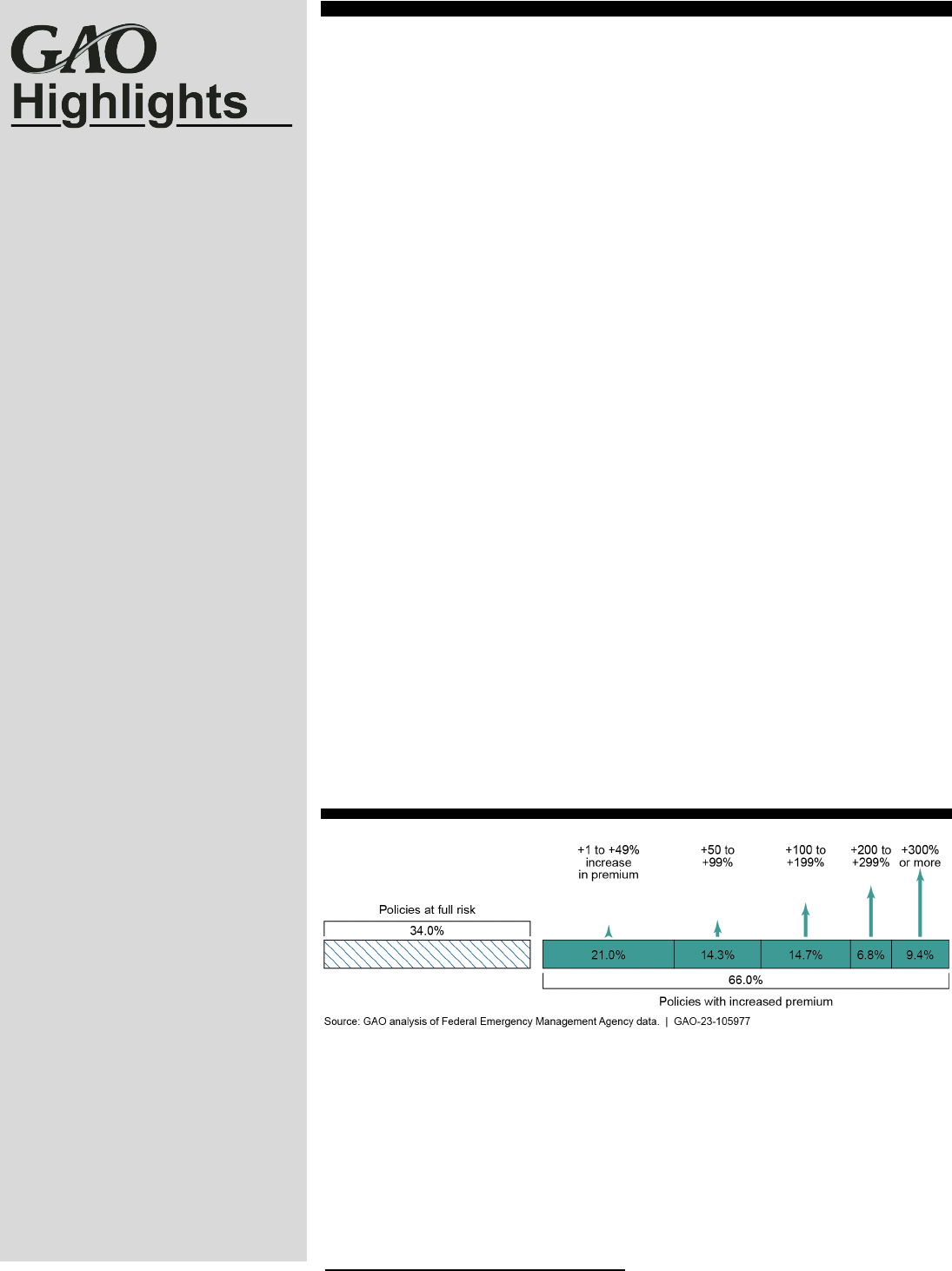
United States Government Accountability Office
Highlights of GAO-23-105977, a report to
congressional
addressees
July 2023
FLOOD INSURANCE
FEMA’s New Rate
-Setting Methodology Improves
Actuarial Soundness
but Highlights Need
for Broader
Program
Reform
What GAO Found
In October 2021, the Federal Emergency Management Agency (FEMA) began
implementing Risk Rating 2.0, a new methodology for setting premiums for the
National Flood Insurance Program (NFIP). The new methodology substantially
improves ratemaking by aligning premiums with the flood risk of individual
properties, but some other aspects of NFIP still limit actuarial soundness. For
example, in addition to the premium, policyholders pay two charges that are not
risk based. Unless Congress authorizes FEMA to align these charges with a
property’s risk, the total amounts paid by policyholders may not be actuarially
justified, and some policyholders could be over- or underpaying. Further,
Congress does not have certain information on the actuarial soundness of NFIP,
such as the risk that the new premiums are designed to cover and projections of
fiscal outlook under a variety of scenarios. By producing an annual actuarial
report that includes these items, FEMA could improve understanding of Risk
Rating 2.0 and facilitate congressional oversight of NFIP.
Risk Rating 2.0 is aligning premiums with risk, but affordability concerns
accompany the premium increases. FEMA had been increasing premiums for a
number of years prior to implementing Risk Rating 2.0. By December 2022, the
median annual premium was $689, but this will need to increase to $1,288 to
reach full risk. Under Risk Rating 2.0, about one-third of policyholders are
already paying full-risk premiums. Many of these policyholders had their
premiums reduced upon implementation of Risk Rating 2.0. All others will require
higher premiums, including 9 percent who will eventually require increases of
more than 300 percent. Further, Gulf Coast states are among those experiencing
the largest premium increases. Policies in these states have been among the
most underpriced, despite having some of the highest flood risks.
Estimated Premium Changes under Risk Rating 2.0, as of December 2022
Annual premium increases for most policyholders are limited to 18 percent by
statute. These caps help address some affordability concerns in the near term,
but have several limitations.
• First, the caps perpetuate an unfunded premium shortfall. GAO
estimated it would take until 2037 for 95 percent of current policies to
reach full-risk premiums, resulting in a $27 billion premium shortfall (see
figure below). The costs of shortfalls are not transparent to Congress or
the public because they are not recognized in the federal budget and
become evident only when NFIP must borrow from the Department of
the Treasury after a catastrophic flood event.
View GAO-23-105977. For more information,
contact
Alicia Puente Cackley at (202) 512-
8678 or
[email protected] or Frank Todisco
at (202) 512
-2700 or todiscof@gao.gov.
Why GAO Did This Study
NFIP was created with competing
policy goals
—keeping flood insurance
affordable and the program fiscally
solvent. A historical focus on
affordability has led to premiums that
do not fully reflect
flood risk,
insufficient
revenue
to pay claims, and, ultimately,
$36.5 billion in borrowing from
Treasury since 2005.
FEMA
’s new Risk Rating 2.0
methodology is intended to better align
premium
s with underlying flood risk at
the individual property level.
This report
examines several
objectives,
including (1) the actuarial
soundness of
Risk Rating 2.0, (2) how
premium
s are changing, (3) efforts to
address affordability for policyholders,
(4)
options for addressing the debt,
and (5) implications for the private
market
.
GAO reviewed
FEMA documentation
and analyzed NFIP
, Census Bureau,
and private flood
insurance data. GAO
also interviewed FEMA officials
,
actuarial organizations, private flood
insurers, and insurance agent
association
s.
What GAO Recommends
GAO recommends
six matters for
congressional consideration
.
Specifically, Congress should consider
the following:
•
Authorizing and requiring
FEMA to
replace two policyholder charges
with risk-based premium charges
•
Replacing discounted premiums
with a means-based assistance
program that is reflected in the
federal budget
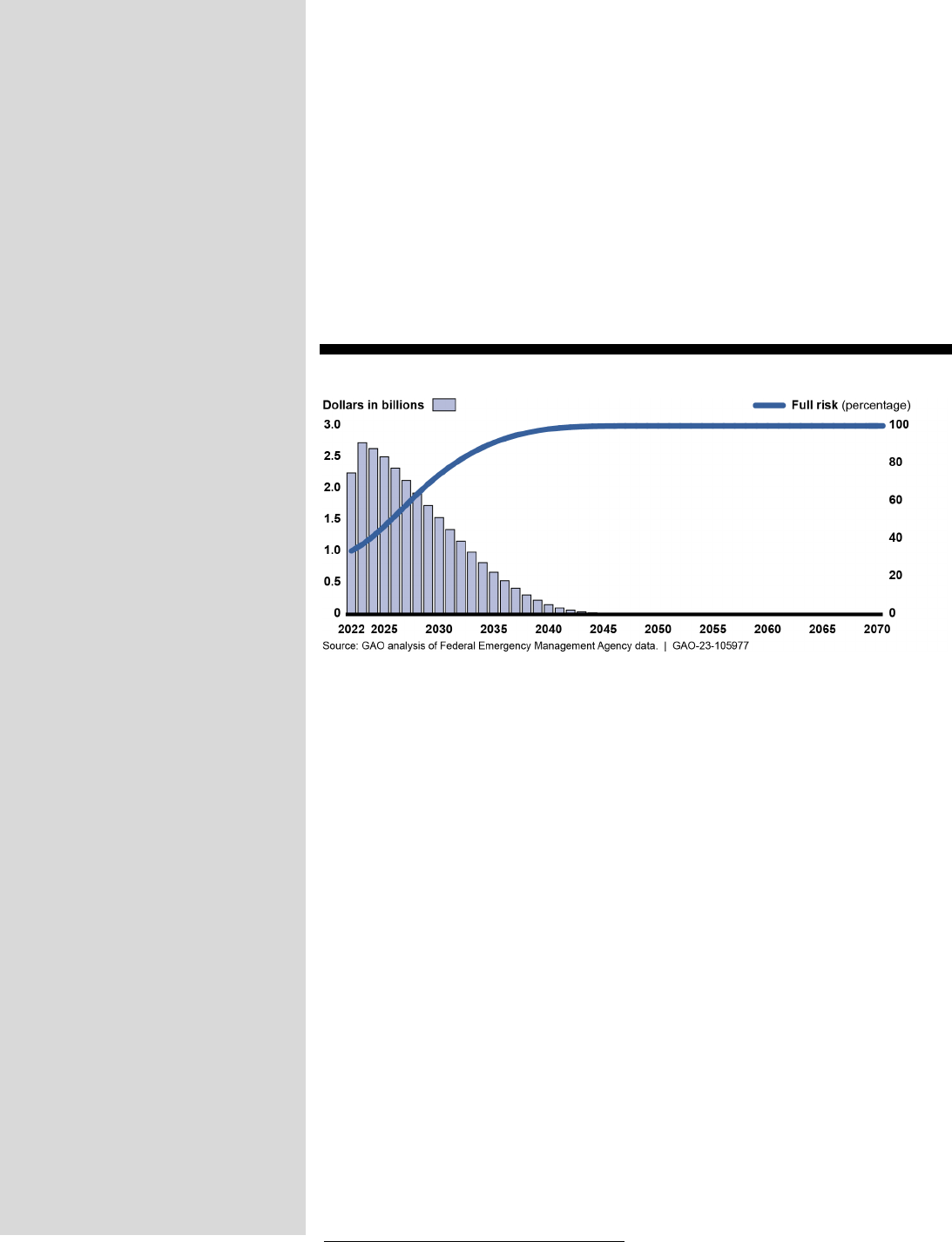
United States Government Accountability Office
• Second, the caps address affordability poorly. For example, they are not
cost-effective because some policyholders who do not need assistance
likely are still receiving it. Concurrently, some policyholders needing
assistance likely are not receiving it, and the discounts will gradually
disappear as premiums transition to full risk.
• Third, the caps keep NFIP premiums artificially low, which undercuts
private-market premiums and hinders private-market growth.
An alternative to caps on annual premium increases is a means-based
assistance program that would provide financial assistance to policyholders
based on their ability to pay and be reflected in the federal budget. Such a
program would make NFIP’s costs transparent and avoid undercutting the private
market. If affordability needs are not addressed effectively, more policyholders
could drop coverage, leaving them unprotected from flood risk and more reliant
on federal disaster assistance. Addressing affordability needs is especially
important as actions to better align premiums with a property’s risk could result in
additional premium increases.
Estimated Premium Shortfall and Percentage of National Flood Insurance Program Policies at
Full-Risk Premiums, by Calendar Year
FEMA has had to borrow from Treasury to pay claims in previous years and
would have to use revenue from current and future policyholders to repay the
debt. NFIP’s debt largely is a result of discounted premiums that FEMA has been
statutorily required to provide. In addition, a statutorily-required assessment has
the effect of charging current and future policyholders for previously incurred
losses, which violates actuarial principles and exacerbates affordability concerns.
Even with this assessment, it is unlikely that FEMA will ever be able to repay the
debt as currently structured. For example, with the estimated premium shortfalls,
repaying the debt in 30 years at 2.5 percent interest would require an annual
payment of about $1.9 billion, equivalent to a 60 percent surcharge for each
policyholder in the first year. Such a surcharge could cause some policyholders
to drop coverage, leaving them unprotected from flood risk and leaving NFIP with
fewer policyholders to repay the debt. Unless Congress addresses this debt—for
example, by canceling it or modifying repayment terms—and the potential for
future debt, NFIP’s debt will continue to grow, actuarial soundness will be
delayed, and affordability concerns will increase.
Risk Rating 2.0 does not yet appear to have significantly changed conditions in
the private flood insurance market because NFIP premiums generally remain
lower than what a private insurer would need to charge to be profitable. Further,
certain program rules continue to impede private-market growth. Specifically,
NFIP policyholders are discouraged from seeking private coverage because
statute requires them to maintain continuous coverage with NFIP to have access
to discounted premiums, and they do not receive refunds for early cancellations if
they switch to a private policy. By authorizing FEMA to allow private coverage to
satisfy NFIP’s continuous coverage requirements and to offer risk-based partial
refunds for midterm cancellations replaced by private policies, Congress could
promote private-market growth and help to expand consumer options.
•
Addressing NFIP’s current debt—
for example, by canceling it or
modifying repayment terms—and
potential for future debt
• Authorizing and requiring FEMA to
revise NFIP rules hindering the
private market related to (1)
continuous coverage and (2)
partial refunds for midterm
cancellations
GAO is also making five
recommendatons to FEMA, including
that it publish an annual report on
NFIP’s actuarial soundness and fiscal
outlook. The Department of Homeland
Security agreed with the
recommendations.
View GAO-23-105977. For more information,
contact
Alicia Puente Cackley at (202) 512-
8678 or
[email protected] or Frank Todisco
at (202) 512
-2700 or todiscof@gao.gov.
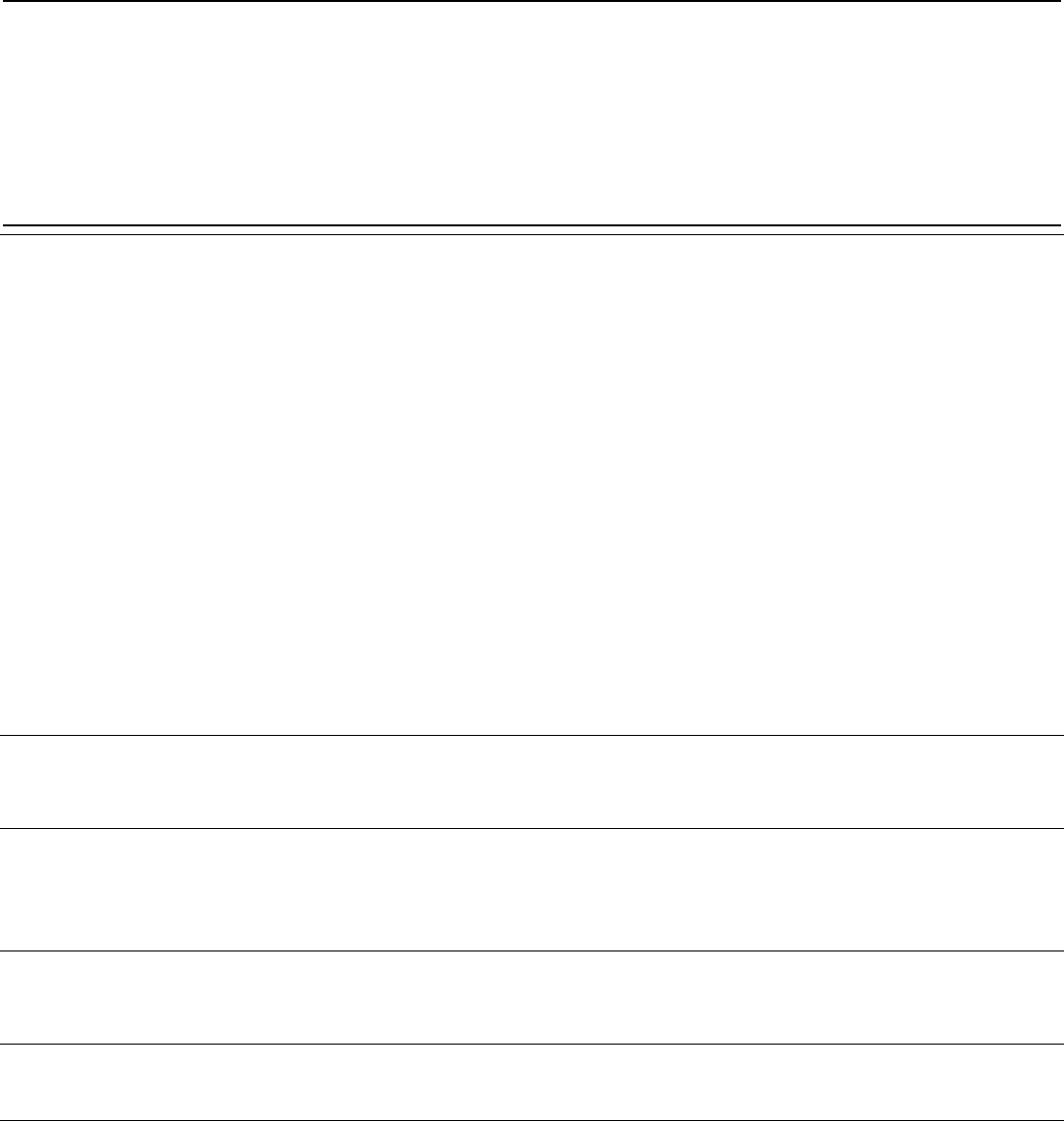
Page i GAO-23-105977 Flood Insurance
Letter 1
Background 4
Risk Rating 2.0 Significantly Improves Ratemaking, but Certain
Aspects of NFIP Limit Actuarial Soundness 12
Risk Rating 2.0 Is Aligning Premiums with Risks, but Some
Policyholders Face Increasing Affordability Concerns 23
Means-Based Assistance Could Address Affordability More
Transparently and Efficiently Than Discounted Premiums 34
Options Exist to Address NFIP’s Legacy Debt and the Potential for
Future Debt 47
Risk Rating 2.0 Has Not Yet Significantly Affected the Private
Insurance Market, but Some NFIP Rules Hinder Market Growth 56
FEMA Has Released Detailed Information on Risk Rating 2.0, but
Has Not Provided It to Policyholders 60
Conclusions 62
Matters for Congressional Consideration 65
Recommendations for Executive Action 66
Agency Comments 67
Appendix I Objectives, Scope, and Methodology 69
Appendix II Additional Data on Glidepath and Means-Based Assistance
Estimates 76
Appendix III Comments from the Department of Homeland Security 78
Appendix IV GAO Contacts and Staff Acknowledgments 84
Tables
Table 1: National Flood Insurance Program (NFIP) Policyholder
Assessments, Surcharges, and Fees 8
Table 2: Estimated Median National Flood Insurance Program
(NFIP) Premiums, by Race and Ethnicity 32
Table 3: Glidepath Time and Premium Shortfall Estimates 76
Contents

Page ii GAO-23-105977 Flood Insurance
Table 4: Estimated Participants and Costs of Alternative Means-
Based Assistance Programs 77
Figures
Figure 1: Policyholder Costs for a Hypothetical National Flood
Insurance Program Policy 10
Figure 2: National Flood Insurance Program (NFIP) Flow of Funds 11
Figure 3: Estimated Future Premium Changes under Risk Rating
2.0, as of December 2022 25
Figure 4: Median Percent Change from Legacy NFIP Premium to
Full-Risk Premium under Risk Rating 2.0, by State, as of
December 31, 2022 27
Figure 5: Median NFIP Premium, by State, as of December 31,
2022 29
Figure 6: Median Full-Risk NFIP Premiums as a Percentage of
Household Income, by State, as of December 31, 2022 31
Figure 7: Affordability of National Flood Insurance Program (NFIP)
Premiums, by Race and Ethnicity 33
Figure 8: Illustration of the Premium Shortfall and Transition to
Full-Risk Premium for a Hypothetical National Flood
Insurance Program Policy 35
Figure 9: Estimated Premium Shortfall and Percentage of National
Flood Insurance Program Policies at Full-Risk Premiums,
by Calendar Year 36
Figure 10: National Flood Insurance Program Policies Remaining
on the Glidepath under Alternative Annual Premium
Increase Caps, by Year 37
Figure 11: Cost Estimates of a Means-Based Assistance
Program—Alternative 1 42
Figure 12: Cost Estimates of a Means-Based Assistance
Program—Alternative 2 43
Figure 13: Number of National Flood Insurance Program Policies,
2019–2022 46
Figure 14: National Flood Insurance Program Annual Year-End
Outstanding Debt to the Department of the Treasury,
Fiscal Years 1995–2022 48
Figure 15: Estimated Effects of Various Requirements for
Repaying National Flood Insurance Program (NFIP) Debt
over 30 Years 52
Figure 16: Private Flood Insurance Share of Flood Insurance
Policies, by Number of Policies 57

Page iii GAO-23-105977 Flood Insurance
Abbreviations
AMI area median income
BISG Bayesian Improved Surname Geocoding
CRS Community Rating System
FEMA Federal Emergency Management Agency
FIRM Flood Insurance Rate Map
HFIAA Homeowner Flood Insurance Affordability Act of 2014
HHI household income
MBA means-based assistance
NAIC National Association of Insurance Commissioners
NFIP National Flood Insurance Program
SFHA special flood hazard area
WYO Write Your Own
This is a work of the U.S. government and is not subject to copyright protection in the
United States. The published product may be reproduced and distributed in its entirety
without further permission from GAO. However, because this work may contain
copyrighted images or other material, permission from the copyright holder may be
necessary if you wish to reproduce this material separately.

Page 1 GAO-23-105977 Flood Insurance
441 G St. N.W.
Washington, DC 20548
July 31, 2023
The Honorable Sherrod Brown
Chairman
The Honorable Tim Scott
Ranking Member
Committee on Banking, Housing, and Urban Affairs
United States Senate
The Honorable Patrick McHenry
Chairman
The Honorable Maxine Waters
Ranking Member
Committee on Financial Services
House of Representatives
The Honorable Bennie G. Thompson
Ranking Member
Committee on Homeland Security
House of Representatives
The Honorable Troy Carter
Ranking Member
Subcommittee on Emergency Management and Technology
Committee on Homeland Security
House of Representatives
The National Flood Insurance Program (NFIP) has competing policy
objectives: being fiscally solvent while keeping flood insurance affordable
for policyholders. Balancing these objectives has been challenging over
the years, and a historical focus on affordability has come at the expense
of solvency. In particular, Congress has required the Federal Emergency
Management Agency (FEMA) to allow many policyholders to pay
discounted premiums that do not fully reflect their properties’ flood risk.
This approach has contributed to a shortfall in revenue and insufficient
funds to pay claims, causing FEMA to borrow about $36.5 billion from the
Letter

Page 2 GAO-23-105977 Flood Insurance
Department of the Treasury since 2005. For these reasons, we placed
NFIP on our High-Risk List in 2006.
1
The ratemaking methodology used until recently by FEMA has
contributed to these challenges.
2
This legacy methodology had become
outdated, as it had remained largely unchanged since NFIP was created
in 1968. To modernize its ratemaking methodology and better align
premiums with underlying flood risk at the individual property level, FEMA
developed a new methodology called Risk Rating 2.0 and began
implementing it in October 2021. Under Risk Rating 2.0, most
policyholders will continue to experience premium increases.
3
While
these increases will help move NFIP toward fiscal solvency and more
accurately signal to homeowners the flood risk of their property, they will
also amplify affordability concerns.
In April 2017, we outlined a road map for comprehensive reform that,
among other things, addresses the trade-offs between solvency and
affordability.
4
Since September 2017, NFIP has been operating under a
series of short-term reauthorizations without comprehensive reform. In
September 2023, NFIP’s current authorization will expire.
We performed our work under the authority of the Comptroller General in
light of congressional interest in FEMA’s new ratemaking methodology
and NFIP’s impending reauthorization. This report examines (1) the
actuarial soundness of the new methodology, (2) how premiums are
changing for policyholders, (3) efforts to make flood insurance affordable
for policyholders, (4) options for addressing program debt, (5) the
potential implications of Risk Rating 2.0 for the private flood insurance
market, and (6) FEMA’s efforts to promote policyholder understanding of
Risk Rating 2.0.
1
GAO, High Risk: Efforts Made to Achieve Progress Need to Be Maintained and
Expanded to Fully Address All Areas, GAO-23-106203 (Washington, D.C.: Apr. 20, 2023).
2
Ratemaking is the process used to determine what prices (premiums) an insurer
charges.
3
Under the previous methodology, policyholders did not experience premium decreases.
However, under Risk Rating 2.0, about 19 percent of policyholders experienced an
immediate decrease in premiums.
4
GAO, Flood Insurance: Comprehensive Reform Could Improve Solvency and Enhance
Resilience, GAO-17-425 (Washington, D.C.: Apr. 27, 2017).

Page 3 GAO-23-105977 Flood Insurance
To examine the actuarial soundness of Risk Rating 2.0, we reviewed
FEMA documentation and actuarial assumptions and methods used to
develop premiums. We also reviewed the premiums, assessments,
surcharges, and fees that policyholders pay and the costs these charges
are designed to cover. Finally, we interviewed FEMA officials and an
actuarial association and compared the methodology and results against
actuarial standards and principles.
To examine how premiums are changing for policyholders, we analyzed
NFIP policy data and Census Bureau data by geography and household
income.
5
We also used a statistical technique to estimate the probability
that NFIP policyholders identify as a particular race or ethnicity and
analyzed premium changes by these factors.
6
To examine efforts to make insurance affordable for policyholders, we
reviewed legislative proposals as well as policy goals established in our
prior work.
7
We analyzed NFIP policy data to estimate the time it might
take for FEMA to transition current policyholders to full-risk premiums and
the continued federal cost until the transition is completed. We accounted
for annual premium increase caps, inflation rates, flood risk, and NFIP
policy renewal, and we analyzed alternate scenarios for each of these
assumptions to determine how our estimates might change. We also
analyzed NFIP policy data and census data to estimate the potential
costs associated with providing means-based affordability assistance for
flood insurance.
To examine options for addressing program debt, we analyzed NFIP
policy data and reviewed our previous work on NFIP, as well as reports
from the Congressional Budget Office, Congressional Research Service,
5
We assessed the reliability of NFIP data we analyzed by reviewing relevant
documentation; testing the data to identify missing data, outliers, and any obvious errors;
and comparing our results to published data. We also interviewed FEMA officials and
reviewed relevant documentation. We determined that the NFIP data we analyzed were
sufficiently reliable for the purposes of our report.
6
We assessed the reliability of these estimates by conducting a literature review on the
accuracy of the technique and by examining the completeness and distributions of the
estimates for NFIP policyholders. We determined that the data were sufficiently reliable for
estimating the race or ethnicity of NFIP policyholders.
7
See GAO-17-425.

Page 4 GAO-23-105977 Flood Insurance
FEMA, and others. We assessed the options against actuarial standards
as well as policy goals we established in prior work.
To examine the potential implications of Risk Rating 2.0 for the private
flood insurance market, we analyzed NFIP policy data and data from the
National Association of Insurance Commissioners (NAIC) on private flood
insurance.
8
We also interviewed private insurers and reviewed laws and
regulations that affect private insurers’ ability to provide flood insurance.
We assessed these laws and regulations against policy goals we
established in prior work.
To examine FEMA’s efforts to promote policyholder understanding of Risk
Rating 2.0, we reviewed NFIP policy documents, FEMA’s web materials,
and training materials for agents and Write Your Own (WYO) insurers.
9
We also interviewed FEMA officials and insurance agent associations.
We compared this information against FEMA’s strategic plan. A more
detailed description of our scope and methodology is included in
appendix I.
We conducted this performance audit from March 2022 to July 2023 in
accordance with generally accepted government auditing standards.
Those standards require that we plan and perform the audit to obtain
sufficient, appropriate evidence to provide a reasonable basis for our
findings and conclusions based on our audit objectives. We believe that
the evidence obtained provides a reasonable basis for our findings and
conclusions based on our audit objectives.
Congress first proposed providing flood insurance in the 1950s, after it
became clear that private insurance companies could not profitably
provide flood coverage. Specifically, limited knowledge of flood risk at the
time made it difficult for insurers to determine accurate premiums. This
uncertainty, combined with the catastrophic nature of flooding, would
have required premiums that many consumers might not have been able
to afford. In 1968, Congress created NFIP to help reduce the escalating
costs of providing federal flood assistance to repair damaged homes and
8
We assessed the reliability of these data by comparing data elements to totals from other
sources. We also interviewed NAIC officials about the accuracy and limitations of the data
and their process for ensuring reliability. We determined that the data were sufficiently
reliable to describe trends in the private flood insurance market.
9
FEMA’s WYO program allows private insurers to sell and service policies and adjust
claims for NFIP.
Background
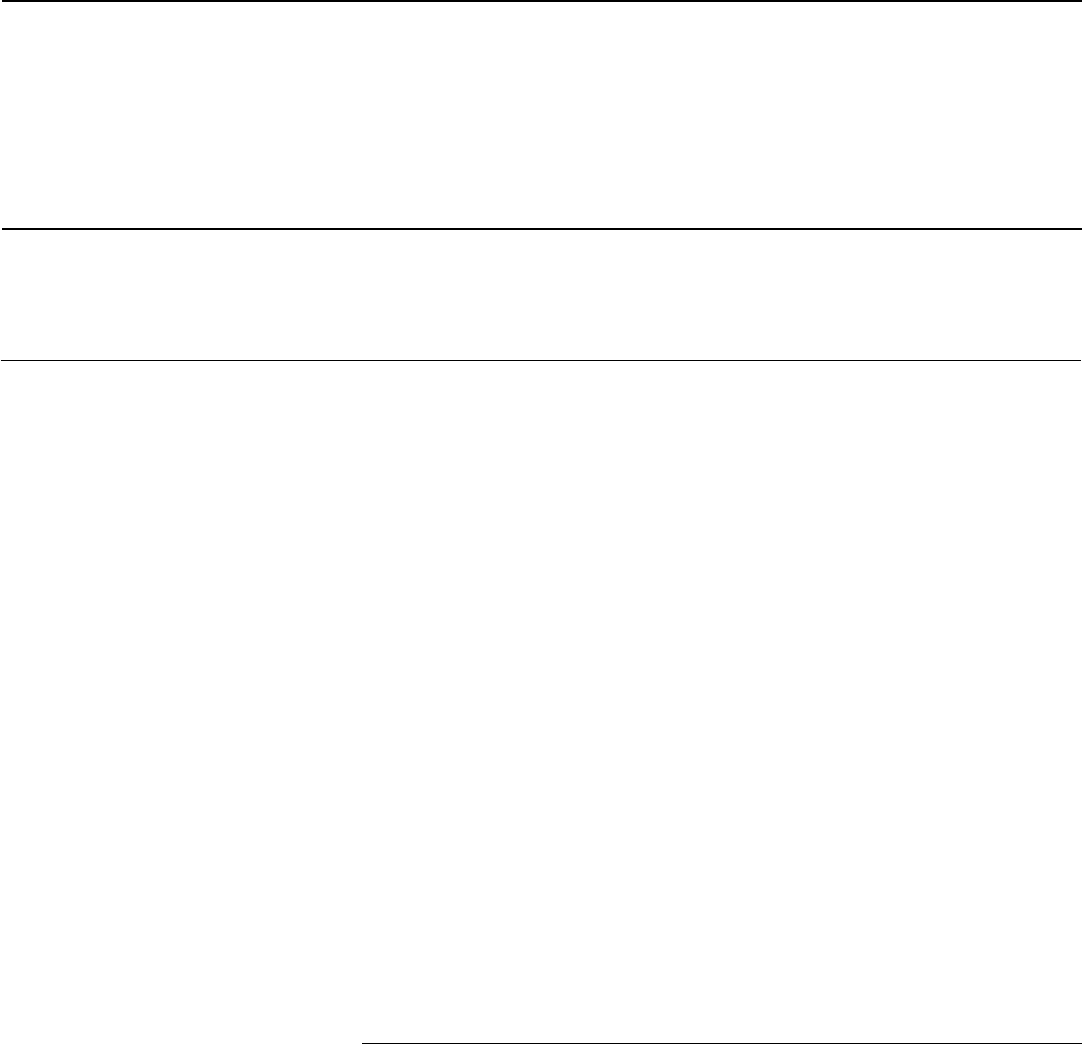
Page 5 GAO-23-105977 Flood Insurance
businesses.
10
NFIP was also intended to address the policy objectives of
identifying flood risk, offering reasonable insurance premiums to
encourage program participation, and promoting community-based
floodplain management.
11
Community participation in NFIP is voluntary. For a community’s
residents to purchase flood insurance through the program, the
community must participate in NFIP.
12
Participation requires communities
to meet certain requirements, including enforcing regulations for land use,
building standards, and new construction in special flood hazard areas
(SFHA).
13
FEMA uses community assistance visits and community
assistance contacts to oversee community enforcement of NFIP
requirements. Community assistance visits are on-site assessments of a
community’s floodplain management program and its knowledge and
understanding of NFIP’s floodplain management requirements.
In 1990, FEMA implemented a voluntary incentive program for
communities participating in NFIP called the Community Rating System
(CRS) to recognize and encourage community floodplain management
activities that exceed the minimum NFIP requirements. According to
FEMA, CRS’s goals are to reduce and avoid flood damage to insurable
property, strengthen and support the insurance aspects of NFIP, and
foster comprehensive floodplain management. Communities may apply to
join CRS if they are in full compliance with the minimum NFIP floodplain
management requirements. FEMA groups CRS communities into classes
based on their ratings. Communities can improve their ratings by earning
CRS credits for activities such as increasing public information about
flood risks, preserving open space, taking steps to mitigate flood damage,
and preparing residents for floods. Policyholders in these communities
10
Pub. L. No. 90-448, Tit. XIII, 82 Stat. 476, 572 (1968).
11
On June 1, 2023, 10 states and multiple local jurisdictions filed a lawsuit in the Eastern
District of Louisiana against FEMA alleging, among other claims, that Risk Rating 2.0 is
inconsistent with the objective of making flood insurance available when necessary at
reasonable rates and that the agency’s actions violated legal requirements of notice and
comment rulemaking. Louisiana, et. al. v. Mayorkas, Case No. 2:23-cv-01839 (E.D. La.
June 1, 2023). We do not address this lawsuit or any legal authorities discussed in the
lawsuit in this report.
12
As of May 2023, FEMA had identified 24,767 communities across the United States. Of
these, 22,621 (91 percent) participated in NFIP.
13
SFHAs are land areas that would be submerged by the floodwaters of the “base flood”—
a flood that has a 1 percent chance of being equaled or exceeded in any given year.
Community Participation,
WYO Program, and
Purchase Requirements

Page 6 GAO-23-105977 Flood Insurance
receive a discount on their flood insurance premiums ranging from 5 to 45
percent, depending on the community’s rating.
Consumers can purchase NFIP policies from a licensed property and
casualty agent. Most agents sell policies underwritten through FEMA’s
WYO program, which allows private insurers to sell and service policies
and adjust claims for NFIP. To become a WYO insurer, private insurers
enter into an arrangement with FEMA to issue flood policies in their own
name. The insurers must have experience in property and casualty
insurance lines, be in good standing with state insurance departments,
and be capable of selling and servicing the policies. WYO insurers do not
assume any risk, and they receive an expense allowance for their
services (currently about 30 percent of the premium a policyholder pays).
Agents can also contract directly with FEMA to sell NFIP policies under
the agency’s NFIP Direct program.
14
Consumers pay the same premium,
regardless of how they purchase their policy.
Generally, homeowners with federally backed mortgages in SFHAs have
been required by law to purchase flood insurance since 1973.
15
As part of
its role in administering NFIP, FEMA develops floodplain maps—
historically known as Flood Insurance Rate Maps (FIRM)—that provide
the basis for identifying which properties are required to purchase flood
insurance by delineating the boundaries of SFHAs.
16
Properties located in
these areas that have certain federally backed mortgages are subject to
the mandatory purchase requirement for flood insurance.
In October 2021, FEMA began implementing a new methodology for
calculating flood insurance premiums, known as Risk Rating 2.0.
Beginning on October 1, 2021, all new NFIP policyholders were required
to pay the full-risk premium determined using Risk Rating 2.0, and all
renewing policyholders were able to opt into Risk Rating 2.0 if it lowered
14
As of January 2020, approximately 88 percent of NFIP policies were sold by companies
participating in the WYO program, and 12 percent of policies were sold through the NFIP
Direct Servicing Agent.
15
42 U.S.C § 4012a. Federally backed mortgages are those made, insured, or guaranteed
by federally regulated lenders or federal agencies, or purchased by the government-
sponsored enterprises for housing—Fannie Mae and Freddie Mac.
16
FEMA floodplain maps also serve as the basis for local floodplain management
standards that communities must adopt and enforce as part of their NFIP participation.
Prior to Risk Rating 2.0, FEMA also used its floodplain maps to set premiums.
Risk Rating 2.0 and
Authority for Premium
Increases

Page 7 GAO-23-105977 Flood Insurance
their premium.
17
Beginning on April 1, 2022, all NFIP policyholders
became subject to the new methodology as their policies were renewed,
so that as of April 1, 2023, all NFIP policies were subject to Risk Rating
2.0.
18
Under the legacy methodology, some properties (also known as “pre-
FIRM” properties) paid discounted “subsidized” premiums if they were
built before floodplain maps for their area were published and flood risk in
those locations was properly understood. Other policies paid discounted
“grandfathered” premiums when a new flood map placed them into a
flood zone that would have increased their premiums; these properties’
premiums continued to be based on the previous, lower-risk flood zone.
Premium increases for renewing NFIP policies are generally limited by
statute.
19
For most policies, FEMA is prohibited from increasing premiums
by more than 18 percent per year.
20
FEMA is also required by law to
increase premiums by 25 percent per year for certain other policies until
they reach full risk, such as those covering pre-FIRM secondary
residences, businesses, and severe repetitive loss properties.
21
FEMA is
to increase premiums from 5 to 15 percent per year for certain other
policies, including those covering properties that were built before flood
maps were available for their area.
17
FEMA refers to its premiums that encompass all of the elements of the individual risk
transfer as full-risk premiums.
18
NFIP policies generally have a 1-year term. We refer to annual premium amounts that
reflect the policy term.
19
42 U.S.C. § 4015(e).
20
FEMA also is prohibited from increasing premiums for certain groups of policies with the
same flood risk classification by more than 15 percent per year on average. Such groups
include properties that were built before flood maps were available for their area and
properties that pay discounted premiums because they were newly mapped into an SFHA
on or after April 1, 2015, if the applicant gets flood insurance coverage within a year of the
mapping.
21
A severe repetitive loss property is an NFIP-insured structure that has incurred flood-
related damage for which (a) four or more separate claims have been paid that exceeded
$5,000 each and cumulatively exceeded $20,000, or (b) at least two separate claim
payments have been made under such coverage, with the cumulative amount of such
claims exceeding the fair market value of the insured structure. 42 U.S.C. § 4104c(h); 42
U.S.C. § 4014(h).

Page 8 GAO-23-105977 Flood Insurance
FEMA generally pays claims and funds its operations from premium
revenue from policyholders. In addition to paying for flood claims and
adjustment expenses, FEMA uses premium revenue to pay other costs,
including WYO expense allowances, interest on debt, operating
expenses, and mitigation grants.
FEMA offers coverage to homeowners, renters, and businesses for
buildings and their contents.
22
In addition to premiums for building and
contents coverage, NFIP policyholders pay separate assessments,
surcharges, and fees (see table 1).
Table 1: National Flood Insurance Program (NFIP) Policyholder Assessments, Surcharges, and Fees
Charge
Authority
Purpose
Amount
FEMA authority
Reserve fund
assessment
Biggert-Waters Flood
Insurance Reform Act of
2012 (codified as
amended at 42 U.S.C. §
4017a)
Establish and maintain a
reserve fund to cover
future claim and debt
expenses, especially
those from catastrophic
disasters
18% of current premium
per policy starting on
April 1, 2020 (previously
15% since April 2016)
The Federal Emergency
Management Agency
(FEMA) has limited
authority to determine the
amount (statute specifies
a reserve fund target and
minimum annual
payments into the fund
until the target is
reached).
Homeowner
Flood Insurance
Affordability Act
surcharge
Homeowner Flood
Insurance Affordability
Act of 2014 (codified at
42 U.S.C. § 4015a)
Offset the cost of
discounted premiums
$25 for primary
residences; $250 for all
other properties
FEMA has no authority to
determine the amount or
eliminate the surcharge
before statutory
requirements for full-risk
premiums are generally
universally met—that is,
nearly all NFIP policies
must be at full-risk, with
some exceptions.
Federal Policy
Fee
Omnibus Budget
Reconciliation Act of
1990 (codified as
amended at 42 U.S.C. §
4014 (a)(1)(B)(iii))
Pay for administrative
expenses incurred in
carrying out flood
insurance and floodplain
mapping activities
$47 for all policies under
Risk Rating 2.0
(previously $50 and $25,
depending on policy type,
since October 2017)
FEMA has certain
authority to determine the
amount.
Source: GAO. | GAO-23-105977
22
NFIP’s maximum coverage limit for one-to-four-family residential policies is $250,000 for
buildings and $100,000 for contents. For nonresidential policies, the maximum coverage
limit is $500,000 per building and $500,000 for the building owner’s contents. NFIP
policies offer a variety of deductible options. Renters can purchase contents-only
coverage. FEMA also offers Increased Cost of Compliance coverage, which provides up
to $30,000 to help cover the cost of mitigation measures following a flood loss when a
property is declared to be substantially or repetitively damaged.
NFIP Funding Structure
and Flow of Funds

Page 9 GAO-23-105977 Flood Insurance
Note: In addition to premiums, which are based on risk, NFIP policyholders pay separate
assessments, surcharges, and fees.
For example, a hypothetical single-family primary residence had been
paying an annual premium of $1,017 prior to Risk Rating 2.0. Under Risk
Rating 2.0, FEMA determined that this hypothetical policyholder should
be paying $2,200 to reflect the full risk of loss of the insured property.
Because this policy is subject to an 18 percent statutory cap on annual
premium increases, in the first year FEMA can only raise the premium by
18 percent, from $1,017 to $1,200. Therefore, in the first year of Risk
Rating 2.0, the policyholder receives a $1,000 discount relative to the full-
risk premium of $2,200. The policyholder then pays $288 in additional
assessments, surcharges, and fees, bringing the total payment to $1,488.
The premium will increase each year, subject to the statutory caps, until
the full-risk premium is reached. Figure 1 illustrates the costs for this
hypothetical policyholder in the first year under Risk Rating 2.0.
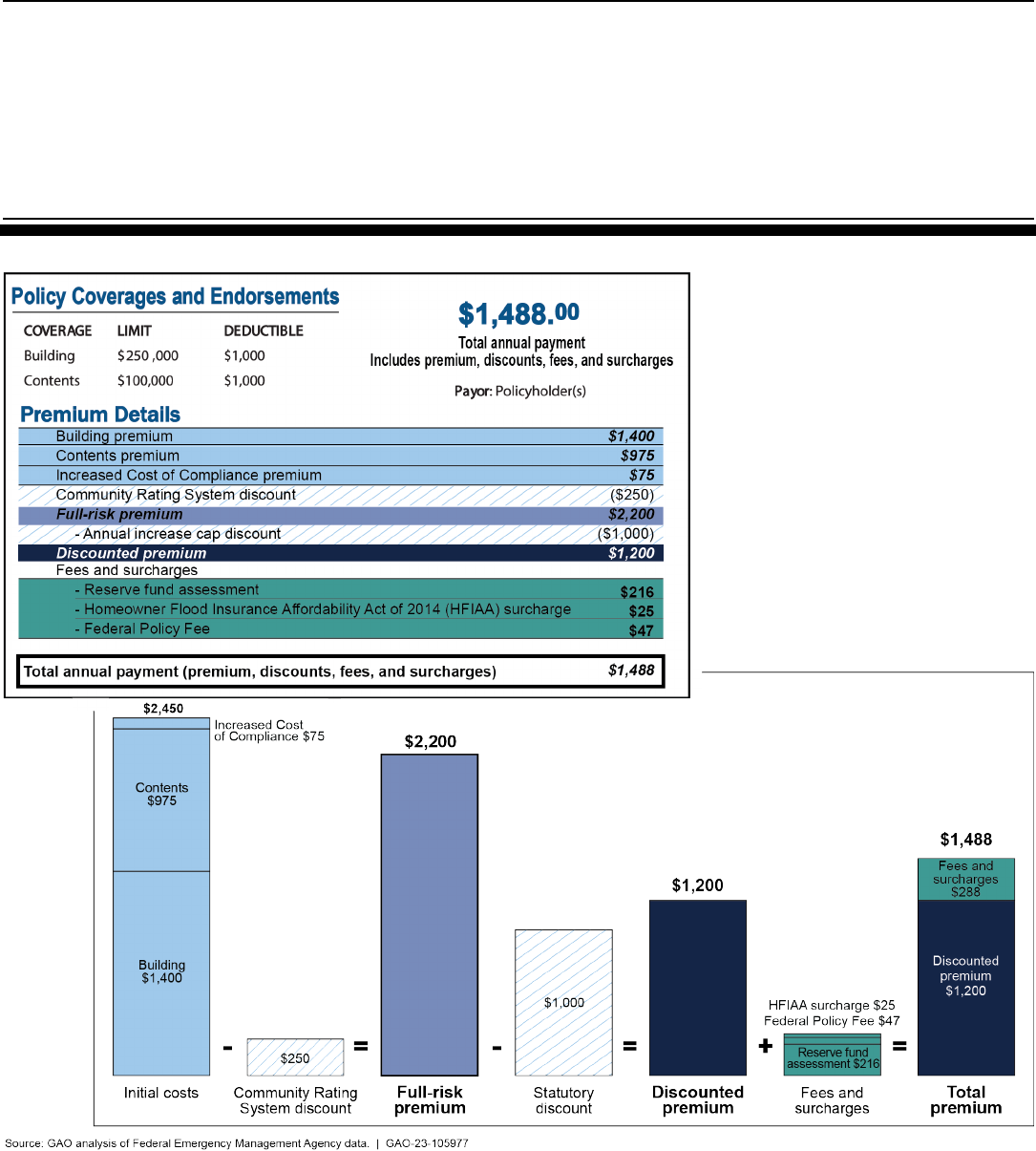
Page 10 GAO-23-105977 Flood Insurance
Figure 1: Policyholder Costs for a Hypothetical National Flood Insurance Program Policy
FEMA also has reinsurance agreements and borrowing authority from
Treasury to fulfill its obligations. Collections are deposited into an
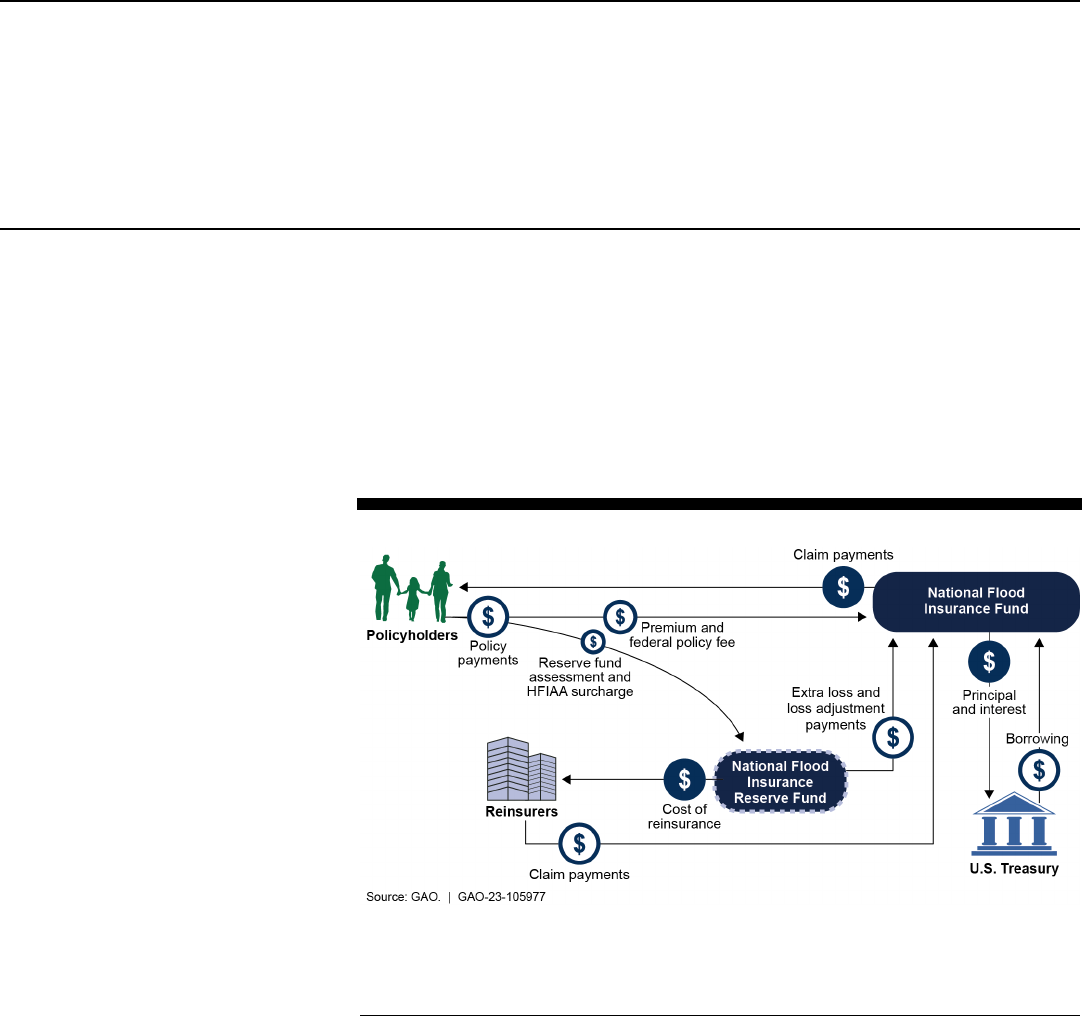
Page 11 GAO-23-105977 Flood Insurance
insurance fund, and some are transferred to a reserve fund (see fig. 2).
23
In most years, NFIP premium revenue is sufficient to pay claims and
generate a cash surplus. In years when losses exceed premium revenue,
FEMA uses any amounts in these funds to pay claims, first from the
insurance fund and then, if necessary, from the reserve fund. When
individual or accumulated losses in a year exceed a certain threshold,
FEMA can receive payouts from its reinsurance agreements. When
revenue, reinsurance, and any accumulated surplus are insufficient,
FEMA has authority to borrow from the Treasury.
24
Figure 2: National Flood Insurance Program (NFIP) Flow of Funds
Note: All policyholder payments are deposited into the National Flood Insurance Fund, but the
reserve fund assessment and Homeowner Flood Insurance Affordability Act (HFIAA) surcharge are
transferred into the National Flood Insurance Reserve Fund.
23
The National Flood Insurance Fund was established in the U.S. Treasury by the
National Flood Insurance Act of 1968. The National Flood Insurance Reserve Fund was
established by the Biggert-Waters Flood Insurance Reform Act of 2012 to help meet future
NFIP obligations and principal and interest payments on any outstanding Treasury loans
(42 U.S.C. § 4017a). Specifically, FEMA is required to establish a reserve fund with a
balance equal to 1 percent of the sum of the total potential loss exposure of all
outstanding flood insurance policies in force in the prior fiscal year. FEMA’s total exposure
in fiscal year 2022 was $1.28 trillion, which equates to a target reserve fund balance of
$12.8 billion for fiscal year 2022. FEMA is required to contribute at least 7.5 percent of its
target balance each year until it achieves the target reserve fund balance. This equates to
a reserve fund contribution of $960 million for fiscal year 2022.
24
42 U.S.C. § 4016. Congress authorized FEMA to borrow from the Treasury when
needed, up to a preset statutory limit. Originally, Congress authorized a borrowing limit of
$1 billion and increased it significantly in 2005 and 2013. The limit currently stands at
$30.425 billion.

Page 12 GAO-23-105977 Flood Insurance
In developing Risk Rating 2.0, FEMA applied actuarial principles to better
align premiums with flood risk, representing a substantial improvement
from its legacy ratemaking methodology. The methodology and process
FEMA used to develop full-risk premiums in Risk Rating 2.0 generally
reflect statutory premium requirements and relevant actuarial principles
and standards.
25
According to FEMA, Risk Rating 2.0 was the first change in its ratemaking
methodology since the 1970s. The legacy methodology had become out
of date for several key reasons, including that it largely based premiums
on a property’s height relative to the base flood elevation and broadly
defined flood zone and charged the same premium nationwide based on
these characteristics.
26
The legacy rating methodology also did not
capture many potential flood sources or reflect flood risk from
catastrophic events. We previously identified a number of challenges with
this ratemaking process.
27
25
42 U.S.C. § 4014(a). Casualty Actuarial Society, Statement of Principles Regarding
Property and Casualty Ratemaking (Arlington, Va.: May 7, 2021). The Actuarial Standards
Board’s relevant Actuarial Standards of Practice include 12 (Risk Classification for All
Practice Areas); 23 (Data Quality); 25 (Credibility Procedures); 29 (Expense Provisions in
Property/Casualty Insurance Ratemaking); 30 (Treatment of Profit and Contingency
Provisions and the Cost of Capital in Property/Casualty Insurance Ratemaking); 38
(Catastrophe Modeling); 39 (Treatment of Catastrophe Losses in Property/Casualty
Insurance Ratemaking); 53 (Estimating Future Costs for Prospective Property/Casualty
Risk Transfer and Risk Retention); and 56 (Modeling).
26
Under the legacy methodology, SFHAs included two categories of flood zones: A (high-
risk noncoastal) and V (high-risk coastal). Non-SFHAs generally included three
categories: B, C, and X (low to moderate risk).
27
See GAO, National Flood Insurance Program: Continued Progress Needed to Fully
Address Prior GAO Recommendations on Rate-Setting Methods, GAO-16-59
(Washington, D.C.: Mar. 17, 2016) and Flood Insurance: FEMA’s Rate-Setting Process
Warrants Attention, GAO-09-12 (Washington, D.C.: Oct. 31, 2008).
Risk Rating 2.0
Significantly Improves
Ratemaking, but
Certain Aspects of
NFIP Limit Actuarial
Soundness
With Risk Rating 2.0,
FEMA Improved
Ratemaking by Applying
Actuarial Principles

Page 13 GAO-23-105977 Flood Insurance
Under Risk Rating 2.0, FEMA better aligns premiums with flood risk and
takes advantage of new technology and advances in the insurance
industry’s understanding of flood risk. For instance, Risk Rating 2.0 does
the following:
• Ties premiums to individual property flood risk rather than to
broadly defined flood zones. Premiums under the legacy
methodology relied heavily on a structure’s flood zone as depicted on
FEMA’s floodplain maps.
28
Structures within each flood zone
generally were rated similarly, meaning that while properties may
have had different premiums because of other variables (e.g.,
occupancy type and elevation), the premium did not vary based on
the property’s particular geographic location within the zone. Risk
Rating 2.0 calculates premiums based on the characteristics of each
individual insured structure and no longer uses the flood zone.
• Integrates input from commercial catastrophe models.
Catastrophe models are computerized processes that simulate
potential losses due to catastrophic events, such as floods.
29
Their
use has become standard practice in the insurance industry since
they were first developed in the 1980s. The models have evolved
significantly as technology has advanced and exposure data have
improved. Under Risk Rating 2.0, FEMA uses catastrophe models to
estimate the annual losses from potential flood events.
• Accounts for more sources of flooding. The previous methodology
accounted only for coastal and riverine flooding, but Risk Rating 2.0
also includes pluvial (rainfall), Great Lakes, coastal erosion, and
tsunami flooding.
• Accounts for the replacement cost value of the property. NFIP
residential coverage is generally limited to $250,000. Although the
legacy methodology did not adjust premiums based on the value of
the insured property, insured homes with values above the $250,000
limit still affected NFIP’s risk exposure. For example, $250,000 in
coverage was priced the same for a $250,000 home as for a $5
million home. However, this approach was inequitable because the
same flooding event is likely to cause more damage to a higher-value
structure. For example, $250,000 in damage to a $250,000 home—a
28
FEMA floodplain maps are the official maps of communities on which FEMA has
delineated the SFHA and base flood elevations applicable to the community.
29
Actuarial standards of practice define a catastrophe model as a model of low-frequency
events with high-severity or widespread potential effects. Catastrophe models may be
used to explain a system, to study effects of different components, or to derive estimates.

Page 14 GAO-23-105977 Flood Insurance
total destruction of home value—would occur only with an infrequent
severe flood event. In contrast, $250,000 of damage to a $5 million
home—a destruction of just 5 percent of home value—could occur
with far less severe and more frequent flood events. As a result, the
$5 million home has a much higher probability of incurring $250,000 in
damage than does a $250,000 home, and should have a higher
premium. By not accounting for this difference in probabilities, the
legacy rating methodology tended to undercharge homes that are
more expensive and overcharge homes that are more modest. By
incorporating replacement cost value into its ratemaking, Risk Rating
2.0 more accurately accounts for differences in flood risk from
properties of different values.
In its Risk Rating 2.0 ratemaking process, FEMA incorporates the
damage or loss estimates of multiple catastrophe models, which include
commercial models as well as FEMA models that use data from other
government agencies, including the U.S. Army Corps of Engineers.
These models do not produce suggested premium rates, but FEMA uses
the output of these models in its ratemaking process. According to FEMA,
the agency makes use of multiple catastrophe models because, although
each model has its own strengths, no single model adequately covers all
circumstances. For example, FEMA uses data from the U.S. Army Corps
of Engineers to model damage and losses in areas behind levees, and it
uses data from the National Oceanic and Atmospheric Administration and
other agencies to model coastal flooding. Catastrophe models, including
those used by FEMA, are generally based on simulations and thus
involve some amount of uncertainty.
NFIP is statutorily required to develop premiums that are actuarially
sound.
30
According to actuarial principles, an actuarially sound premium
is an estimate of the expected value of future costs of the individual risk
transfer.
31
These expected costs include insurance claims, claims-related
30
42 U.S.C. § 4014(a).
31
Casualty Actuarial Society, Statement of Principles. Further, the Actuarial Standards
Board sets standards for appropriate actuarial practice in the United States through the
development and promulgation of Actuarial Standards of Practice, which describe the
procedures an actuary should follow when performing actuarial services and identify what
the actuary should disclose when communicating the results of those services. According
to Actuarial Standard of Practice 1, “actuarial soundness” has different meanings in
different contexts and might be dictated or imposed by an outside entity. In rendering
actuarial services, if the actuary identifies a process or result as “actuarially sound,” the
actuary should define the meaning of “actuarially sound” in that context.

Page 15 GAO-23-105977 Flood Insurance
expenses, commissions, operational expenses, reinsurance costs, and a
provision for retained risk.
32
Actuarial principles also state that an
actuarially sound premium should be reasonable and should not be
excessive, inadequate, or unfairly discriminatory. In developing Risk
Rating 2.0, FEMA followed the statutory definition of actuarial rates and
followed recognized actuarial principles and actuarial standards of
practice.
33
FEMA refers to its premiums that encompass all of the
elements of the individual risk transfer as full-risk premiums.
The process of ratemaking under Risk Rating 2.0 included three core
components: creating market baskets representative of single-family
homes, estimating NFIP’s aggregate target premium, and allocating
individual premiums to policyholders. Creating market baskets involved
grouping U.S. single-family homes with several of the same risk factors
using geographic information system data and commercially available
data.
34
FEMA incorporated the market baskets into catastrophe models
from several vendors and modeled NFIP’s flood risk using policy data as
of May 31, 2018. According to FEMA officials, they updated their
assumptions using data as of May 31, 2020.
FEMA then developed NFIP’s aggregate target premium—the total
premium for the entire program—using the average annual losses
generated from the catastrophe models, as well as provisions for WYO
expense allowances, loss adjustment expenses, and the net cost of
reinsurance and retained risk.
FEMA then used the aggregate target premium to determine individual
policyholder premiums based on the risk factors of their insured
properties and the potential flood sources. FEMA used rating variables,
32
Reinsurance is insurance for insurers. The net cost of reinsurance includes the excess
of reinsurance premiums paid to the reinsurer over recoveries for claims from the
reinsurer. Retained risk is the exposure that an insurer chooses to cover itself rather than
transferring it to a third party, such as a reinsurer, and includes the risk of random
variation from expected costs plus the risk of systematic underestimation of expected
costs. In private-sector contexts, a provision for risk is also referred to as a cost of capital.
33
The statutory definition of an actuarial rate is one that covers all costs, as prescribed by
principles and standards of practice in ratemaking adopted by the American Academy of
Actuaries and the Casualty Actuarial Society, including an estimate of the expected value
of future costs, all costs associated with the transfer of risk, and the costs associated with
an individual risk transfer with respect to risk classes, as defined by FEMA. 42 U.S.C. §
4014 (a)(1)(B)(iv).
34
Data sources included the U.S. Geological Survey, the National Oceanic and
Atmospheric Administration, and the U.S. Army Corps of Engineers.

Page 16 GAO-23-105977 Flood Insurance
which are characteristics that have been shown through analysis to
correlate with the likelihood of losses. When developing rating factors,
FEMA compared the annual expected losses derived from the
catastrophe models to NFIP’s historical losses from January 1, 1992, to
June 30, 2018, and adjusted accordingly. Specifically, FEMA compared a
range of modeled losses for each market basket of properties to the
historical losses experienced by actual policies within that market basket
to verify whether the historical losses fell into the model’s estimated
range.
FEMA performed a rating factor analysis by peril separately for single-
family homes not protected by a levee, single-family homes protected by
a levee, and non-single-family homes.
35
FEMA’s analyses identified a set
of rating factors that reflect several characteristics:
• location (including distance to flooding sources and elevation relative
to flooding sources);
• structural characteristics (including occupancy type, foundation type,
first floor height, number of floors, construction type, existence of flood
openings, and location of machinery and equipment); and
• replacement cost value, coverage, and deductible amounts.
All of these rating factors combined allow FEMA to group policyholders
with similar risks together to help determine the full-risk premium. FEMA
officials told us they plan to review and update premiums to continue
using the best available data, science, and models. They also plan to
account for changes in other factors, such as flood risk and their
understanding of it, as well as changes in inflation, expenses, fees, and
policyholder population.
In addition to premiums, NFIP policyholders pay separate charges that
are determined outside of the actuarial ratemaking process. These
additional charges are not proportional to the individual risk of the insured
property and result in some policyholders being charged more than the
actuarial cost of the risk transfer.
35
Risk Rating 2.0 accounts for the level of risk reduction that levees provide to the
buildings located behind them. Levees reduce flood risk but do not eliminate it. According
to FEMA, limitations of levees include their capacity to reduce flooding in leveed areas
(from overtopping) and their ability to perform adequately during flood events, and this
information is fundamental in assessing the risk.
Some Additional
Policyholder Charges Limit
Actuarial Soundness

Page 17 GAO-23-105977 Flood Insurance
• Reserve fund assessment. FEMA is statutorily required to establish
and maintain a reserve fund to provide additional funds to cover future
claims and debt expenses, especially those from catastrophic
disasters. Specifically, FEMA must move toward a target balance of 1
percent of insurance-in-force by making minimum annual
contributions of 7.5 percent of the target balance until the fund
reaches the target.
36
FEMA does so by implementing a reserve fund
assessment, which FEMA has set at 18 percent of the premium since
2020.
37
FEMA applies the reserve fund assessment to the discounted
premium rather than the full-risk premium. As a result, the
assessment is not proportional to the actual risk of the property.
38
FEMA officials told us that they view the reserve fund assessment as
a capitalization charge that is separate from the full-risk premium.
However, FEMA also includes in its full-risk premium a risk load for
the risk of future catastrophic losses, in accordance with actuarial
principles. As a result, the statutorily required reserve fund
assessment results in policyholders paying a charge for catastrophic
losses in two places, and being at risk of overpaying the cost of risk
transfer, especially policyholders paying full-risk premiums.
39
• Homeowner Flood Insurance Affordability Act (HFIAA)
surcharge. The HFIAA surcharge, which was statutorily established
and offsets the cost of discounted premiums, is set at $25 for primary
residences and $250 for other properties. Because the HFIAA
surcharge is a flat amount, it is not tied to the risk of the individual
36
42 U.S.C. § 4017a(b)(1),(d)(1).
37
FEMA initially set the reserve fund assessment at 5 percent but increased it to 15
percent in April 2016 and 18 percent in April 2020.
38
For example, a policyholder who pays a full-risk premium would pay a higher reserve
fund assessment than a policyholder with the same risk who pays a discounted premium.
39
FEMA is required to develop rates based on actuarial principles and in consideration of
risk to include operating and administrative expenses. 42 U.S.C. § 4014. This includes a
risk load for catastrophic losses, according to FEMA officials. Further, FEMA officials
stated that Risk Rating 2.0 includes this catastrophic load in the premium and that this
premium must be deposited into the National Flood Insurance Fund. Additionally, FEMA is
generally required by statute to increase premiums to fund the reserve fund to meet the
target or reserve ratio for the year. 42 U.S.C. § 4017a. FEMA officials stated that the
reserve fund assessment should not be viewed as an actuarial charge, but as a
congressional mandate. Additionally, FEMA officials stated that the reserve fund
assessment is subject to the aggregate annual premium increase cap of 18 percent a
year. According to FEMA, due to this constraint, policyholders who are paying their full-
risk rate will be charged the full reserve fund assessment, while those policyholders
receiving a premium increase discount will not pay the full reserve fund assessment.
Additionally, all premium increases to build up the reserve fund must be deposited into the
reserve fund. 42 U.S.C. § 4017a.

Page 18 GAO-23-105977 Flood Insurance
property, and while the $25 surcharge for primary residences is
relatively small, the $250 surcharge for other properties is not. In
addition, while the HFIAA surcharge offsets the cost of discounted
premiums, it is charged to all policyholders, including those already
paying the full-risk premium, so that these policyholders are partially
subsidizing policyholders paying discounted premiums. The amount of
the HFIAA surcharge is set in statute, so FEMA lacks the authority to
eliminate or reduce it until statutory requirements for full-risk
premiums are generally universally met—that is, nearly all NFIP
policies must be at full-risk, with some exceptions.
Because the full-risk premium covers the full cost of the risk transfer,
including a risk load, policyholders paying the full-risk premium plus the
reserve fund assessment and the additional HFIAA surcharge are paying
more than the actuarially determined cost of insurance. Moreover, the
size and duration of the reserve fund assessment will vary with claims
experience. For example, if the reserve fund is used to help pay claims in
a catastrophic loss year, the reserve fund assessment might need to be
increased, extended, or reinstated to reach the target balance. This would
result in current or future policyholders paying for past losses, in violation
of actuarial principles.
To the extent that the reserve fund assessment and HFIAA surcharge are
not proportional to the individual risk of the insured property or result in
policyholders paying more than an actuarially justified cost of the risk
transfer, the total costs a policyholder pays will not be actuarially sound.
Specifically, FEMA cannot ensure that the amounts charged align with the
flood risk of specific properties, which limits the ability of these charges to
accurately signal flood risk and results in some policyholders overpaying
and others potentially underpaying. Were Congress to authorize and
require FEMA to incorporate the reserve fund assessment, to the extent
necessary based on actuarial principles, into the risk charge within the
full-risk premium, it would enhance the actuarial soundness of the total
costs policyholders pay. Further, were Congress to repeal the HFIAA
surcharge and authorize and require FEMA to replace forgone revenue
with actuarially determined premium adjustments, it would enhance the
actuarial soundness of the total costs policyholders pay.
Premium discounts provided under the CRS program are not actuarially
justified and are paid for, in large part, through a cross-subsidization by
policyholders not receiving the discount. As previously discussed, FEMA
uses premium discounts ranging from 5 to 45 percent to promote CRS
program goals: to reduce and avoid flood damage to insurable property,
CRS Discounts Are Not
Actuarially Justified

Page 19 GAO-23-105977 Flood Insurance
to strengthen and support the insurance aspects of NFIP, and to foster
comprehensive floodplain management.
40
As a community engages in
additional eligible activities, its residents become eligible for larger
premium discounts.
FEMA officials told us they set full-risk premiums so that after applying
the CRS discounts, the total premium revenue within each state
represents the full aggregate risk of all policies in that state. This
approach results in a cross-subsidy because policyholders outside of
CRS communities are paying higher premiums than are actuarially
justified to subsidize the discounts that policyholders in participating CRS
communities receive.
Further, it is likely that policyholders receiving the CRS discount are
paying lower premiums that do not fully reflect their flood risk. The
amounts of CRS discounts—both to individual properties and program-
wide—are not closely linked to potential loss reduction of currently
insured properties. While the activities that FEMA promotes through CRS
are important, few of them directly mitigate flood risk in the policy
period.
41
FEMA officials told us that CRS helps improve future resilience
to flood risk but does little to reduce the estimated flood losses of the
properties NFIP currently insures.
42
For example, four eligible activities
reduce potential flood damage: floodplain management planning,
acquisition and relocation, flood protection, and drainage system
maintenance.
43
However, CRS provides discounts for 15 other activities
related to public information, mapping and regulations, and warning and
response that do not reduce the potential for flood damage to currently
40
As of May 2023, 22,621 communities participated in NFIP. As of April 2023, 1,504 NFIP
communities received a CRS discount, and 454 received a discount of at least 20 percent.
41
Until October 2021, discounts were available only to properties in SFHAs, but under
Risk Rating 2.0, FEMA provides discounts to all policies in a participating community.
42
Broadly speaking, resilience is the ability to prepare and plan for, absorb, recover from,
and more successfully adapt to actual or potential adverse events.
43
FEMA defines floodplain management planning as the adoption of flood hazard
mitigation or natural functions plans using the CRS planning process, or conducting
repetitive loss area analyses. Acquisition and relocation refer to acquiring insurable
buildings and relocating them out of the floodplain and leaving the property as open
space. Flood protection of the insured building includes activities such as floodproofing,
elevation, or minor structural projects. Drainage system maintenance includes annual
inspections of channels and retention basins and maintenance of the drainage system’s
flood-carrying and storage capacity

Page 20 GAO-23-105977 Flood Insurance
insured properties.
44
While we recognize the value of such activities, it is
not actuarially justifiable to incentivize them through premium discounts or
through overcharging policyholders outside of CRS communities. FEMA
has not evaluated the actuarial benefits of these other activities in terms
of loss mitigation or other means of incentivizing them.
In addition, FEMA officials stated that some of the rating variables used in
Risk Rating 2.0 already account for the reduced flood risk that results
from certain CRS activities in calculating full-risk premiums. For example,
one rating variable is a property’s elevation height in relation to flood
sources. Elevating properties is one activity a community could undertake
to receive a CRS discount. As a result, some properties could receive
lower premiums because they are elevated and also receive a CRS
discount for being located in a community that is working to elevate
properties. At the same time, nonelevated properties in the community
would still receive the CRS discount without having received any risk-
reduction benefit from the community’s activities.
Actuarial principles suggest that the amount of premium discount should
align with the amount of loss reduction for each individual property.
Further, while statute requires FEMA to apply CRS discounts, it does not
prescribe the amount of the discounts or the specific community activities
FEMA should use to determine them.
45
Rather, it says that FEMA should
provide CRS discounts based on the estimated reduction in flood risk
from the measures adopted by the community.
If FEMA does not adjust CRS ratings so that only community activities
that can be actuarially justified to reduce flood risk contribute toward a
community’s rating and does not incorporate discounts into the full-risk
premium based on the actuarial evaluation of risk reduction, then
premiums will not be actuarially sound, and policyholders will continue
over- or underpaying premiums. Further, by evaluating other means of
incentivizing desirable community-wide activities that cannot be
44
Public information activity categories include elevation certificates, map information
service, outreach projects, hazard disclosure, flood protection information, flood protection
assistance, and flood insurance promotion. Mapping and regulations activity categories
include floodplain mapping, open space preservation, higher regulatory standards, flood
data maintenance, and stormwater management. Warning and response activity
categories include flood warning and response, levees, and dams.
45
42 U.S.C. § 4022(b).

Page 21 GAO-23-105977 Flood Insurance
actuarially justified, FEMA could help ensure such activities continue if
they are no longer incentivized through CRS discounts.
Implementing Risk Rating 2.0 is helping FEMA to address NFIP’s
historical premium inadequacy and overall actuarial soundness, but
Congress and the public do not have certain information on the new
methodology and NFIP’s long-term fiscal outlook.
FEMA has communicated Risk Rating 2.0’s actuarial soundness and
NFIP’s fiscal outlook to Congress through three primary means:
• Legislative reform proposals. In May 2022, the Department of
Homeland Security submitted to Congress 17 legislative proposals
that included establishing a “Sound Financial Framework.”
46
According to FEMA, the framework would call for NFIP to pay all
claims for a flood event that has a 5 percent chance of being
exceeded in any given year—about $10.5 billion, similar to claims
from Hurricane Harvey in 2017. Congressional action on an
emergency supplemental appropriation would be needed only if
claims exceeded this amount. FEMA said this framework would
require the implementation of several reforms.
47
FEMA estimated the
framework would result in a 75 percent likelihood that NFIP could
manage flood events up to the established ceiling and have a positive
balance in its available funds at the end of a 10-year period.
• Budget request. In its 2024 budget request, FEMA estimated the
budgetary effects of its proposed reforms for establishing the
framework.
48
FEMA also requested an equalization payment to cover
what it estimated to be the cost of premium discounts in fiscal year
2024.
46
Department of Homeland Security, Legislative Reform Package (Washington, D.C.: May
11, 2022).
47
To achieve the Sound Financial Framework, FEMA proposed (1) canceling the existing
debt, (2) eliminating interest on future debt, (3) decreasing NFIP’s borrowing authority
from $30.425 billion to two-thirds of total expected premiums in force in the following fiscal
year, (4) directing annual equalization payments to cover premium shortfalls from
discounted premiums, (5) allowing the ability to transfer funds between the insurance and
reserve funds, (6) eliminating the Reserve Fund Ratio, and (7) eliminating the HFIAA
surcharge.
48
Office of Management and Budget, Budget of the U.S. Government, Fiscal Year 2024—
Department of Homeland Security (Washington, D.C.: Mar. 9, 2023).
FEMA Has Not Fully
Reported on Risk Rating
2.0’s Actuarial Soundness
and Its Effect on NFIP’s
Fiscal Exposure

Page 22 GAO-23-105977 Flood Insurance
• Debt report to Congress. In August 2022, FEMA submitted to
Congress a report on NFIP’s debt as of March 2022.
49
The report
communicated the uncertainty of flood losses, NFIP’s estimated
annual losses for a 10-year period, and projections of NFIP’s debt and
financial position over this period.
In addition to these reports, FEMA posted on its website a report from its
actuarial contractor that describes the actuarial modeling and data
sources used in developing Risk Rating 2.0 premium rates.
These communications provide important information on NFIP, but
Congress and the public lack some information because these
communications are fragmented and incomplete. For example, FEMA’s
Sound Financial Framework communicates NFIP’s estimated capacity if it
were to receive annual equalization payments for the cost of premium
discounts and if its other requested reforms were implemented. However,
FEMA did not estimate NFIP’s current capacity (absent these reforms) or
estimate its future capacity for either scenario. The framework also does
not include a plan to regularly update these estimates. Further, FEMA has
designed full-risk premiums under Risk Rating 2.0 based on an estimated
average annual loss target but has not incorporated this estimate into
these communications. Moreover, while FEMA estimated premium
revenue and shortfalls for a 10-year period when preparing its budget
request, the actual budget request only included the estimates for 2024.
In addition, the 10-year projections in FEMA’s budget request and debt
report included a single baseline scenario rather than a range of
scenarios that would illustrate the uncertainty of NFIP’s future financial
condition.
One of FEMA’s strategic objectives is empowering risk-informed decision-
making, and FEMA’s strategic plan states that the availability of, access
to, and understanding of future conditions data and modeling within
FEMA must be expanded.
50
In this regard, a comprehensive annual
actuarial report could help better inform Congress and the public about
49
Department of Homeland Security, National Flood Insurance Program Semi-Annual
Debt Repayment Report, March 31, 2022 (Washington, D.C.: Aug. 30, 2022).
50
Federal Emergency Management Agency, 2022–2026 FEMA Strategic Plan: Building
the FEMA Our Nation Needs and Deserves (Washington, D.C.: 2021).

Page 23 GAO-23-105977 Flood Insurance
Risk Rating 2.0’s actuarial soundness and NFIP’s fiscal outlook.
51
Ensuring that such a report is informed by relevant actuarial standards
would enhance its usefulness and credibility.
52
Elements of a comprehensive annual actuarial report could include
communicating the accuracy and adequacy of NFIP’s premiums in
managing the program’s fiscal exposure. The report could also
communicate the target loss level that full-risk premiums are designed to
cover, the uncertainty associated with the full-risk premium, and the
likelihood that the estimated premium revenue will cover the target loss
for the policy year. Further, the report could evaluate and communicate
estimated premium revenue and shortfall, the likelihood of additional
Treasury borrowing, and NFIP’s short- and long-term fiscal outlook under
a variety of scenarios for future claims experience and policy renewals,
lapses, and new policies. Without a comprehensive annual actuarial
report on Risk Rating 2.0’s soundness and NFIP’s fiscal outlook, available
information for overseeing the program will continue to be fragmented
and incomplete.
As noted earlier, a key goal of Risk Rating 2.0 is to more closely align
premiums with individual property flood risk. Because legacy premiums
on many policies do not fully reflect the underlying flood risk, aligning
51
Examples of comprehensive annual reports for other programs that involve actuarial
assessments of risk include the annual trustees’ reports for Social Security and Medicare
and the annual projections report produced by the Pension Benefit Guaranty Corporation.
52
For more information, see, for example, Actuarial Standards of Practice 41 (Actuarial
Communications), 46 (Risk Evaluation in Enterprise Risk Management), 47 (Risk
Treatment in Enterprise Risk Management), and 56 (Modeling).
Risk Rating 2.0 Is
Aligning Premiums
with Risks, but Some
Policyholders Face
Increasing
Affordability Concerns
Premiums Are Increasing
for Many Policies but Will
Better Reflect Flood Risk

Page 24 GAO-23-105977 Flood Insurance
premiums with risks will require premium increases on most policies.
53
As
of December 2022, NFIP policyholders paid a median annual premium of
$689.
54
However, the median annual full-risk premium was $1,288.
55
As a
result, the median premium will need to increase by almost 90 percent to
reach full risk.
56
However, different policies will require different premium changes to align
them with actual risk and reach full-risk premiums. For example, 35
percent of policies will require an increase of less than 100 percent, while
about 9 percent will require an increase of 300 percent or more (see fig.
3). Overall, about 66 percent of policies still required premium increases
as of December 2022. In September 2021, under the legacy
methodology, FEMA considered about 22 percent of its policies to be
paying premiums that were less than full risk.
57
In contrast, the fact that
66 percent of policies are paying less than full-risk premiums under Risk
53
As discussed previously, NFIP policyholders pay premiums, which are based on risk, as
well as separate assessments, surcharges, and fees. In this section, we analyzed the
entire amount a policyholder pays, including building premium, contents premium,
Increased Cost of Compliance premium, severe repetitive loss premium, reserve fund
assessment, HFIAA surcharge, Federal Policy Fee, and probation surcharge. CRS
discounts, when applicable, are also reflected. For simplicity and clarity, in this section we
refer to the total policyholder payments as “premiums.”
54
For condominiums, NFIP offers a Residential Condominium Building Association Policy,
which covers all units within a condominium. As a result, it is necessary to adjust for the
number of condominium units to determine the number of policies. We account for the
number of condominium units when reporting the aggregate number of NFIP policies, but
otherwise we treat these condominium policies as single policies.
55
FEMA determined full-risk premiums for policies subject to Risk Rating 2.0, which
includes new policies beginning October 1, 2021, and renewed policies beginning April 1,
2022. We analyzed NFIP data for policies in effect on December 31, 2022, which included
full-risk premiums that were valid as of that date for 89 percent of NFIP policies. Our
analysis excludes the remaining policies, which were due for renewal from January 1,
2023, to March 31, 2023, because FEMA had not yet determined their full-risk premiums.
Full-risk premiums are FEMA’s best estimates of the premium that would need to be
charged to cover the estimated cost of the risk transfer and associated expenses for the
year FEMA determined them. As noted earlier, FEMA officials told us they will modify
premiums as input factors change (such as housing values and flood risk) and as they
continue to improve their understanding of flood risk.
56
FEMA’s estimates of full-risk rates reflect current WYO expense allowances (about 30
percent of the premium a policyholder pays). As premiums increase with implementation
of Risk Rating 2.0, the amount of expense allowance per policy will increase. Any changes
to the compensation structure would affect the calculation of full-risk rates.
57
Under the legacy methodology, subsidized and grandfathered premiums were
considered less than full risk.
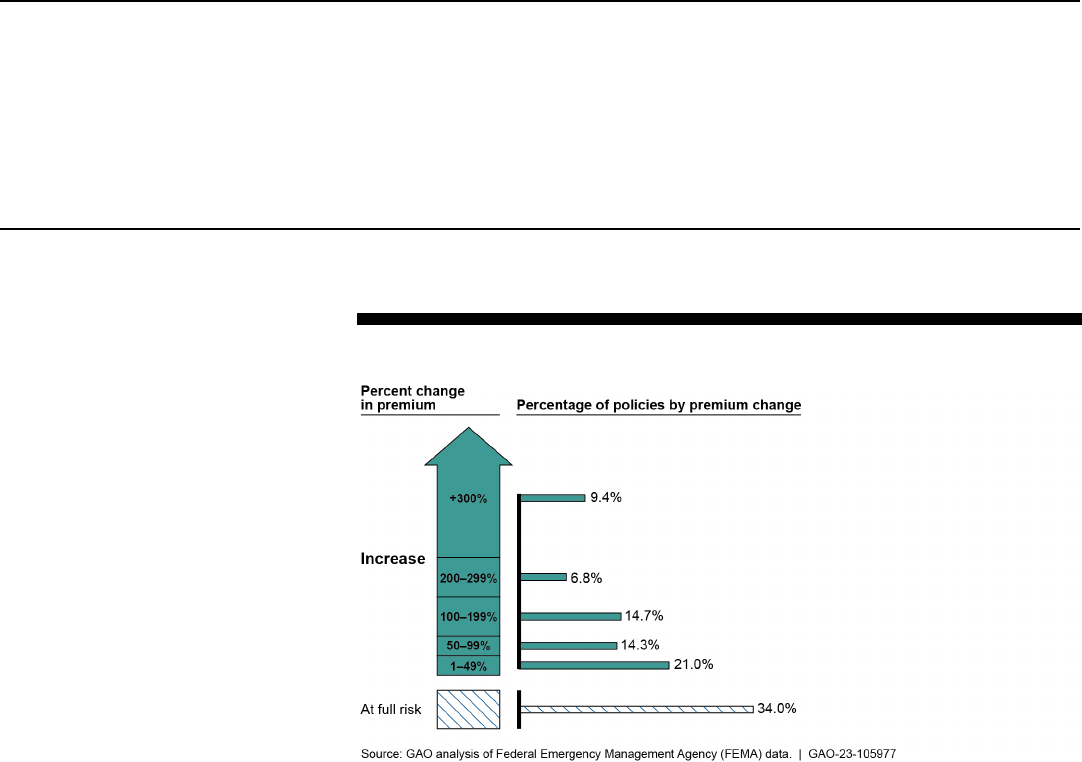
Page 25 GAO-23-105977 Flood Insurance
Rating 2.0 indicates that the legacy system significantly underestimated
flood risk and that Risk Rating 2.0 is correcting this underpricing.
Figure 3: Estimated Future Premium Changes under Risk Rating 2.0, as of
December 2022
Note: This analysis includes the 89 percent of policies subject to Risk Rating 2.0 and in effect on
December 31, 2022. The remaining 11 percent of policies were due for renewal from January 1,
2023, to March 31, 2023, at which point FEMA determined their full-risk premiums. About 19 percent
of policies in effect on September 30, 2021, received premium decreases under Risk Rating 2.0. The
“at full risk” category includes these policies; new policies, most of which were subject to full-risk
premiums; and policies that reached full-risk premiums upon renewal because the required increase
was less than the statutory cap on annual premium increases for those policies.
While FEMA is increasing premiums for most policies, it has reduced
premiums on about 19 percent of policies, which indicates that FEMA has
determined that the anticipated cost of insuring these properties is lower
than it had previously determined. According to FEMA, many of these
properties have lower replacement cost value, and by accounting for it,
Risk Rating 2.0 is able to offer a lower premium. FEMA is implementing
the full amount of these premium decreases immediately upon policy
renewal, whereas it must phase in premium increases, often over many
years, as required by law.
FEMA had been increasing premiums for a number of years prior to
implementing Risk Rating 2.0. In implementing previous reforms, FEMA
increased premiums by an average of 6 to 11 percent in each year from
2015 to 2021. Under the previous methodology, FEMA was unable to

Page 26 GAO-23-105977 Flood Insurance
calculate full-risk premiums for many of its policies.
58
Even if FEMA had
not implemented Risk Rating 2.0, it would still have had the authority to
increase most premiums by 18 percent annually until it determined it had
collected enough to pay for expected losses in the aggregate. However,
FEMA would not have known if it was charging a full-risk premium for any
individual property. Because Risk Rating 2.0 allows FEMA to calculate
full-risk premiums for all policies, FEMA can determine when each policy
no longer requires an annual increase to reach full risk. By better aligning
premiums with flood risks, Risk Rating 2.0 provides an actuarial
justification for these premium increases and helps reduce NFIP’s net
cost to the federal government—that is, the government’s fiscal exposure.
To align premiums with flood risk, premium increases, on average, will be
greater in some states than in others. Policies requiring the highest
premium increases under Risk Rating 2.0 are also those that were
previously the most heavily underpriced. For example, all five Gulf Coast
states—Alabama, Florida, Louisiana, Mississippi, and Texas—are in the
highest premium increase group (see fig. 4). With high premium
increases skewed toward Gulf Coast states where flood risk is higher and
most (61 percent) of NFIP’s policies are concentrated, Risk Rating 2.0 is
correcting a geographical pricing imbalance and addressing a historical
source of fiscal exposure.
58
Under the legacy methodology, FEMA required elevation certificates to determine
premiums for full-risk policies. However, it generally did not require elevation certificates
for subsidized policies because it did not use elevation information for determining
subsidized premiums. Because FEMA lacked elevation for these policies, it was not able
to calculate their full-risk rates. See GAO, Flood Insurance: More Information Needed on
Subsidized Properties, GAO-13-607 (Washington, D.C.: July 3, 2013).
Gulf Coast States Are
among Those Most
Underpriced and
Requiring the Largest
Premium Increases
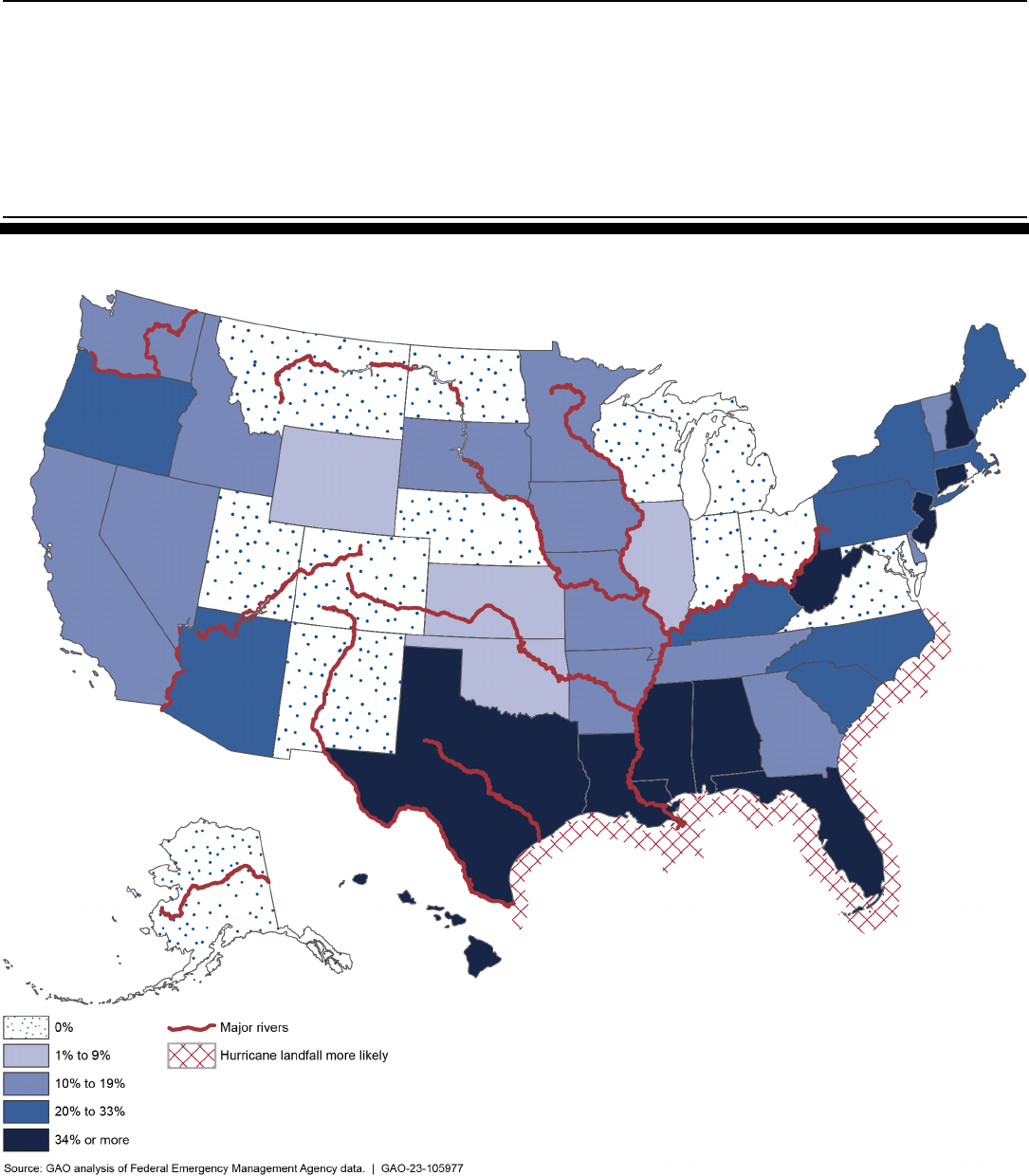
Page 27 GAO-23-105977 Flood Insurance
Figure 4: Median Percent Change from Legacy NFIP Premium to Full-Risk Premium under Risk Rating 2.0, by State, as of
December 31, 2022
Legend: NFIP = National Flood Insurance Program
The five non-Gulf Coast states experiencing high premium increases—
Connecticut, Hawaii, New Hampshire, New Jersey, and West Virginia—
account for 5 percent of NFIP policies. For more detailed information on

Page 28 GAO-23-105977 Flood Insurance
premiums as of December 31, 2022, and full-risk premiums, percent
change, and affordability, see the interactive graphic available at
http://www.gao.gov/products/gao-23-105977.
Further, many of the states with the lowest premiums as of December 31,
2022, are those with higher flood risk, further indicating historical
underpricing and explaining the premium increases under Risk Rating
2.0. As discussed previously, many policies have not yet reached their
full-risk premiums under Risk Rating 2.0. For example, nearly every
southeastern coastal state is in the group of states with the lowest median
premiums as of December 31, 2022 (see fig. 5). However, these are also
among the states with the highest risk of hurricane and coastal flooding
combined, and they have historically accounted for a majority of NFIP
claims.
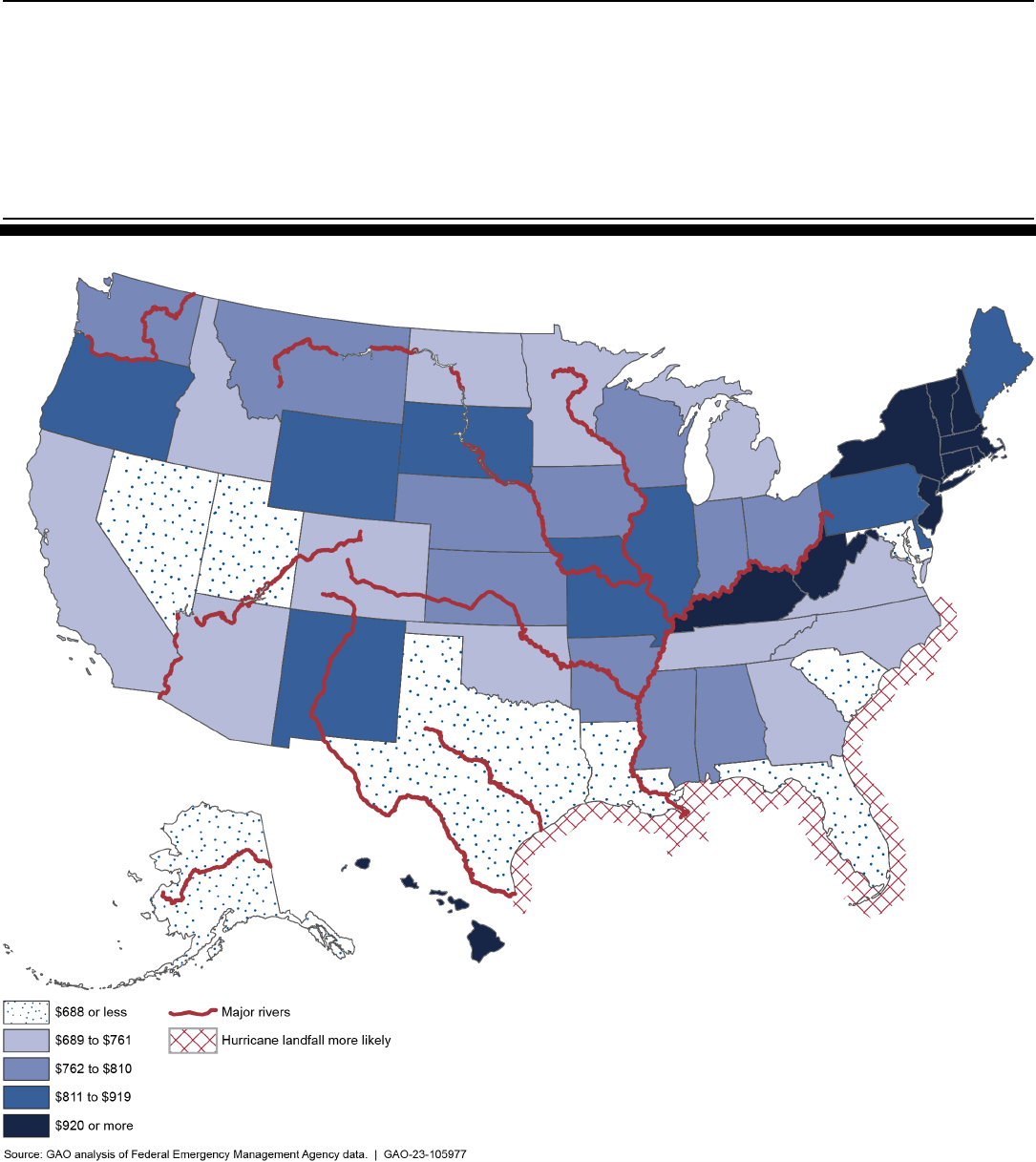
Page 29 GAO-23-105977 Flood Insurance
Figure 5: Median NFIP Premium, by State, as of December 31, 2022
Legend: NFIP = National Flood Insurance Program

Page 30 GAO-23-105977 Flood Insurance
Affordability concerns are growing as NFIP premiums continue to
increase over time until reaching full-risk premiums. We estimated the
affordability of each NFIP policy by expressing the full-risk premium as a
percentage of the median household income of the census tract in which
the insured property is located.
59
We then calculated the median
percentage in each state. Under Risk Rating 2.0, the median percentage
of household income represented by the full-risk premium will exceed 1
percent in 45 states and will equal or exceed 2 percent in 10 states (see
fig. 6). Some proposals for means-based assistance for flood insurance
use a certain percentage of household income or area median income as
thresholds for determining policyholder eligibility for assistance. Most
policyholders in a number of states—particularly along the Gulf of Mexico,
throughout Appalachia, and into the Northeast—likely will exceed these
thresholds as FEMA continues transitioning to full-risk premiums.
In addition to creating affordability concerns, increasing premiums also
have the potential to negatively affect property values and the associated
property tax revenues. For example, for properties located in areas where
homeowners must purchase flood insurance, an increase in required
annual expenses could decrease the purchase price potential buyers
could afford. Lower property values could then lead to lower property tax
revenues. However, flood insurance is not required on a majority of
properties, and not all property owners will be affected similarly by an
increase in a single cost component of owning a home. As a result, our
analysis focuses on affordability as a whole rather than changes in
property value.
59
To estimate the household income of each policyholder, we used the median household
income of the census tract in which the insured property is located, according to the
Census Bureau’s American Community Survey. We calculated affordability for all primary
residential, noncondominium policies for which full-risk rates were available. FEMA
research indicates that policyholder incomes are higher than nonpolicyholder incomes,
which means that current policies may be more affordable than we report here. Federal
Emergency Management Agency, An Affordability Framework for the National Flood
Insurance Program (Washington, D.C.: Apr. 17, 2018), 11.
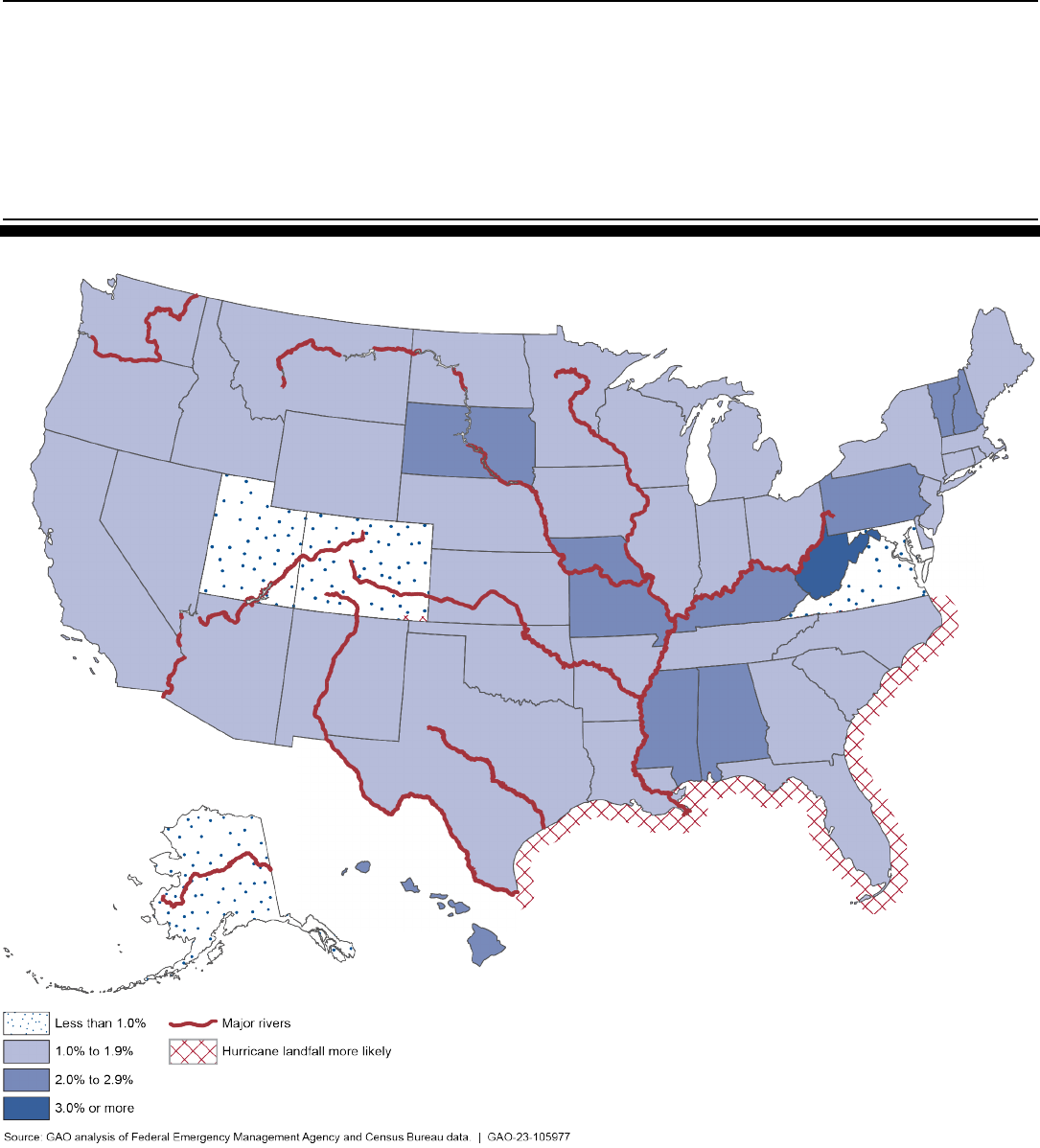
Page 31 GAO-23-105977 Flood Insurance
Figure 6: Median Full-Risk NFIP Premiums as a Percentage of Household Income, by State, as of December 31, 2022
Legend: NFIP = National Flood Insurance Program
Note: This analysis assumes the household income of NFIP policyholders is equal to the median
income of the census tract where the insured property is located, according to the Census Bureau’s
American Community Survey. It includes all primary residential, noncondominium policies for which
full-risk premiums were available as of December 31, 2022.
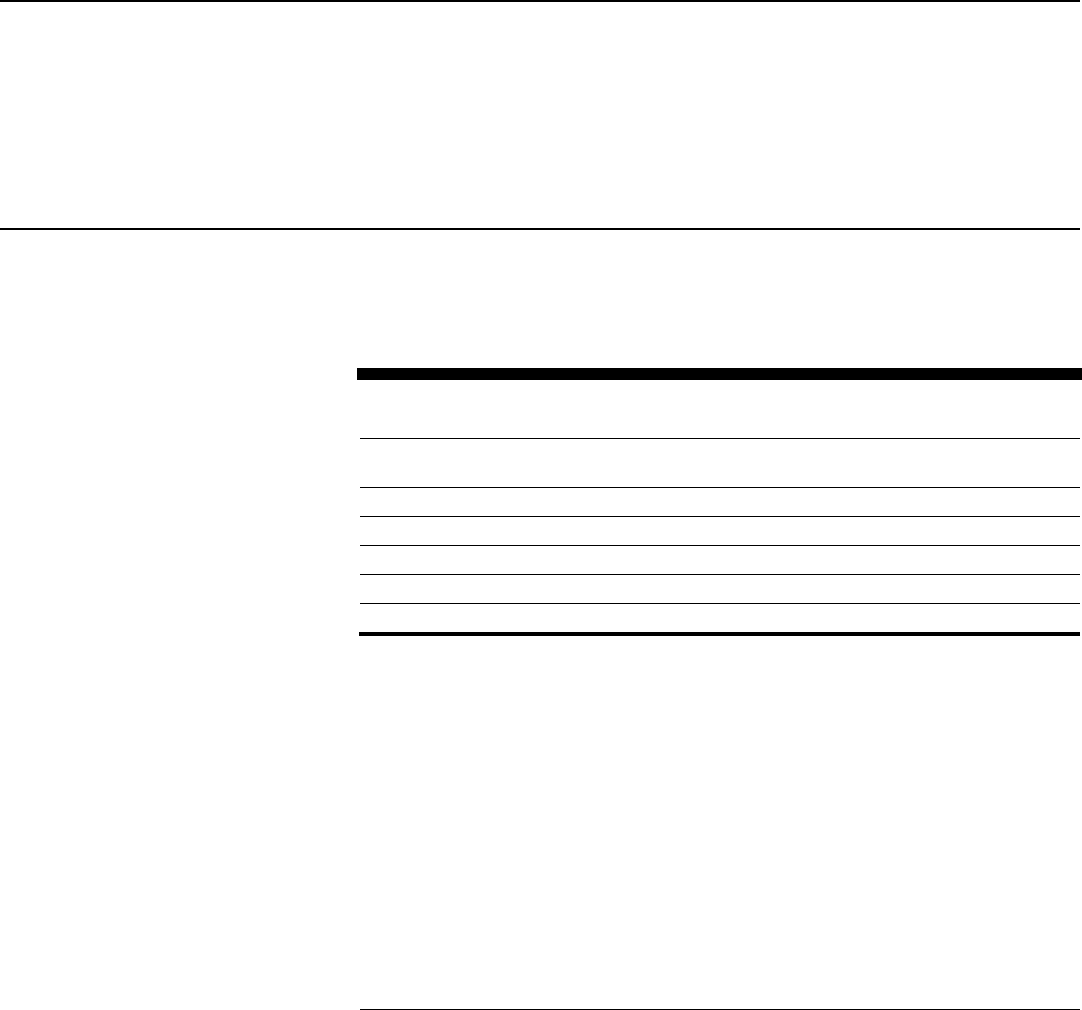
Page 32 GAO-23-105977 Flood Insurance
Under Risk Rating 2.0, premiums and changes in premiums are relatively
similar by race and ethnicity, but affordability varies.
60
Full-risk premiums
generally will increase for all races and ethnicities we analyzed (see table
2).
61
Table 2: Estimated Median National Flood Insurance Program (NFIP) Premiums, by
Race and Ethnicity
Racial/ethnic group
Premium as of
December 31, 2022
Full-risk
premium
Percent difference
in medians
All policies
$688
$1,282
86%
Black or African American
$687
$1,281
86%
White
$689
$1,281
86%
Hispanic or Latino
$664
$1,288
94%
Asian
$688
$1,295
88%
Source: GAO analysis of Federal Emergency Management Agency and Census Bureau data. | GAO-23-105977
Note: This analysis estimates the race and ethnicity of NFIP policyholders using the Bayesian
Improved Surname Geocoding method. Full-risk premiums are for policies that have renewed under
Risk Rating 2.0 as of December 31, 2022.
For Black policyholders, however, the premium paid as of December 31,
2022, constitutes a higher percentage of their estimated household
income than all other racial and ethnic groups, and their full-risk
premiums are expected to do so once fully implemented (see fig. 7). This
is because the median household income of Black policyholders is
estimated to be lower than that of policyholders of other races and
60
In this report, we use the term “Black” to refer to “Black or African American” and
“Hispanic” to refer to “Hispanic or Latino.”
61
We used the Bayesian Improved Surname Geocoding (BISG) method to predict the race
and ethnicity for policyholders of residential, noncondominium NFIP policies, based on
their surname and residential location. Several studies have validated BISG estimates
against self-reported racial data collected through administrative or survey sources in the
health care and financial sectors. BISG makes estimates by calculating the probability that
a person with a given surname and residential location will identify with selected racial and
ethnic groups based on data from the Census Bureau. For other reports in which we have
used this methodology, see GAO, Tax Equity: Enhanced Evaluation Could Improve
Outreach to Small Business Owners, GAO-22-104582 (Washington, D.C.: Aug. 3, 2022)
and Social Security Administration: Remote Service Delivery Increased during COVID-19,
but More Could Be Done to Assist Vulnerable Populations, GAO-23-104650 (Washington,
D.C.: Nov. 17, 2022). For more details on our methodology, see app. I.
Premium Increases Are
Similar by Race and
Ethnicity, but Less
Affordable for Black
Policyholders
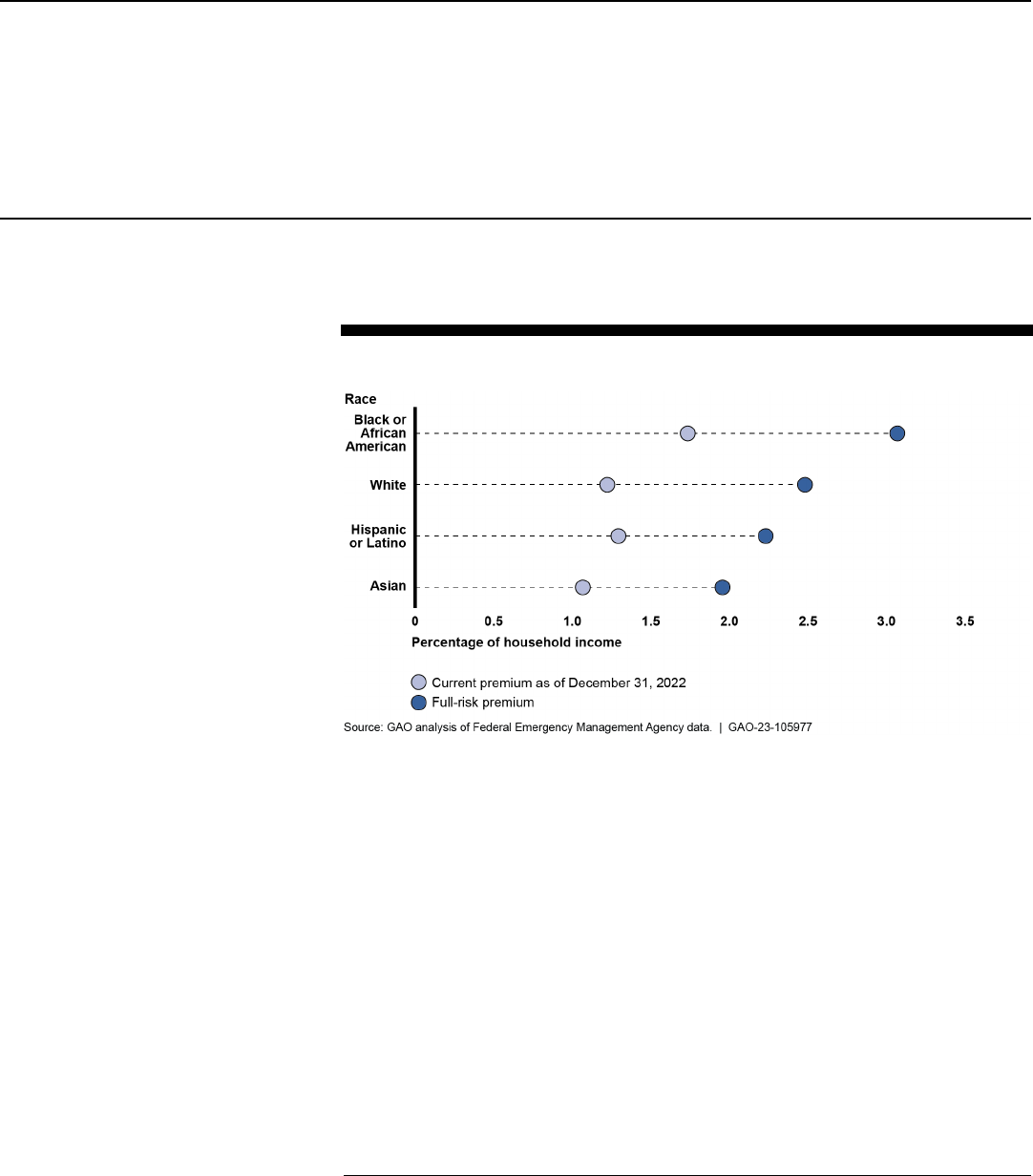
Page 33 GAO-23-105977 Flood Insurance
ethnicities.
62
Asian and Hispanic policyholders, on average, will pay
slightly lower percentages of their incomes for flood insurance than White
and Black policyholders as FEMA transitions to full-risk premiums.
Figure 7: Affordability of National Flood Insurance Program (NFIP) Premiums, by
Race and Ethnicity
Note: This analysis assumes that the household income of NFIP policyholders is equal to the median
income of the census tract where the insured property is located, according to the Census Bureau’s
American Community Survey. It estimates race and ethnicity of policyholders using the Bayesian
Improved Surname Geocoding method.
62
We estimated the household income of policyholders using the median household
income of the policyholder’s census tract, according to the 2019 5-year estimate of the
Census Bureau’s American Community Survey. Using this method, we estimate that Black
NFIP policyholders have a median income of $54,676, compared with $81,605 for all
policyholders.

Page 34 GAO-23-105977 Flood Insurance
To address affordability concerns, Congress has capped annual premium
increases on NFIP policies, requiring FEMA to transition from discounted
to full-risk premiums gradually.
63
We refer to the period of a policy’s
transition to its full-risk premium as a “glidepath.” Because policies on a
glidepath pay discounted rather than full-risk premiums, they cause a
shortfall in NFIP premium revenue, which is equal to the difference
between the full-risk premium and the premium actually paid. For
example, a hypothetical NFIP policy currently paying a $500 premium
with an estimated full-risk premium of $1,000 and subject to an 18
percent annual premium increase cap would have a premium shortfall of
$351 (net of WYO expenses) in the first year and would reach its full-risk
premium in 2028 (see fig. 8). This policy would have incurred a total
shortfall of $1,477 in its 6 years on the glidepath.
64
63
42 U.S.C. § 4015(e). Policies are subject to annual rate increase caps ranging from 5 to
25 percent until they reach their full-risk rates. About 85 percent of policies, including
those for most primary residences, are subject to an 18 percent cap. The transition will
take multiple years for policyholders whose increase necessary to reach full risk exceeds
the statutorily allowed 1-year increase. We use “discounted” to refer to premiums that are
not yet full risk and therefore result in a premium shortfall. As discussed previously, other
statutory discounts exist, such as CRS discounts. FEMA plans to review full-risk premiums
annually, and these premiums include many rating factors. As these factors change, the
full-risk premium is likely to change to reflect FEMA’s most current understanding of flood
risk. It also is possible that events may occur that change the models’ loss estimates more
significantly.
64
The total premium shortfall is net of WYO expenses. The total premium shortfall before
WYO expenses is $2,121.
Means-Based
Assistance Could
Address Affordability
More Transparently
and Efficiently Than
Discounted Premiums
Statutory Caps Address
Affordability by Slowing
the Transition to Full-Risk
Premiums, but Allow
Significant Revenue
Shortfalls to Continue
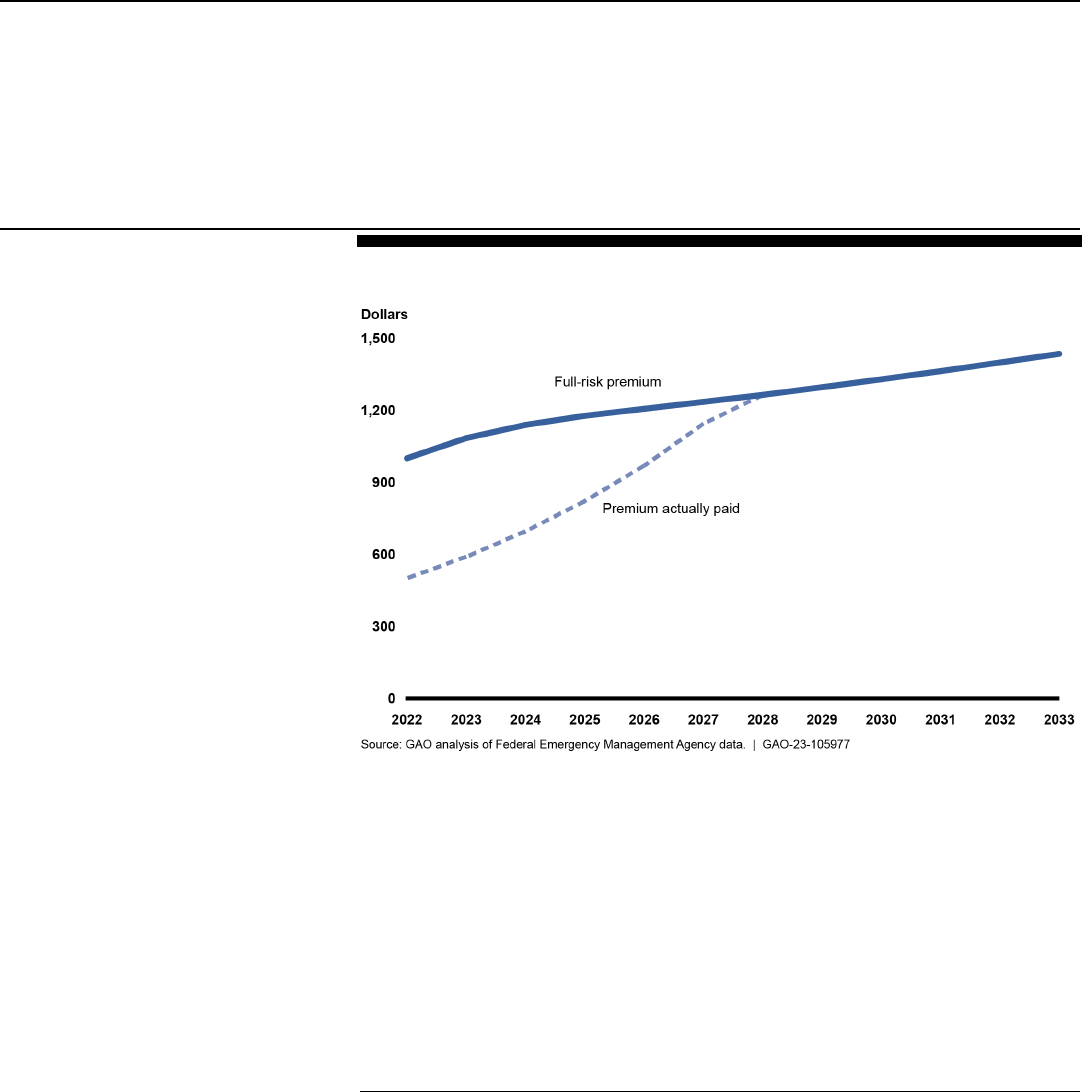
Page 35 GAO-23-105977 Flood Insurance
Figure 8: Illustration of the Premium Shortfall and Transition to Full-Risk Premium
for a Hypothetical National Flood Insurance Program Policy
Note: These calculations assume that the premium actually paid increases 18 percent annually and
that the full-risk premium increases annually to account for inflation and increases in flood risk.
As of December 31, 2022, 66 percent of NFIP policies that had renewed
since April 1, 2022, were on the glidepath. We estimated the following:
65
• Policies on the glidepath will result in a total premium shortfall of $2.7
billion in 2023.
• By 2037, 95 percent of policies will reach full-risk premiums.
• By 2049, virtually all policies will reach full-risk premiums.
65
Our estimates include several assumptions. Our shortfall calculations do not account for
assessments, surcharges, and fees. We increased full-risk premiums for inflation and
changes in flood risk and increased premiums actually paid by applicable annual premium
increase caps. We also assumed that all policies on the glidepath would renew NFIP
coverage and that policies would keep the same coverage and deductible amounts until
reaching full-risk premiums. Further, we assumed that policies that had not yet renewed
under Risk Rating 2.0 would follow a glidepath similar to those of policies that had
renewed. By 2049, 99.99 percent of policies would have reached full risk. Finally, we
calculated the total premium shortfall net of WYO expenses. In fiscal year 2023, FEMA
agreed to pay WYO insurers 29.7 percent of premiums. The present value of the total
shortfall is $23 billion (using a discount rate of 2.82 percent as of December 31, 2022).
Full results of our analysis are included in app. II.
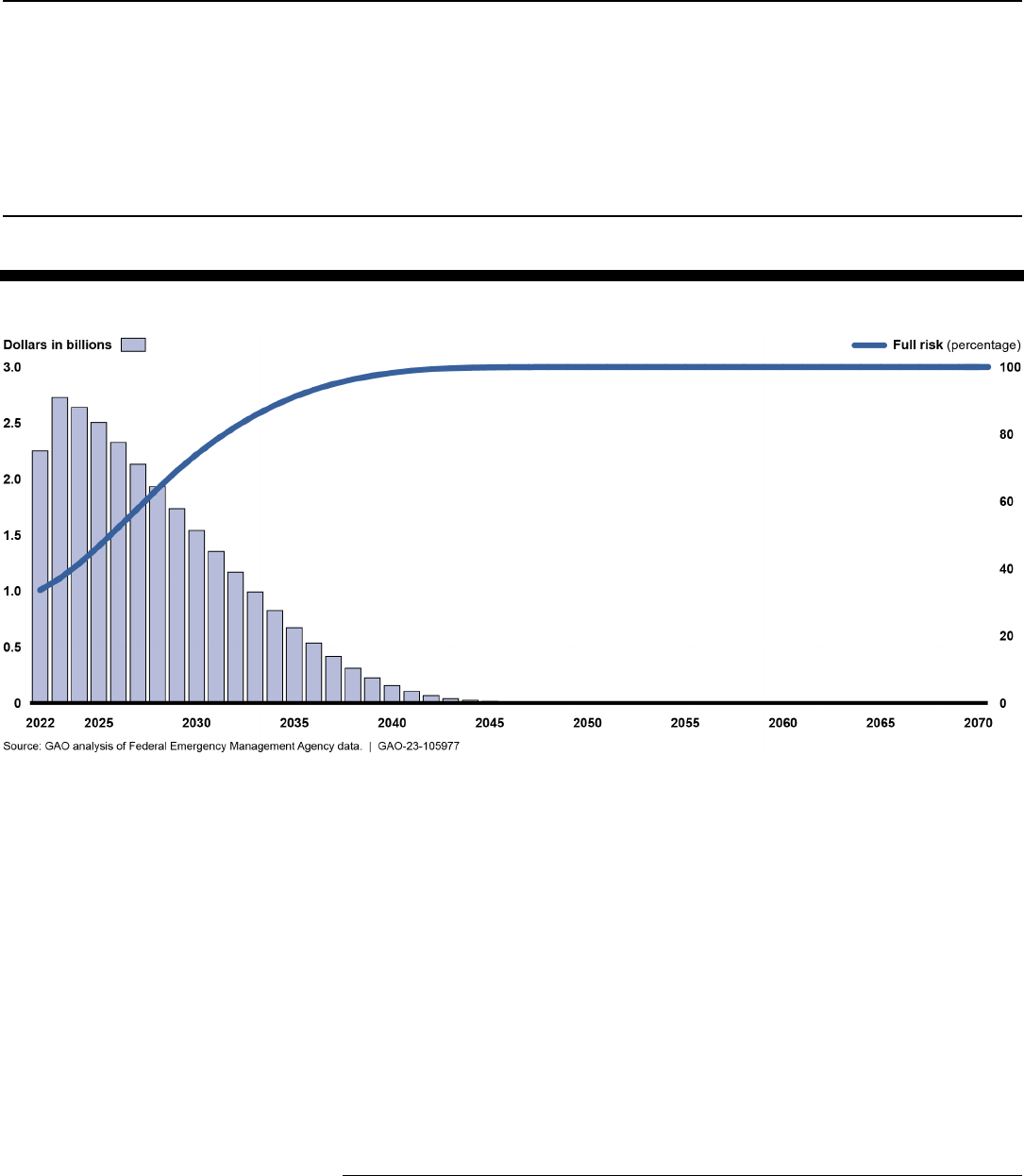
Page 36 GAO-23-105977 Flood Insurance
• The total premium shortfall will be $26.7 billion (see fig. 9).
Figure 9: Estimated Premium Shortfall and Percentage of National Flood Insurance Program Policies at Full-Risk Premiums,
by Calendar Year
Note: Shortfall calculations start in April 2022 when renewing policies became subject to Risk Rating
2.0. The total estimated glidepath shortfall is $26.7 billion (present value of $23 billion as of
December 31, 2022).
Our model for estimating the duration and cost of policies on the glidepath
included four key inputs—annual premium increase caps, inflation rates,
flood risk, and NFIP policy renewal.
66
Changing each input resulted in
different estimates. For example, we found that lowering the annual
premium increase cap (currently 18 percent for most policies) to 9 percent
for all policies would significantly extend the glidepath (for 95 percent of
policies) from 15 to 34 years. It would also increase the total premium
shortfall from $26.7 billion to $69 billion (see fig. 10). By comparison,
increasing the annual premium increase cap to 25 percent for all policies
66
In our sensitivity analysis, we incorporated alternative inflation, flood risk, annual rate
increase caps, and NFIP renewal rates and changed these assumptions individually while
holding the others at the baseline level.
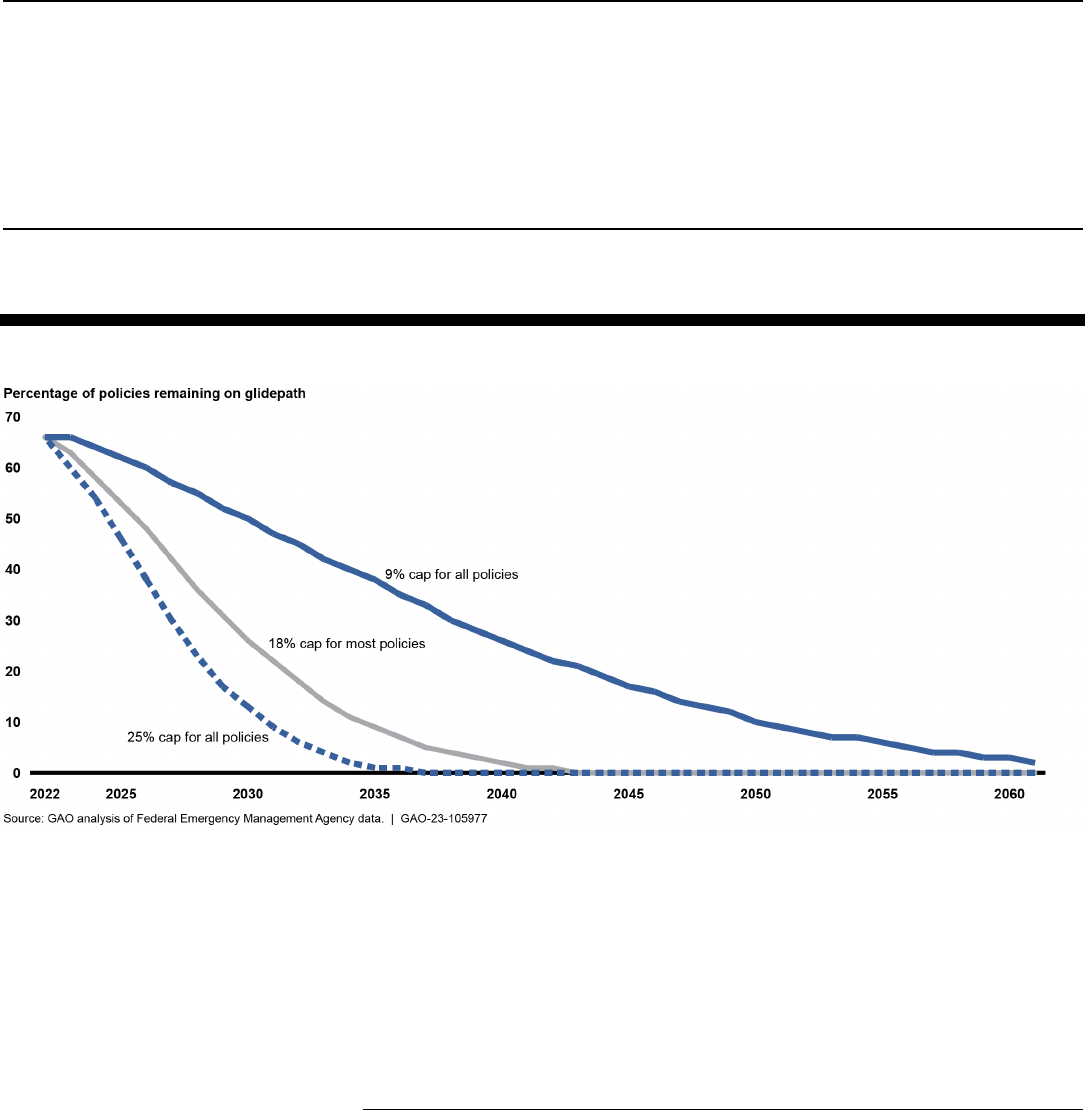
Page 37 GAO-23-105977 Flood Insurance
would shorten the glidepath to 11 years and reduce the shortfall to $18
billion.
67
Figure 10: National Flood Insurance Program Policies Remaining on the Glidepath under Alternative Annual Premium
Increase Caps, by Year
Note: The baseline scenario (gray line) assumes current annual premium increase caps, which are 18
percent for most policies but range from 5 to 25 percent.
We also found that higher inflation would slightly increase the shortfall
amount. For the alternative scenarios, we assumed inflation would be 1
percentage point higher or lower in the first year and converge to the
baseline over 5 years. Higher inflation would increase the total shortfall
from $26.7 billion to $27 billion. By comparison, lower inflation would
reduce the shortfall to $26 billion.
68
67
For this sensitivity analysis, we chose a lower premium increase cap of 9 percent to
reflect a level that has been specifically proposed in legislation and a higher rate cap of 25
percent to reflect the highest current premium increase cap for certain properties. The
present values of the total shortfalls are $48 billion and $16 billion, respectively, for the 9
and 25 percent rate cap scenarios.
68
For the baseline inflation estimate, we used projections from the Congressional Budget
Office, The Budget and Economic Outlook: 2023 to 2033 (Washington, D.C.: February
2023). The present values of total shortfalls are $23 billion and $22 billion under the higher
and lower inflation scenarios, respectively.

Page 38 GAO-23-105977 Flood Insurance
Changing flood risk has little effect on our model’s estimates because the
projected increases in flood risk are smaller when annualized and are
projected to increase in severity by 2100.
69
Under both alternative
scenarios, the glidepath would remain at 15 years (for 95 percent of
policies), and the total shortfall would change by less than $1 billion.
Premium shortfalls would be reduced if policyholders on the glidepath
dropped their insurance. For example, if 6 percent of policies on the
glidepath choose not to renew each year, this would reduce the total
estimated shortfall from $26.7 billion to $19 billion.
70
However, to the
extent that policyholders drop coverage in a way that significantly
changes NFIP’s distribution of risk among all policies, FEMA would have
to change premiums to reflect the new distribution of risk.
71
Further, to the
extent that these policyholders do not replace their NFIP coverage with
private flood coverage, resilience would decline and fiscal exposure could
increase as former policyholders increase their reliance on disaster
assistance.
Current policy addresses affordability through discounted premiums by
capping annual premium increases, but this approach has several
limitations.
• Hides fiscal exposure. The discounted premiums and the resulting
premium shortfalls generate fiscal exposure that is not transparent to
Congress and the public. Specifically, the premium shortfalls have
contributed to the $36.5 billion in borrowing from Treasury since 2005.
While these costs were incurred when the discounted premiums were
charged, they were not evident until years later when FEMA had to
borrow from Treasury. In other words, the policy decision to address
affordability by charging discounted premiums prevented NFIP from
building a surplus in lower-loss years that it could have used to pay
69
For the flood risk estimates, we used projections from the Office of Management and
Budget, Analytical Perspectives: Budget of the United States Government, Fiscal Year
2023 (Washington, D.C.: Mar. 28, 2022). These projections estimated that NFIP’s gross
average annual losses would increase by 7 to 13 percent by 2050 and 40 to 84 percent by
2100. Using the 2050 projections, we calculated a baseline annual flood risk increase of
0.31 percent, the midpoint between the alternative scenarios of 0.22 and 0.40 percent.
70
We assumed that nonrenewals would be randomly distributed among the policies on the
glidepath. The present value of the total premium shortfall is $17 billion as of December
31, 2022.
71
The ability to spread risk across a portfolio depends on the diversification of the risks
covered by those policies. An insurer can diversify its risks by insuring risks that are more
independent of each other—that is, that are less likely to cause losses at the same time.
Discounted Premiums
Hide Fiscal Exposure,
Address Affordability
Poorly, and Hinder Private-
Market Growth

Page 39 GAO-23-105977 Flood Insurance
some of the claims in higher-loss years. As mentioned previously,
prior to Risk Rating 2.0, FEMA was unable to reliably calculate NFIP’s
total annual premium shortfall because it lacked full-risk premium
information for many of its policies. However, Risk Rating 2.0 allows
FEMA to calculate full-risk premiums for all policies.
• Addresses affordability poorly. Discounted premiums are not tied to
a policyholder’s ability to pay, in terms of both the amount of the
discounts and who receives them. As a result, some policyholders
who do not need assistance are likely still receiving it (or are receiving
more than they need), thus unnecessarily increasing fiscal exposure.
Concurrently, some policyholders are likely not receiving enough
assistance to make their flood insurance affordable, which may
reduce consumer participation if policyholders drop coverage because
they cannot afford it. Policyholders subject to the mandatory purchase
requirement, however, do not have the option of dropping coverage if
premiums become unaffordable. In addition, because full-risk
premiums are being implemented through gradual but steady
premium increases, the affordability assistance is temporary. As the
discounts are phased out, fiscal exposure will decrease, but
affordability concerns will increase, potentially further reducing
consumer participation and resilience. Moreover, reaching the end of
the glidepath does not mean premiums will not increase further.
Premiums can increase for a number of reasons, including increased
repair costs or higher estimates of the frequency and severity of
flooding events.
• Hinders private-market growth. Discounts also make NFIP
premiums lower than are actuarially justified. Private insurers told us
this undercuts the premiums they are able to charge and places them
at a competitive disadvantage. This impedes private-market growth
and limits insurance options for homeowners. It also increases fiscal
exposure to the extent that NFIP continues to cover risk exposure that
the private sector could otherwise assume.
We previously identified several policy goals for flood insurance reform.
72
These include requiring transparency of the federal fiscal exposure,
encouraging consumer participation, promoting flood risk resilience, and
minimizing federal fiscal exposure (including by encouraging private-
sector involvement). However, the current approach to addressing
affordability does not achieve these goals because Congress provides
assistance by capping annual premium increases rather than through a
72
See GAO-17-425.

Page 40 GAO-23-105977 Flood Insurance
means-based program that is reflected in the federal budget. Addressing
affordability through a means-based assistance program that is
recognized in the federal budget, rather than through discounted
premiums, could make the premium shortfall costs transparent and could
lessen the need for large program borrowing in the future.
73
It could also
improve Congress’s ability to oversee the program and the public’s ability
to scrutinize it. A means-based assistance program would also be a long-
term solution to address affordability that could target assistance more
effectively and encourage consumer participation and private sector
involvement.
A policy decision to design a means-based assistance program would
require additional decisions about eligibility, including income-level
requirements, the amount of assistance desired for each level of income,
and the types of policyholders who would be eligible. Each of these
decisions ultimately involves balancing costs with encouraging consumer
participation. For example, costs could be limited by providing assistance
only to certain categories of current NFIP policyholders. However,
providing assistance to future NFIP policyholders could encourage
greater consumer participation. Further, providing assistance to private-
market policyholders could further encourage consumer participation
while treating NFIP and the private market equitably.
We estimated the cost and number of recipients of a means-based
assistance program for which only current NFIP policyholders of primary
single-family residences would be eligible.
74
We assumed a means-based
assistance program would replace the glidepath, so any policy receiving
assistance would immediately convert to the full-risk premium. We
considered two alternatives for determining the assistance amount: (1)
73
We have reported that setting up and administering an assistance program would incur
some administrative costs. See GAO, National Flood Insurance Program: Options for
Providing Affordability Assistance, GAO-16-190 (Washington, D.C.: Feb. 10, 2016).
74
All costs of flood insurance—full-risk premiums as well as any assessments,
surcharges, or fees—would be considered in determining eligibility for assistance and how
much assistance to offer. As such, we refer to the total policyholder payments as
“premiums” in this section. We based our estimates on elements of several recent
proposals. Most proposals limit assistance to policyholders with low or moderate
household income. Some proposals also feature other eligibility criteria, including
accounting for wealth in the means test and further limitations based on federal poverty
guidelines. Because we cannot include these criteria, we may overestimate cost. All
assessments, surcharges, and fees levied by NFIP on policies are included in the
premium amount that is used to determine eligibility for and level of assistance. Full
results of our analysis are included in app. II.
Key Considerations for
Means-Based Assistance
Include Cost, Consumer
Participation, and Effects
on the Private Market

Page 41 GAO-23-105977 Flood Insurance
covering the amount of the premium that exceeded a certain percentage
of household income and (2) covering a certain percentage of the
premium.
75
The first alternative also would restrict eligibility to policyholders whose
household income was below a certain percentage of the area median
income (AMI). For instance, a policyholder with household income of
$40,000 where the AMI is $80,000 would be at 50 percent of AMI. This
policyholder would be eligible as long as the AMI threshold was set at or
above 50 percent. If the policyholder’s premium was $900 and assistance
covered the portion of the premium that exceeded 1 percent of household
income, the policyholder would be responsible for paying 1 percent of
household income ($400) and the assistance would cover the remaining
$500.
The first alternative would cost the federal government roughly $585
million to $2.0 billion in the first year and cover roughly 470,000 to 1.6
million policyholders (see fig. 11).
76
The estimates vary depending on the
level at which the assistance begins (either 1 or 2 percent of household
income) and the policyholders who are determined to be eligible (those
with household incomes below either 80, 100, or 120 percent of AMI).
77
75
The Department of Homeland Security proposed a means-tested assistance program for
flood insurance that would offer a graduated premium discount to current and new NFIP
policyholders with household income at or below 120 percent of AMI. This proposal is
similar to the second alternative we discuss. See Department of Homeland Security,
Legislative Reform Package.
76
The cost of a means-based assistance program depends on a number of parameters,
including policyholder eligibility and level of support. We discuss our methodology in more
detail in app. I.
77
We estimated policyholder incomes using the median household income of the census
tract in which the insured property is located. As previously mentioned, this may
understate policyholder incomes, and therefore overstate the cost of affordability
programs.
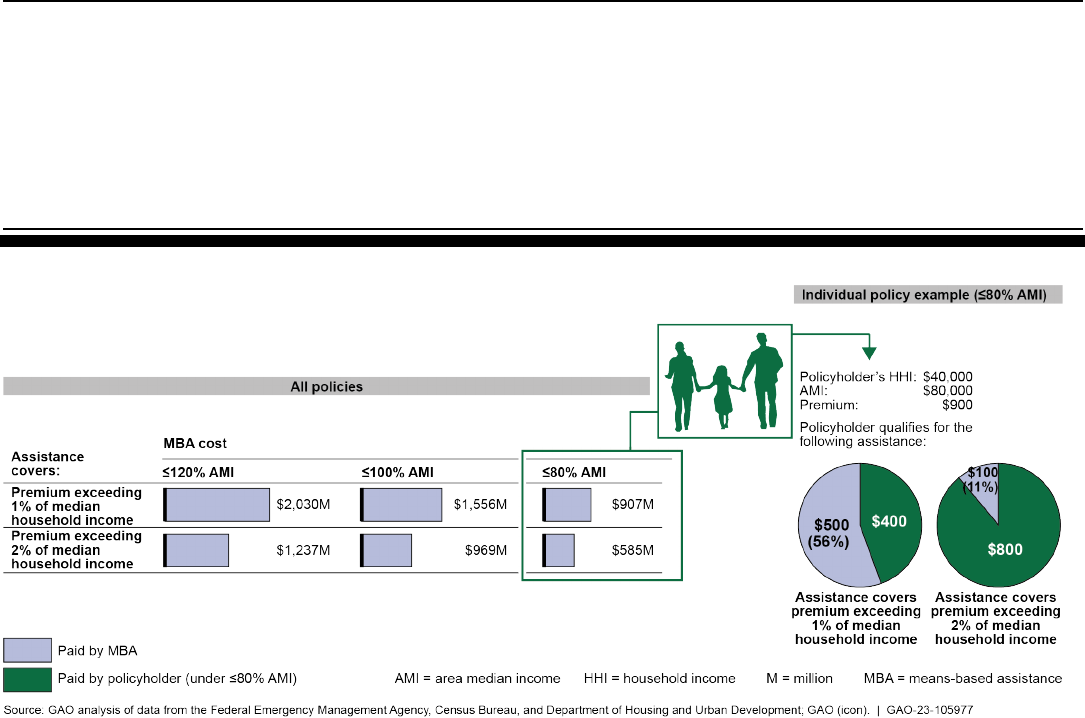
Page 42 GAO-23-105977 Flood Insurance
Figure 11: Cost Estimates of a Means-Based Assistance Program—Alternative 1
The second alternative would provide premium discounts on a sliding
scale, whereby the discount would increase as a policyholder’s household
income decreased relative to AMI. These estimates assume discounts of
40, 60, and 80 percent for AMI thresholds at 100, 80, and 50 percent,
respectively. The same policyholder cited above, with a $900 premium
and household income of $40,000 in a county with an AMI of $80,000,
would receive assistance covering 80 percent of the premium ($720),
leaving the policyholder to pay the remaining $180 (see fig. 12). This
second alternative would cost the federal government roughly $1.3 billion
in the first year and cover roughly 1.5 million policyholders.
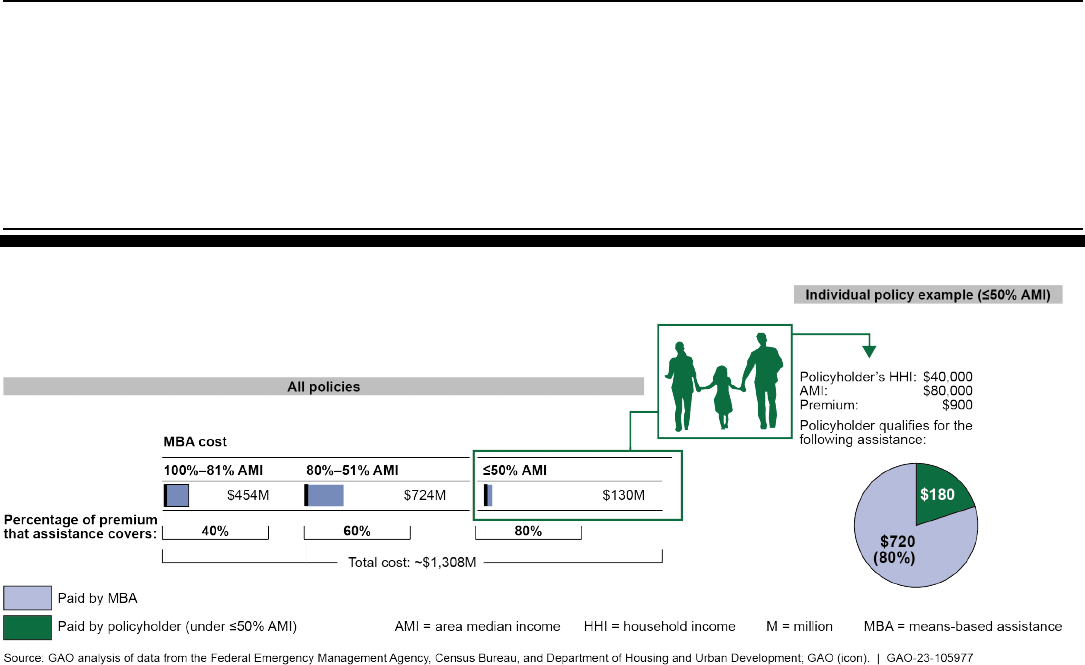
Page 43 GAO-23-105977 Flood Insurance
Figure 12: Cost Estimates of a Means-Based Assistance Program—Alternative 2
Providing means-based assistance to current NFIP policyholders likely
would be more cost-effective than providing assistance through
discounted rates because it would be targeted to policyholders who need
it. As previously mentioned, we estimated that providing assistance
through discounted rates will cost about $3.9 billion in 2023. In contrast,
we estimated that the cost of means-based assistance would be
significantly less, ranging from $585 million to $2.0 billion in the first year.
Additional modifications to eligibility could help further limit the cost of a
means-based assistance program or encourage the participation of more
or different consumers. For instance, to decrease costs, FEMA could
restrict eligibility to properties with high flood risk, exclude repetitive loss
properties from receiving assistance, or require mitigation to receive
assistance. To increase coverage, FEMA could make new NFIP
policyholders, private-market policyholders, or both eligible for assistance.
Restricting eligibility based on property flood risk or purchase
requirements. Restricting assistance would reduce program costs. For
example, assistance could be restricted to policyholders required to
purchase insurance (because they generally do not have the option of
dropping coverage if they cannot afford it) or to those with properties
exceeding a certain threshold of flood risk (because they generally have
more need for protection). FEMA does not track which policies are
subject to the mandatory purchase requirement, but properties in SFHAs

Page 44 GAO-23-105977 Flood Insurance
can serve as an upper bound approximation.
78
We estimated that
restricting assistance to policyholders in SFHAs would reduce program
costs to between roughly $380 million and $1.3 billion for the first
alternative, depending on the eligibility thresholds chosen. However, we
and others have reported that some of FEMA’s floodplain maps
designating high-risk areas are outdated.
79
We have also reported that
expanding the mandatory purchase requirement could increase consumer
participation and enhance resilience.
80
As a result, flood risk metrics other
than the SFHA boundary line could be useful in determining eligibility.
Excluding repetitive loss properties. According to the Department of
Homeland Security, unmitigated repetitive loss properties make up about
2.5 percent of NFIP policies, but such policies have accounted for a
disproportionate share of claims. For example, as of December 2021, 48
percent of NFIP claims by dollar value had been paid to properties with
two or more losses. This high risk of flood loss makes their premiums—
and thus their potential assistance cost—high. Excluding these properties
from assistance could limit costs and discourage development in high-risk
areas.
Incorporating mitigation into affordability assistance. Premiums help
to signal flood risk, and with higher premiums, policyholders have a
greater incentive to undertake mitigation efforts to reduce their flood risk
and premiums. Conversely, premium assistance can reduce incentives
for mitigation, so incorporating mitigation into assistance could help
preserve and increase resilience while addressing affordability. For
example, the program could provide up-front assistance for mitigation
78
Generally, the mandatory purchase requirement applies to properties in SFHAs with
federally backed mortgages (those made, insured, or guaranteed by federally regulated
lenders or federal agencies, or purchased by the government-sponsored enterprises for
housing—Fannie Mae and Freddie Mac).
79
See GAO, FEMA Flood Maps: Better Planning and Analysis Needed to Address Current
and Future Flood Hazards, GAO-22-104079 (Washington, D.C.: Oct. 25, 2021); Elyssa L.
Collins et al., “Predicting Flood Damage Probability across the Conterminous United
States,” Environmental Research Letters, vol. 17 (2022); and Natural Resources Defense
Council and Association of State Floodplain Managers, Inc., Petition Requesting That The
Federal Emergency Management Agency Amend Its Regulations Implementing the
National Flood Insurance Program (Jan. 5, 2021). As discussed previously, FEMA no
longer uses these maps for setting premiums under Risk Rating 2.0. However, FEMA still
uses them for determining mandatory purchase requirements and setting local floodplain
management standards.
80
See GAO-17-425.

Page 45 GAO-23-105977 Flood Insurance
measures. This approach would entail larger initial costs, but in the long
term it would reduce the risk of loss and the amount of premium
assistance needed, as well as the need for federal disaster assistance.
Further, several studies have proposed pairing mitigation assistance with
premium assistance by requiring mitigation financed through a low-
interest loan and providing a means-tested voucher.
81
Expanding eligibility to new NFIP policyholders. Making assistance
available to property owners who do not yet have NFIP coverage could
increase consumer participation and enhance resilience. However, it is
difficult to estimate the number of new policyholders that affordability
assistance might attract to NFIP, and consequently the level of assistance
necessary to meet that demand. Studies have found that NFIP
policyholders were price-sensitive to premium changes, indicating that
affordability assistance likely would increase NFIP take-up.
82
The number
of NFIP policies has also been steadily decreasing in recent years. At the
beginning of 2019, NFIP had 5.11 million policies.
83
As of December
2022, NFIP had 4.77 million policies, which includes a reduction of
175,000 policies (3.5 percent) since Risk Rating 2.0 implementation
began in October 2021 (see fig. 13). Premiums increased every year
during this period, and some former policyholders might want to reenroll if
affordability assistance were available.
81
Carolyn Kousky and Howard Kunreuther, “Addressing Affordability in the National Flood
Insurance Program,” Journal of Extreme Events, vol. 1 (2014); Wendy Zhao, Howard
Kunreuther, and Jeffrey Czajkowski, “Affordability of the National Flood Insurance
Program: Application to Charleston County, South Carolina,” Natural Hazards Review, vol.
17, no. 1 (February 2016); and National Research Council of the National Academies,
Affordability of National Flood Insurance Program Premiums—Report 1 (Washington,
D.C.: March 2015). The National Academies issued its second report in 2016, which
proposed procedures with which FEMA might analyze policy options. See National
Academies of Sciences, Engineering, and Medicine, Affordability of National Flood
Insurance Program Premiums—Report 2 (Washington, D.C.: 2016).
82
See Larry Baeder and David Evans, Insights into Consumer Demand for Flood
Insurance: Trends in Take-Up (San Francisco, Calif.: Milliman, September 2021) and
Jacob Bradt, Carolyn Kousky and Oliver Wing, “Voluntary Purchases and Adverse
Selection in the Market for Flood Insurance,” Journal of Environmental Economics and
Management, vol. 110 (2021).
83
Policy numbers in this section account for each unit within a Residential Condominium
Building Association Policy as a separate policy.
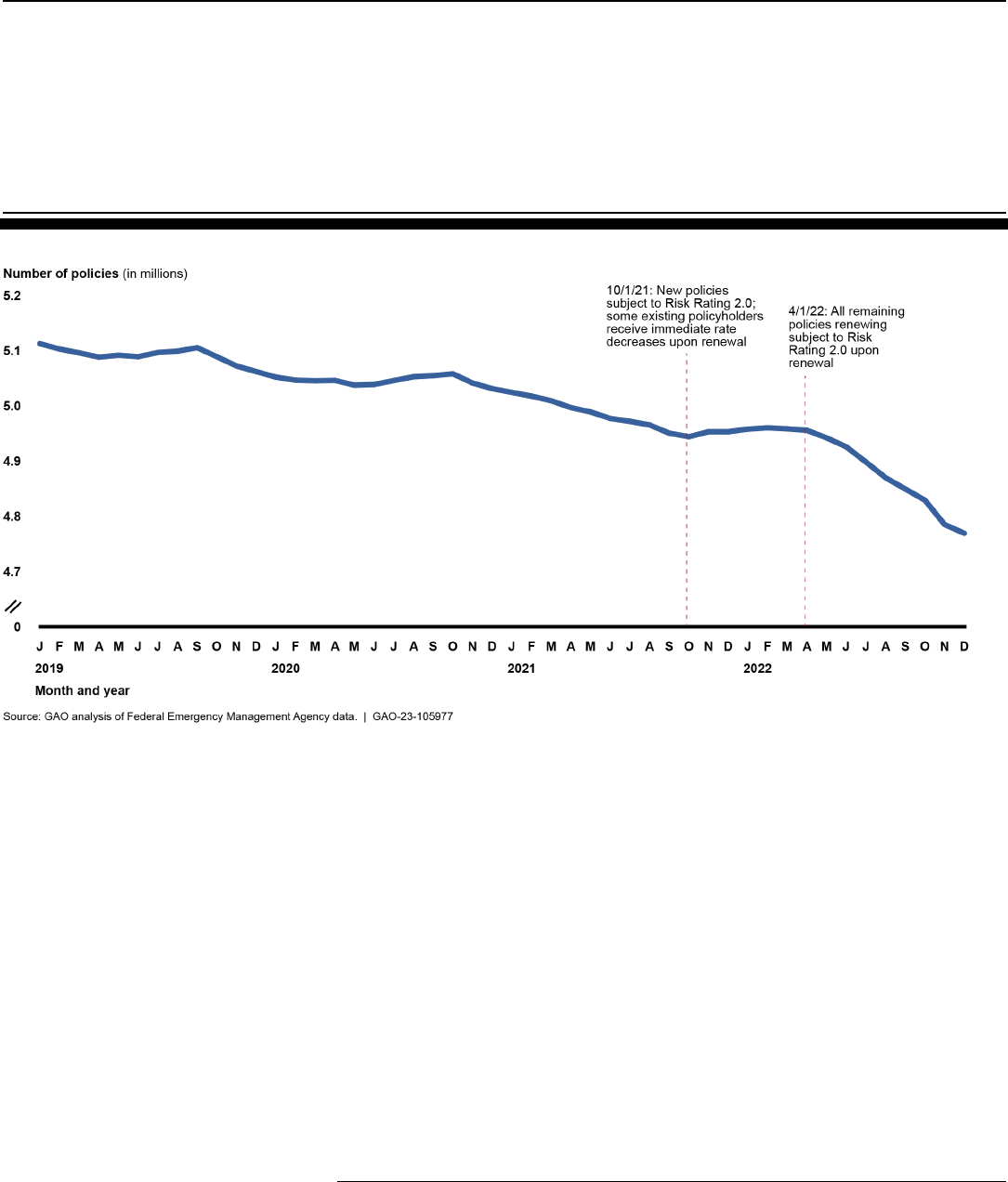
Page 46 GAO-23-105977 Flood Insurance
Figure 13: Number of National Flood Insurance Program Policies, 2019–2022
Note: Policy numbers account for each unit within a Residential Condominium Building Association
Policy as a separate policy.
Further, we estimated that only about 3.9 percent of occupied housing
units had NFIP flood insurance, indicating the potential for significant
growth in flood insurance take-up, especially with assistance increasing
affordability. To limit demand from new policyholders, expanding eligibility
to new NFIP policyholders could be combined with restricting eligibility
based on purchase requirements or flood risk. Because most
homeowners subject to the mandatory purchase requirement already
have an NFIP policy (exceptions include those with a private-market
policy or not in compliance), such restrictions could help limit cost
increases.
84
Expanding eligibility to private-market policyholders. Providing
assistance for private flood insurance policyholders could allow private
flood insurance premiums to compete fairly with NFIP premiums and
therefore promote the private market. Specifically, private flood insurers
84
For more information on the mandatory purchase requirement, see GAO, National Flood
Insurance Program: Congress Should Consider Updating the Mandatory Purchase
Requirement, GAO-21-578 (Washington, D.C.: July 30, 2021).

Page 47 GAO-23-105977 Flood Insurance
told us that providing assistance only for NFIP policies would put them at
a competitive disadvantage because many NFIP customers would pay
lower premiums. They said they generally supported an assistance
program if private-market policyholders were eligible. They also said that
because of privacy concerns, private flood insurers would not want to be
responsible for examining policyholders’ tax-related documents and
determining eligibility. As with expanding eligibility to new NFIP
policyholders, this modification could increase consumer participation and
enhance resilience, but it could also be combined with eligibility
restrictions to limit demand and costs.
85
NFIP owed $20.5 billion to Treasury as of April 2023, and not addressing
this legacy debt—and the structural issues that caused it—will likely result
in increased debt.
86
It will also delay NFIP’s actuarial soundness, worsen
policyholder affordability concerns, and reduce consumer participation.
FEMA covers NFIP flood claims and program expenses primarily by using
insurance premiums, assessments, surcharges, and fees paid by
policyholders. When revenue, reinsurance, and any accumulated surplus
are insufficient, FEMA has authority to borrow from Treasury. Before
2005, NFIP was mostly self-sustaining, but since then, NFIP has had to
borrow $36.5 billion to pay claims.
87
NFIP’s borrowing has followed
catastrophic flood events, most notably Hurricane Katrina in 2005,
Hurricane Sandy in 2012, and Hurricane Harvey in 2017 (see fig. 14).
Absent congressional action, the program’s debt likely will continue to
85
The private residential flood market made up 7 percent of the total residential flood
market as of December 2021.
86
We refer to the debt that has built up to date as the legacy debt, as distinct from
additional debt that might accrue in the future.
87
Congress appropriated funds to retire NFIP’s approximately $200 million debt to
Treasury in 1985. NFIP also had intermittent debt in the 1990s, reaching nearly $1 billion
in 1997, but it paid off the debt in subsequent years. Congress forgave $16 billion of NFIP
debt in October 2017.
Options Exist to
Address NFIP’s
Legacy Debt and the
Potential for Future
Debt
NFIP’s Current Debt
Delays Actuarial
Soundness and
Exacerbates Affordability
Concerns
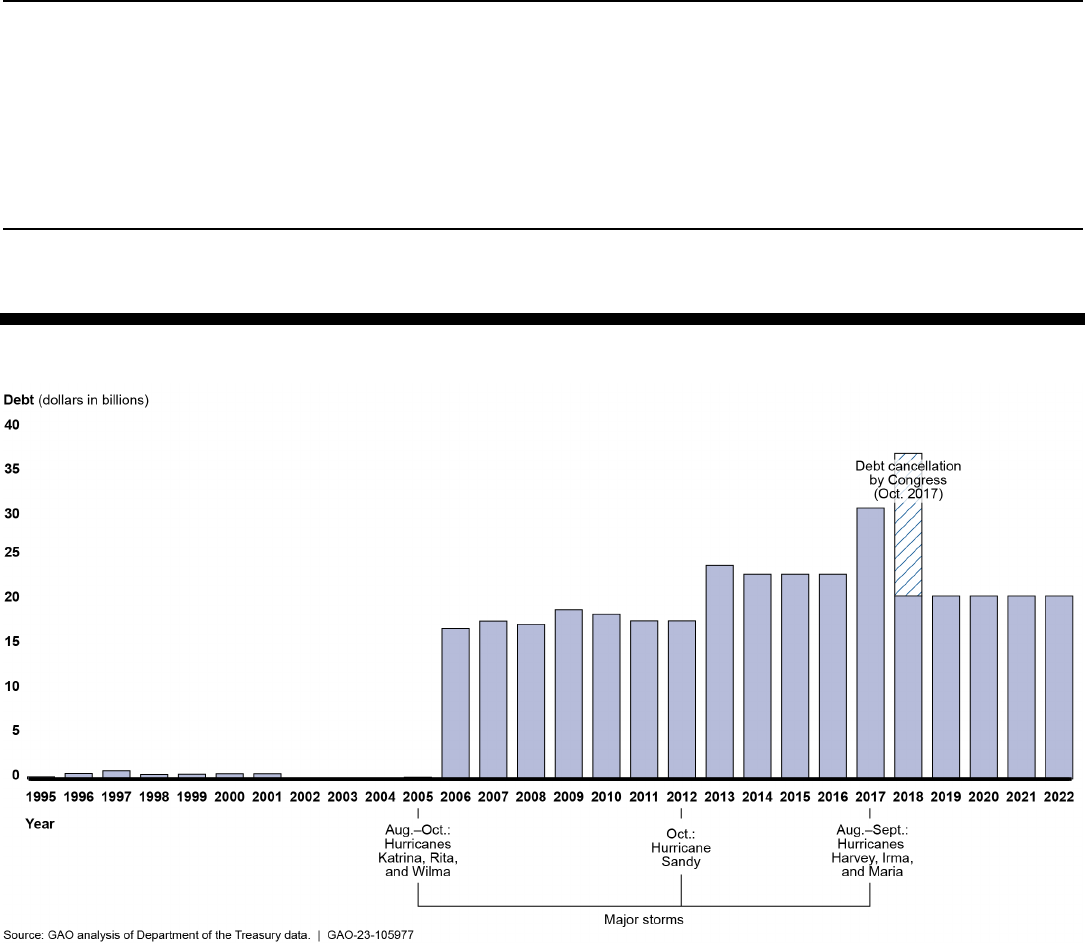
Page 48 GAO-23-105977 Flood Insurance
grow as the caps on annual premium increases are slowing the transition
to full-risk premiums.
Figure 14: National Flood Insurance Program Annual Year-End Outstanding Debt to the Department of the Treasury, Fiscal
Years 1995–2022
NFIP’s debt largely is a result of premium inadequacy, due to the policy
decision to prioritize affordability over solvency. This is because requiring
FEMA to charge discounted premiums that did not reflect the full risk of
loss left NFIP with inadequate funds to pay claims in some years.
Specifically, FEMA has been statutorily required to offer discounted
premiums for certain properties since the program’s inception. While
NFIP had relatively little debt for nearly 40 years, the subsidized
premiums prevented NFIP from building a surplus that could have helped
cover some of the higher-loss years and reduced or avoided some of the
borrowing that began in 2005. In other words, while the cost of the
subsidized premiums did not become evident until 2005 when it began
materializing in debt, the costs began accruing when FEMA charged the
discounted premiums. If FEMA had been able to charge full-risk
premiums, it might have built up more funds that would have enabled it to

Page 49 GAO-23-105977 Flood Insurance
pay a greater portion of those larger losses in 2005 and after and given it
additional revenue in those years.
NFIP’s debt raises concerns about the actuarial soundness of the
program, the program’s affordability for policyholders, and consumer
participation.
Actuarial soundness concerns. Although FEMA was prevented from
collecting full-risk premiums from previous policyholders, it is statutorily
required to repay the debt and any accrued interest using revenue from
current and future policyholders.
88
From fiscal years 2006 through 2022,
FEMA paid an annual average of $336 million in interest on the debt, but
it has not made any repayments of principal since 2014, and Congress
forgave $16 billion of principal in October 2017.
89
Debt arising from the
experience of previous policyholders is not a cost associated with the risk
of current policyholders. Therefore, requiring FEMA to repay this debt and
the resulting interest expenses obliges FEMA to charge current and future
policyholders, which is not actuarially justified.
90
88
42 U.S.C. § 2414(e). NFIP debt normally has a 3-year maturity unless Treasury grants
an exception for a longer maturity. Principal and interest payments are permitted at any
time, and the debt may be repaid or refinanced at maturity.
89
FEMA is required to repay the debt, but it can refinance the debt as long as the total
debt is less than the borrowing limit. FEMA has not paid principal on the debt since 2014
because it has prioritized building NFIP’s reserve fund. FEMA is statutorily required to
maintain a reserve fund, with a target balance of at least 1 percent of insurance-in-force
(42 U.S.C. § 4017a(b)(1)), and to make a minimum annual payment into the fund of 7.5
percent of the target balance until the fund balance reaches the target amount. According
to FEMA, interest payments will continue to consume a significant amount of revenue that
would otherwise serve to grow the reserve fund for future catastrophic events, particularly
when interest rates rise.
90
Statutory requirements to repay program debt and build a reserve fund preceded Risk
Rating 2.0 and operate outside of the Risk Rating 2.0 ratemaking process. FEMA created
full-risk premiums to be prospective and therefore does not include provisions for interest
expenses on its debt, nor for repayment of its debt, when calculating them. However,
FEMA uses revenue from current policyholders to make these interest payments.
Generally, revenue from premiums and the Federal Policy Fee goes into the insurance
fund, and revenue from the reserve fund assessment and HFIAA surcharge goes into the
reserve fund. FEMA makes interest payments using the insurance fund first, and if
necessary, the reserve fund. The requirement to pay interest on legacy debt effectively
slows FEMA’s ability to achieve the target reserve fund balance, and in turn, requires
FEMA to charge current and future policyholders a higher reserve fund assessment, or to
charge a reserve fund assessment for a longer period of time, than would otherwise be
necessary.

Page 50 GAO-23-105977 Flood Insurance
Affordability concerns. Charging current or future policyholders to
service the debt also exacerbates affordability concerns. From fiscal
years 2017 through 2022, FEMA made annual interest payments ranging
from $300 million to $438 million—or the equivalent of $63 to $92 per
policyholder per year.
Moreover, FEMA has no realistic prospect of repaying the debt as
currently structured. FEMA also has reported that repayment of the
legacy debt is beyond NFIP’s current capability.
91
Further, the statutory
annual premium increase caps result in premium shortfalls that make
additional future debt more likely. For example, repaying the legacy
debt—plus future debt we estimated could accrue due to glidepath
shortfalls—in 30 years at 2.5 percent interest would require an annual
payment of about $1.9 billion.
92
NFIP collected $3.24 billion in premiums
in fiscal year 2022. Therefore, this payment would have required a 60
percent surcharge per policyholder in the first year.
93
Consumer participation concerns. NFIP policyholder decreases have
accompanied premium increases, and such a surcharge likely would
cause many more policyholders to drop their NFIP coverage. Some of
these policyholders might replace their coverage with a private-market
policy—especially those policyholders subject to the mandatory purchase
requirement. However, some policyholders would choose to drop
coverage altogether, leaving them unprotected from flood risk, reducing
resilience, and increasing reliance on federal disaster assistance. Further,
having fewer NFIP policyholders to repay the debt would necessitate
higher surcharges and likely cause more policyholders to leave NFIP.
91
According to FEMA, even with the implementation of Risk Rating 2.0, NFIP would be
unable to make consistent principal repayments sufficient to improve overall fiscal
solvency. FEMA estimated that NFIP could reasonably be expected to accrue an
additional $15 billion of debt in 10 years. See Department of Homeland Security,
Legislative Reform Package, and National Flood Insurance Program Semi-Annual Debt
Repayment Progress Report, March 31, 2022, Report to Congress and the Secretary of
the Treasury (Washington, D.C.: Aug. 30, 2022).
92
We assumed a 2.5 percent interest rate for FEMA debt based on the interest rate for the
current FEMA debt, trending slightly higher. We estimated that premium shortfalls would
contribute $24.5 billion in additional debt during this 30-year repayment period.
93
The surcharge percentage would need to change in future years as NFIP premium
collections and debt levels change.

Page 51 GAO-23-105977 Flood Insurance
Addressing the legacy debt would require action by Congress. Two
options for doing so are canceling the debt and modifying the repayment
terms.
Canceling the debt. One option for addressing the $20.5 billion legacy
debt would involve canceling it (or alternatively, eliminating the
requirement that FEMA repay it).
94
This would free current and future
policyholders from paying for obligations they were not responsible for
incurring and address the existing inequity by allowing current and future
policyholders to pay only for their own flood risk. Further, it would make
insurance more affordable, thus encouraging consumer participation and
resilience. Congress has used this option before when it canceled $16
billion in NFIP debt in October 2017.
95
In one sense, canceling the debt transfers costs to taxpayers because
current and future policyholders would no longer be paying interest on the
debt. However, because it is not likely that current and future
policyholders will be able repay the debt under current rules, the cost has
essentially already been transferred to taxpayers. This transfer largely
occurred each time FEMA sold a policy at statutorily required discounted
premiums. Further, the 2017 debt cancellation did not require an
appropriation.
Modifying debt repayment. Alternatively, addressing the debt could
involve defining a plan to repay the legacy debt and any future debt that is
estimated to accrue through an additional surcharge on policyholders.
Such a plan could include modified terms of repayment, such as forgiving
some or all interest charges. Such a plan also could include immediately
charging full-risk premiums to all policyholders—thereby eliminating the
94
In May 2022, FEMA submitted to Congress a 104-page list of 17 legislative proposals
that, among other things, proposed canceling the debt, decreasing NFIP’s borrowing
authority to two-thirds of expected premiums in force in the following year, implementing a
plan to manage the program to a 1-in-20 occurrence loss level (about $10.5 billion, similar
to claims from Hurricane Harvey in 2017), eliminating interest on future debt, and requiring
any need for future debt to be funded through emergency supplemental appropriations.
See Department of Homeland Security, Legislative Reform Package.
95
On September 22, 2017, FEMA borrowed $5.825 billion from the Treasury and reached
NFIP’s authorized borrowing limit of $30.425 billion. On October 26, 2017, Congress
canceled $16 billion of NFIP debt to enable FEMA to pay claims for Hurricanes Harvey,
Irma, and Maria. On November 9, 2017, FEMA borrowed an additional $6.1 billion,
increasing the debt to $20.525 billion.
Options for Addressing the
Legacy Debt Include
Canceling the Debt or
Modifying Repayment
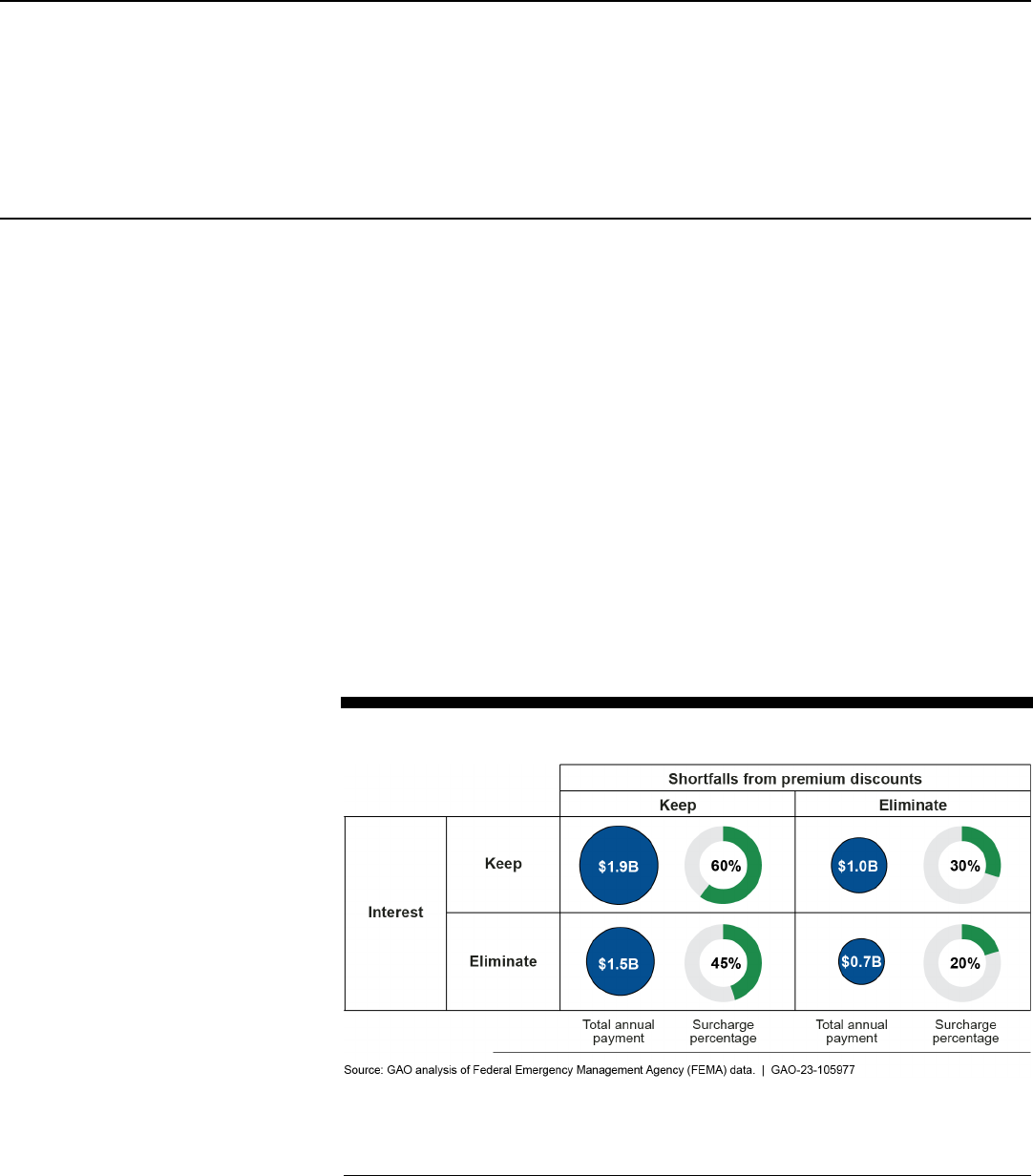
Page 52 GAO-23-105977 Flood Insurance
premium shortfall and reducing the likelihood of future debt.
96
However,
all of these options would involve substantial costs to future policyholders,
which would both exacerbate affordability concerns and charge
policyholders premiums significantly greater than are actuarially justified.
If interest was eliminated and all policyholders were charged full-risk
premiums, repaying the debt in 30 years would require an annual
payment of about $663 million. At NFIP’s fiscal year 2022 premium
revenue, the annual payment would require a 20 percent surcharge per
policyholder. This $663 million annual payment is significantly less than
repaying the debt with interest while allowing discounted premiums to
continue, which would increase the likelihood of future debt requiring
repayment and require an annual payment of about $1.9 billion, or a 60
percent surcharge per policyholder (see fig. 15). Taken independently,
immediately charging full-risk premiums to all policyholders would do
more to reduce the annual repayment costs (which would come to
approximately $963 million) than would eliminating interest (which would
bring costs to approximately $1.5 billion).
Figure 15: Estimated Effects of Various Requirements for Repaying National Flood
Insurance Program (NFIP) Debt over 30 Years
Note: Under the scenarios that keep premium shortfalls in place, we assume the debt will increase
each year by the amount of the premium shortfall. As a result, FEMA would be paying off both the
legacy debt and this estimated future debt. The surcharge percentage is the total annual payment as
a percentage of NFIP’s $3.24 billion in premium collections in fiscal year 2022. The surcharge
96
Immediately charging full-risk rates would reduce the annual payment required to repay
the debt because doing so would eliminate premium shortfalls, and therefore the likelihood
of increases in future debt. As discussed previously, replacing the glidepath with means-
based assistance could help address affordability concerns arising from immediately
charging full-risk rates.

Page 53 GAO-23-105977 Flood Insurance
percentage would need to change in future years as NFIP premium collections and debt levels
change.
This approach of eliminating interest on the debt and allowing FEMA to
charge full-risk premiums to all policyholders would recoup some costs for
taxpayers. It would also create a plan to repay the debt, rather than
allowing it to continue in perpetuity. However, it would worsen the inequity
for current and future policyholders by requiring them to pay for the loss
experience of previous policyholders. Further, a 20 percent surcharge
could exacerbate affordability concerns and cause some policyholders to
drop coverage, thus reducing consumer participation and harming
resilience. The surcharge could also increase costs for any future means-
based assistance program or reduce the net amount of help individuals
receive because the program would have to provide more assistance to
make flood insurance costs affordable.
The rollout of more actuarially sound premiums does not mean that
additional borrowing will not be needed in the future. The cap on annual
premium increases means that most policyholders will continue to pay
discounted premiums for years to come. Congress could eliminate this
source of future borrowing risk by removing the cap on annual premium
increases so that actuarial, full-risk premiums can be charged, or by
appropriating funds to make up for the discounted premiums. Congress
could also provide means-based premium assistance in combination with
either of these options.
These actions would reduce NFIP’s need to borrow in the future, but not
eliminate it. The program would still be subject to both “modeling risk” and
“sequencing risk.” Modeling risk is the inherent risk that even the best up-
to-date flood models, using reasonable assumptions and methods, are
not guaranteed to be accurate and could underestimate certain aspects of
flood risk. Sequencing risk is the risk that even if the models accurately
forecast average flood risk over time, there will be both good and bad
flood years around that average. If the bad flood years happen first, the
program will need to borrow. Sequencing risk is especially acute with
catastrophic floods.
Even if NFIP were to collect revenue sufficient to meet long-term
expected losses, the magnitude, volatility, and geographic concentration
of flood risk means that catastrophic events will happen and might exceed
what NFIP can financially manage without relying on additional funding.
As a result, it is important to consider options that could help NFIP reduce
the likelihood of future borrowing and establish clear expectations for the
Options for Addressing
Future Debt Include
Purchasing Additional
Reinsurance and
Changing Financing of
Catastrophic Losses

Page 54 GAO-23-105977 Flood Insurance
program’s capabilities. Two of these options are purchasing additional
reinsurance and changing the financing of catastrophic losses.
Purchasing additional reinsurance. One option for addressing potential
future debt is for FEMA to secure more reinsurance coverage for
catastrophic losses from the private reinsurance and capital markets.
97
Doing so would allow FEMA to price some of its flood risk up front
through the premiums it pays to reinsurers rather than borrowing from
Treasury after a flood, thus reducing the volatility of future catastrophic
losses.
A key benefit of reinsurance is to transfer and manage risk rather than to
reduce NFIP’s long-term fiscal exposure. However, even if FEMA were to
collect sufficient revenue to meet long-term estimated losses, FEMA
might not be able to fully address its future debt through reinsurance.
Specifically, the amount of reinsurance FEMA can purchase depends on
the amount of coverage reinsurers are willing to sell, the price they are
willing to charge, and the coverage provided. In fact, reinsurance costs
have increased in recent years, and FEMA has purchased less coverage.
Reinsurance likely will not lower the average cost of NFIP policies
because reinsurers charge premiums to compensate for the risk they
assume.
In addition, since NFIP must pay fair market premiums for private
reinsurance coverage, reinsurance cannot fully address future debt as
long as NFIP revenues remain actuarially inadequate. With inadequate
NFIP revenue, reinsurance recoveries from occasional catastrophic
events can help delay the accumulation of future debt in the short-term,
but cannot fully address it.
Changing financing of catastrophic losses. Another option is to define
NFIP’s program capacity and require FEMA to manage the program to
this capacity before requiring additional funding. This would include
establishing an annual risk threshold for the maximum amount of losses
97
FEMA has entered into two types of reinsurance agreements with private entities:
traditional reinsurance and capital markets reinsurance. Traditional reinsurance
agreements reimburse FEMA directly if losses from an event covered by the reinsurance
agreement exceed a certain threshold. Since 2017, FEMA has entered into 1-year
traditional reinsurance agreements each calendar year. Capital markets reinsurance
consists of catastrophe bonds issued to a large number of bondholders who agree to
release a portion of their bond principal to FEMA if losses from a covered event exceed
the threshold. FEMA’s current catastrophe bonds have a 3-year maturity.

Page 55 GAO-23-105977 Flood Insurance
that NFIP would be expected to cover based on its premium revenue. For
example, FEMA estimated in November 2021 that a risk threshold of a 1-
in-20 occurrence flood for NFIP currently is about a $10.5 billion event,
approximately the size of Hurricane Harvey.
98
Under this option, FEMA
would use the risk threshold as one of its ratemaking objectives when
developing full-risk premiums.
In the occasional cases when the annual losses exceed the threshold,
Treasury could fund claims through the Disaster Relief Fund and, if
needed, through an emergency supplemental appropriation.
99
Financing
future shortfalls as needed would avoid recreating debt and the potential
for charging future policyholders to repay it, which would improve equity,
affordability, consumer participation, and resilience. Further, Treasury
would effectively serve as a reinsurer to NFIP, so this option likely would
be less costly than FEMA purchasing private-sector reinsurance if
Treasury were to choose not to charge FEMA premiums for the cost of
the risk transfer. Alternatively, Treasury could choose to charge estimated
fair market rates for the risk transfer, but could provide a more reliable
source of capital than might be available at certain times in the private
markets.
100
Policy decisions regarding how to address legacy debt and potential
future debt have implications for current and future policyholders. Debt
arising from the loss experience of prior generations of policyholders is
not a cost associated with the risk of current and future policyholders, and
therefore charging a policyholder to pay it is not actuarially justified.
Further, we previously identified policy goals for flood insurance reform,
including encouraging consumer participation, promoting flood risk
resilience, and minimizing federal fiscal exposure.
101
Without statutory
98
See Department of Homeland Security, Legislative Reform Package. A “1-in-20
occurrence flood” is a flood event with losses having a 5 percent probability of being
equaled or exceeded in any given year.
99
FEMA’s Disaster Relief Fund is the primary source of federal disaster assistance for
state and local governments when a disaster is declared. The Disaster Relief Fund is
appropriated no-year funding, which allows FEMA to fund, direct, coordinate, and manage
response and recovery efforts—including certain efforts by other federal agencies and
state and local governments, among others—associated with domestic disasters and
emergencies. No-year funding refers to appropriations that remain available for obligation
for an indefinite period of time.
100
Treasury likely would need to estimate fair market rates because the private
reinsurance market might not always offer coverage at levels sought by NFIP.
101
See GAO-17-425.
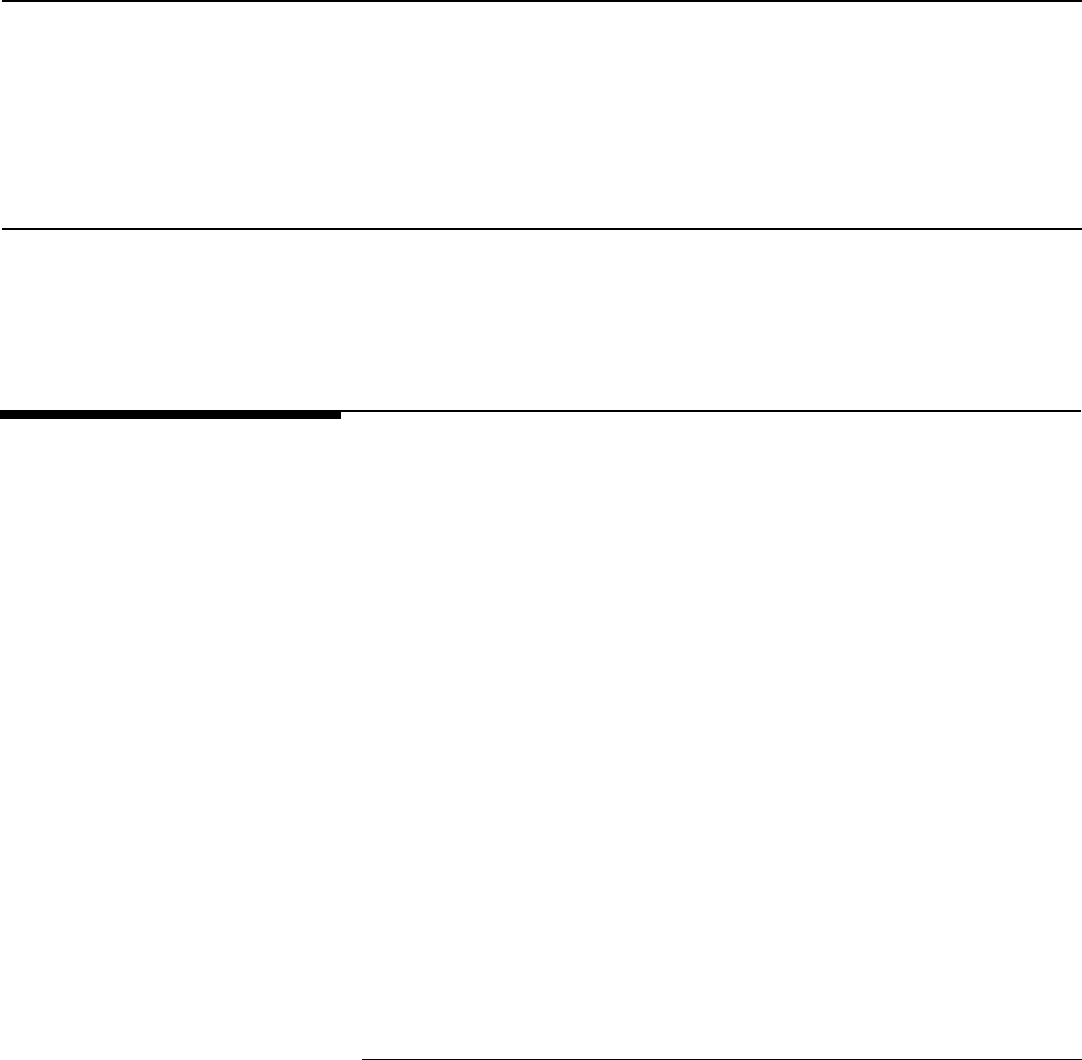
Page 56 GAO-23-105977 Flood Insurance
changes to address the legacy debt and determine an approach for
addressing potential future debt, NFIP’s debt likely will continue to grow
without any prospect of repaying it. As a result, NFIP’s fiscal solvency will
be delayed and issues of policyholder equity and affordability will persist.
There will also be increased risk to consumer participation in flood
insurance and resilience to flood risk.
Selected private insurers told us that current NFIP premiums generally
were lower than what they would need to charge to profitably underwrite
flood risk. We have also reported that discounted NFIP premiums
undercut private-sector premiums, place private insurers at a competitive
disadvantage, impede private-market growth, and ultimately limit
insurance options for policyholders.
102
While Risk Rating 2.0 may help to
address these concerns by implementing full-risk premiums, it does not
yet appear to have significantly affected the private flood insurance
market because the transition to full-risk premiums will take many years.
The private insurers told us they had not experienced a discernable
change in their flood insurance portfolios since Risk Rating 2.0 was
implemented, although some said other factors, such as inflation and the
housing market, could also be affecting their growth.
103
The private flood insurance market has grown, both in absolute terms and
relative to NFIP, according to data NAIC began collecting in 2018. From
2018 to 2022, the private market grew from 372,000 policies and $404
million in direct written premium to 641,000 policies and almost $1.3
billion in direct written premium.
104
Relative to NFIP, the private market
share grew from 7 to 12 percent of policies and from 8 to 22 percent of
direct written premium during this period (see fig. 16).
102
See GAO, Flood Insurance: Potential Barriers Cited to Increased Use of Private
Insurance, GAO-16-611 (Washington, D.C.: July 14, 2016).
103
We interviewed six private insurers in September and October 2022, approximately 12
months after FEMA began implementing Risk Rating 2.0 for new policies and 6 months
after implementation for renewals. Private insurers said much of their business comes
from new home purchases, so a slowing housing market would slow their growth.
104
From 2018 to 2022, the number of NFIP policies decreased by about 356,000 policies.
During this same period the private market grew by about 269,000 policies. It is likely that
some policyholders that dropped NFIP coverage replaced their flood coverage with a
private insurer. Written premium is the contractually determined amount charged on new
and renewing policies by the insurer to the policyholder based on the expectation of risk,
policy benefits, and expenses associated with the coverage provided by the policy.
Risk Rating 2.0 Has
Not Yet Significantly
Affected the Private
Insurance Market, but
Some NFIP Rules
Hinder Market Growth
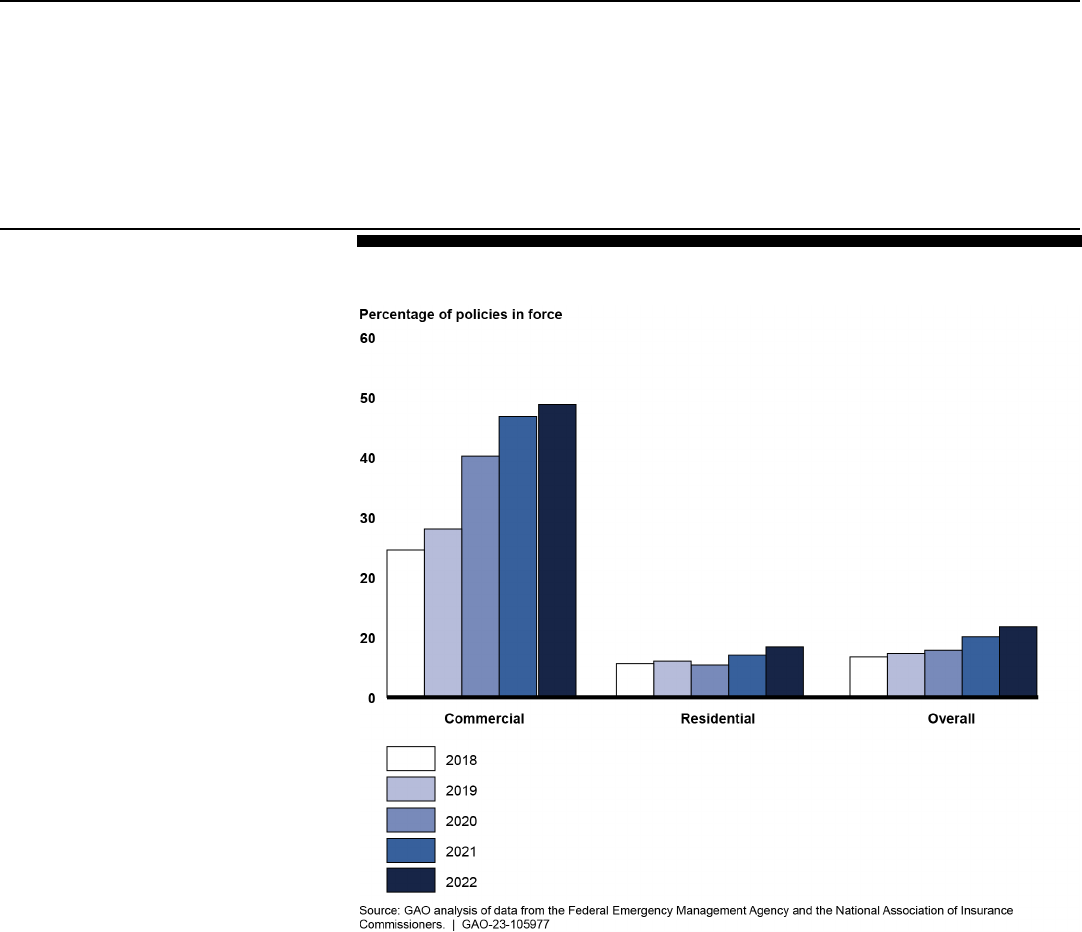
Page 57 GAO-23-105977 Flood Insurance
Figure 16: Private Flood Insurance Share of Flood Insurance Policies, by Number of
Policies
Note: Policy counts are as of December 31 of each year and account for each unit within a
Residential Condominium Building Association Policy as a separate policy.
Commercial flood insurance accounted for much of this increase, with the
private market share growing from 25 to 47 percent of all commercial
flood insurance policies. Private insurers told us their commercial policies
were particularly competitive because private insurers can offer a
commercial policy that covers multiple buildings and locations, while NFIP
requires separate policies for each insured building, which incurs
additional expenses. Other industry officials told us that the growth in the
private market share of commercial policies might be due to greater
awareness of flood risk among risk managers of commercial real estate.
Private insurers also told us that a key factor contributing to the growth of
the residential private flood insurance market was a 2019 interagency rule
from federal financial regulators requiring lenders to accept private

Page 58 GAO-23-105977 Flood Insurance
insurance for compliance with the mandatory purchase requirement.
105
The private insurers also said they are able to offer higher coverage limits
and broader coverage options than NFIP, which has helped them
compete.
106
Although the private market has grown in recent years, we have
previously reported on several barriers to private-sector involvement in
flood insurance.
107
Private insurers told us that two of these barriers, in
addition to discounted NFIP premiums, continue to impede private-market
growth.
• Continuous coverage rules. NFIP policyholders who receive
discounted premiums must maintain continuous flood insurance
coverage through NFIP to continue receiving the discounts.
Specifically, if a former NFIP policyholder who changed flood
coverage to a private insurer wants to repurchase NFIP coverage, the
policyholder must do so at full-risk premiums rather than rejoining the
glidepath. As a result, many NFIP policyholders may be reluctant to
consider private flood insurance policies out of concern that they
would be unable to return to NFIP at the discounted premium if the
private insurer were to significantly increase its premium or decide to
stop providing coverage. However, according to FEMA, the agency
lacks the legal authority to recognize private flood insurance policies
as continuous coverage.
• Lack of NFIP partial refunds. NFIP policyholders also are unable to
obtain partial refunds if they cancel their policy before the end of their
term (typically 1 year) and replace it with a private policy. To avoid
losing money, an NFIP policyholder must therefore consider private
coverage only near the end of the policy term. However, private
insurers told us this window is often too short, so many NFIP
policyholders are effectively unable to convert to private coverage.
105
Specifically, the Biggert-Waters Act requires federal regulators to direct lenders to
accept private-market policies that meet the statutory definition of private flood insurance,
and the regulators implemented this requirement, effective in July 2019. Loans in Areas
Having Special Flood Hazards, 84 Fed. Reg. 4953 (Feb. 20, 2019).
106
NFIP’s maximum coverage limit for one-to-four-family residential policies is $250,000
for buildings and $100,000 for contents. For nonresidential policies, the maximum
coverage limit is $500,000 per building and $500,000 for the building owner’s contents.
Many private flood insurers offer higher coverage limits and broader coverage, such as
coverage of basement contents and living expenses.
107
See GAO-17-425; GAO-16-611; and GAO, Flood Insurance: Strategies for Increasing
Private Sector Involvement, GAO-14-127 (Washington, D.C.: Jan. 22, 2014).

Page 59 GAO-23-105977 Flood Insurance
FEMA previously began allowing partial refunds for midterm
cancellations in October 2018 but ceased doing so in March 2019
because it determined it lacked legal authority to do so.
FEMA officials said there is a seasonal component to flood risk,
meaning that flood losses tend to occur during certain periods each
year in some areas. For example, in the Southeast, most flooding
occurs during hurricane season in the summer and fall. As a result, if
FEMA were to provide refunds for midterm cancellations on a strict
pro-rata basis, they would not be actuarially sound. For example, to
be actuarially sound, a 1-year policy canceled after 6 months likely
would receive more or less than a 50 percent refund, depending on
when the cancellation occurred in relation to the timing of the policy
term relative to the seasonality of flood risk. If most of the risk
occurred in the first 6 months, less than a 50 percent refund would be
given.
We previously identified several policy goals for flood insurance reform,
including promoting flood risk resilience, minimizing federal fiscal
exposure (including by encouraging private-sector involvement), and
encouraging consumer participation.
108
However, because FEMA’s
interpretation of the law finds that FEMA lacks the legal authority to allow
private coverage to satisfy the continuous coverage requirement or to
allow partial refunds for midterm cancellations, NFIP policy rules
discourage NFIP policyholders from seeking private coverage. This slows
the growth of the private flood insurance market and limits options for
consumers, both of which could result in less consumer participation in
flood insurance and therefore less flood resilience, as consumers are not
protected from the financial risk of flooding. Discouraging NFIP
policyholders from seeking private coverage also results in FEMA
maintaining risk and exposure that the private sector could otherwise
assume. Finally, to the extent that fewer property owners have flood
insurance, reliance on federal disaster assistance could increase,
ultimately increasing federal fiscal exposure.
108
See GAO-17-425.

Page 60 GAO-23-105977 Flood Insurance
FEMA has developed and released substantial information to explain Risk
Rating 2.0, relying primarily on WYO insurers to communicate the new
methodology to policyholders. Specifically, FEMA developed guidance
and training to enable WYO insurers to communicate with policyholders
on Risk Rating 2.0. FEMA also developed two websites to describe the
new methodology and make information available to NFIP insurers and
policyholders. Such information includes overview material, summaries of
changes, and detailed technical documents explaining the methodology,
data sources, and premium calculation. FEMA also developed documents
describing the specific characteristics and variables it uses to calculate
premiums under Risk Rating 2.0 and the discounts policyholders could
receive by undertaking actions to mitigate their flood risk. FEMA
presented this information online in several formats, including video,
interactive graphics, fact sheets, technical documents, and a frequently
asked questions page.
FEMA also provided data on how premiums would change under Risk
Rating 2.0, including the percentage of policies that would experience
premium decreases and increases and the magnitude of the premium
changes. These data included profiles tailored to individual states, as well
as downloadable data at the county and zip code levels. Further, FEMA
conducted training sessions and published training materials on its
websites to inform insurers and agents who would be selling and
servicing policies under Risk Rating 2.0 and interacting with
policyholders.
FEMA has not provided policyholders with comprehensive information
about Risk Rating 2.0 and its implications for mitigation and their
individual premiums. Specifically, FEMA provided general policy
information to policyholders, but according to FEMA officials, this
information included only one minor reference to Risk Rating 2.0 as being
a new ratemaking methodology. These mailings included a cover letter
with a short introduction to flood insurance, the actual flood insurance
policy, and policy declaration pages that summarize coverage and
premiums. The policy declaration pages included information such as
FEMA Has Released
Detailed Information
on Risk Rating 2.0,
but Has Not Provided
It to Policyholders
FEMA Has Developed and
Released Substantial
Information on Risk Rating
2.0, Largely Targeted to
Insurers
FEMA Has Not Provided
Policyholders Complete
Information about the New
Methodology and Its
Implications

Page 61 GAO-23-105977 Flood Insurance
property characteristics; flood zone; replacement cost value; the full-risk
premium; applicable premium discounts; policy assessments, surcharges,
and fees; the total annual premium charged; and the history of the
property’s NFIP flood claims.
However, none of this information explained to policyholders the new
methodology or its implications for mitigation and their individual
premiums or referred policyholders to FEMA’s Risk Rating 2.0 website
where rate methodology documents and other resources could be found.
Further, FEMA did not notify policyholders about the new ratemaking
methodology before implementing it.
Instead, FEMA officials told us they relied on WYO insurers and
insurance agents to communicate with policyholders and inform them
about Risk Rating 2.0, which they said was consistent with how they
communicated with policyholders before Risk Rating 2.0. FEMA officials
said they focused on developing guidance and training to support WYO
insurers and agents in policyholder communications. However, FEMA did
not establish any requirements to ensure that insurers and agents
communicated this information to policyholders on FEMA’s behalf.
As a result, policyholders may be uncertain about the Risk Rating 2.0
methodology generally and about how it applies to them individually,
including the justification for their individual premiums and the potential
savings associated with mitigation options. Officials from two associations
representing insurance agents told us policyholders have expressed
concern over premium increases and generally do not understand Risk
Rating 2.0, including how it produces premiums and what factors affect
those premiums. Policyholders also had questions about potential
savings associated with available mitigation options, such as elevation or
floodproofing. For example, officials from insurance agent associations
said policyholders asked agents how mitigating their flood risk could
reduce their premium.
Furthermore, agent association officials told us some agents generally felt
unequipped to explain Risk Rating 2.0 to policyholders and fully answer
their questions. Although FEMA has disclosed details of its ratemaking
methodology and the variables it uses on its website, association officials
said agents and policyholders cannot use them to calculate the same
information they could under FEMA’s legacy ratemaking methodology.
Under the legacy methodology, agents could consult FEMA’s rating
manual to determine why premiums may have changed and how
mitigation measures might affect premiums. However, Risk Rating 2.0

Page 62 GAO-23-105977 Flood Insurance
involves a more sophisticated modeling approach, which uses an
automated ratemaking mechanism that did not exist under the legacy
methodology.
As a result, Risk Rating 2.0 is more difficult for agents to explain to
policyholders than the legacy methodology. The new methodology is
complex and incorporates a greater number of flood risk variables. FEMA
officials told us that this sophistication was necessary to be consistent
with methods used by private insurers and to ensure that premiums
reflect an individual property’s flood risk. They added that because Risk
Rating 2.0 allows agents to obtain an instant quote from an automated
quoting system without consulting a detailed manual, insurance agents
can obtain a premium and write a policy more easily.
One of FEMA’s strategic objectives is empowering risk-informed decision-
making.
109
To build long-term resilience, the strategic plan stresses the
importance of individuals understanding risk and having resources and
capacity to mitigate or reduce it. The strategic plan also notes the
importance of accurate information about risk, and of data tools,
guidance, and public messaging that ensure highly technical information
is explained in easily understood, relatable ways. The plan states this will
enable individuals and communities to better understand technical
information to inform decision-making.
FEMA has not provided NFIP policyholders with comprehensive
information about Risk Rating 2.0, or otherwise made them aware of it.
Therefore, policyholders may not be fully informed about how Risk Rating
2.0 affects them and how they can reduce their premiums through
mitigation. Enhancing communication with policyholders to improve their
understanding of Risk Rating 2.0 as well as its implications for individual
premiums and mitigation possibilities could help policyholders make more
informed decisions about their flood risk and the risk-reducing effect of
potential mitigation efforts, thus helping advance FEMA’s resilience goals.
FEMA’s $36.5 billion in NFIP borrowing from Treasury since 2005
underscores the need for reforming the program. However, finding
common ground on reform has been difficult, largely because of the
competing goals of making the program solvent while keeping premiums
affordable for policyholders. Our April 2017 report outlined a road map for
109
Federal Emergency Management Agency, 2022–2026 FEMA Strategic Plan.
Conclusions

Page 63 GAO-23-105977 Flood Insurance
comprehensive reform to help bridge that divide, but much-needed reform
has yet to materialize.
110
However, through Risk Rating 2.0, FEMA has taken an important step to
help move the program toward solvency and actuarial soundness by
better aligning premiums with the underlying flood risk of the individual
properties it insures. Therefore, full implementation of this improved
ratemaking methodology is essential. FEMA could take several steps to
improve this effort, but addressing the program’s broader solvency and
affordability challenges will also require congressional action. Specifically,
challenges remain in the following areas:
• Additional policyholder charges. Policyholders pay two charges
that are not proportional to the risk of the insured property. Until
Congress authorizes and requires FEMA to incorporate these charges
into the full-risk premium, the total amounts paid by policyholders may
not be actuarially justified, and some policyholders could be over- or
underpaying.
• CRS discounts. CRS discounts are not actuarially justified because
they are paid for by policyholders not receiving the discount and are
not proportional to the risk reduction they provide. If FEMA were to
adjust CRS to incorporate discounts into the full-risk premium based
on the actuarial evaluation of risk reduction, it could ensure that full-
risk premiums are actuarially sound and that policyholders are paying
fair premiums. Further, if FEMA were to evaluate other means for
incentivizing desirable community activities that cannot be actuarially
justified, it could help ensure that such activities continue if they are
no longer incentivized through CRS discounts.
• Actuarial communication. Congress does not have key information
on Risk Rating 2.0, such as the loss levels that premiums are
designed to cover, the associated uncertainty, and estimated revenue
and shortfalls for the current and future years, as well as NFIP’s fiscal
outlook. By annually reporting on these items, FEMA could improve
understanding of Risk Rating 2.0 and better enable Congress to
oversee NFIP.
• Affordability. Addressing affordability through discounted premiums
and caps on annual premium increases has several limitations.
Specifically, this approach is not cost-effective because the discounts
are not targeted based on need. The approach also addresses
affordability poorly because some policyholders needing assistance
110
See GAO-17-425.

Page 64 GAO-23-105977 Flood Insurance
are not receiving it, and it is temporary. In addition, this approach
lacks transparency, and it hinders private-market growth by providing
artificially low premiums. A means-based assistance program is one
way Congress could address affordability more cost-effectively by
targeting it based on need. This also would increase the transparency
of the costs of affordability assistance by replacing discounted rates
and premium shortfalls with full-risk premiums and explicit assistance
in the budget. Further, replacing discounted premiums with assistance
that also could be used for private policies would promote private-
market growth. Finally, by addressing affordability needs more
effectively, Congress could encourage more policyholders to maintain
coverage, resulting in greater resilience to flood risk and less reliance
on disaster assistance.
• Program debt. NFIP’s debt to Treasury largely is a result of
discounted premiums that FEMA has been statutorily required to
provide. Charging current policyholders to repay the debt is not
actuarially justified, and the associated costs exacerbate affordability
concerns. Further, it is unlikely that FEMA will ever be able to repay
the debt as currently structured. Attempts to do so likely would lead
some policyholders to drop coverage altogether, leaving them
unprotected from flood risk, reducing resilience, and increasing
reliance on federal disaster assistance. Without actions to address the
legacy debt—for example, by canceling it or creating different
repayment terms—and the potential for future debt, NFIP’s debt likely
will continue to grow, actuarial soundness will be delayed, and
affordability concerns will increase.
• NFIP rules affecting private insurers. NFIP rules related to
continuous coverage and cancellation refunds are barriers to private-
sector growth. By authorizing and requiring FEMA to allow private
coverage to satisfy NFIP’s continuous coverage requirement and to
offer risk-based partial refunds for midterm cancellations that are
replaced by private policies, Congress could encourage policyholders
to seek private coverage and thereby help to decrease federal fiscal
exposure.
• Policyholder communication. Because FEMA has not
communicated directly with policyholders about Risk Rating 2.0,
policyholders may have questions about the methodology and its
implications for their individual premiums and mitigation. By taking
additional steps to improve policyholders’ awareness and
understanding of Risk Rating 2.0 and making available more detailed
property-specific information about premiums and potential mitigation

Page 65 GAO-23-105977 Flood Insurance
savings, FEMA could help policyholders make more informed
decisions about their flood risk and promote mitigation and resilience.
For NFIP to achieve long-term solvency and other policy goals, it will be
important for FEMA and Congress to take multiple actions to address a
number of challenges. In particular, actions are needed to address the
current and potential future debt as well as the conditions that caused the
debt to accumulate over time. While actions to address the existing debt
are essential, without elements such as full-risk premiums that are
actuarially sound and an appropriated, means-based assistance program,
NFIP’s debt problems will likely persist. As NFIP’s reauthorization
approaches, Congress and FEMA have the opportunity to address the
program’s long-standing challenges and place it on a path to achieve
fiscal solvency while addressing affordability.
We are recommending the following six matters for congressional
consideration:
Congress should consider authorizing and requiring FEMA to incorporate
the reserve fund assessment, to the extent necessary based on actuarial
principles, into the risk charge within the full-risk premium. (Matter for
Consideration 1)
Congress should consider repealing the HFIAA surcharge and authorizing
and requiring FEMA to replace forgone revenue with actuarially
determined premium adjustments. (Matter for Consideration 2)
Congress should consider providing any affordability assistance for flood
insurance through a means-based program that is reflected in the federal
budget rather than through statutorily discounted premiums. Options that
Congress might consider include allowing assistance to be used for
private policies and shortening or ending the period of discounted
premiums for those that do not qualify for assistance. (Matter for
Consideration 3)
Congress should consider addressing NFIP’s legacy and potential future
debt and should consider the best means for doing so. Options for
addressing the legacy debt include canceling the debt or creating specific
repayment terms funded by a transparent premium surcharge. Options for
addressing future debt include providing funding to make up for the
statutorily-generated premium shortfall, allowing immediate transition to
full-risk rates accompanied by a means-based assistance program,
Matters for
Congressional
Consideration

Page 66 GAO-23-105977 Flood Insurance
changing the financing of catastrophic losses, and enabling FEMA to
purchase additional reinsurance. (Matter for Consideration 4)
Congress should consider authorizing and requiring FEMA to allow
private flood insurance coverage to satisfy NFIP’s continuous coverage
requirement. (Matter for Consideration 5)
Congress should consider authorizing and requiring FEMA to offer risk-
based partial refunds for midterm cancellations of NFIP policies that are
replaced by private flood insurance policies and authorizing and requiring
FEMA to implement these refunds in an actuarially sound manner.
(Matter for Consideration 6)
We are making the following five recommendations to FEMA:
The Assistant Administrator of FEMA’s Federal Insurance Directorate
should adjust CRS by calculating a community’s rating based only on
community activities that reduce flood risk and by incorporating discounts
into the full-risk premium based on the actuarial evaluation of risk
reduction. (Recommendation 1)
The Assistant Administrator of FEMA’s Federal Insurance Directorate
should evaluate other means for incentivizing desirable community
activities that cannot be actuarially justified but are currently a basis for
discounts in CRS. (Recommendation 2)
The Assistant Administrator of FEMA’s Federal Insurance Directorate
should publish an annual actuarial report that includes the loss levels that
full-risk premiums are designed to cover and that current discounted
premiums are able to cover, and the associated uncertainty; the
estimated premium revenue and shortfall for current and future years; and
an evaluation of NFIP’s fiscal outlook, including projections of future debt.
(Recommendation 3)
The Assistant Administrator of FEMA’s Federal Insurance Directorate
should take steps to directly inform individual policyholders about Risk
Rating 2.0 and make them aware of available information.
(Recommendation 4)
The Assistant Administrator of FEMA’s Federal Insurance Directorate
should take additional steps to make available to policyholders, agents, or
both more detailed property-specific flood risk information to help them
Recommendations for
Executive Action

Page 67 GAO-23-105977 Flood Insurance
better understand the justification for individual premiums and potential
savings associated with available mitigation options. (Recommendation 5)
We provided a draft of this report to the Department of Homeland Security
for review and comment. In its comments, reproduced in appendix III, the
Department of Homeland Security agreed with our recommendations,
stating that it has proposed legislation to address some of the concerns
noted in our report. This legislation includes a proposal to create a
means-tested affordability program to assist low- and moderate-income
policyholders. The department also stated that it would continue to
enhance communication with policyholders directly and through NFIP
insurers. The Department of Homeland Security also provided technical
comments, which we incorporated as appropriate.
We are sending copies of this report to the appropriate congressional
committees and the Secretary of Homeland Security. In addition, the
report is available at no charge on the GAO website at
https://www.gao.gov.
Agency Comments
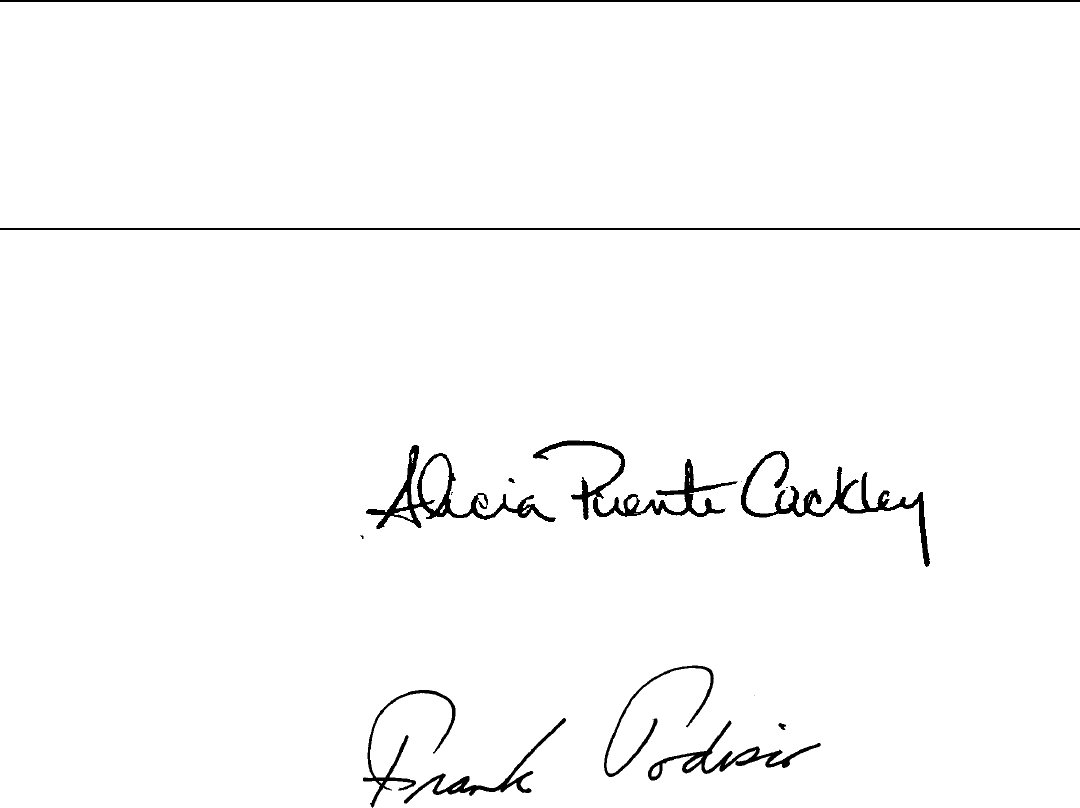
Page 68 GAO-23-105977 Flood Insurance
If you or your staff have any questions about this report, please contact
Todisco at (202) 512-2700 or [email protected]. Contact points for our
Offices of Congressional Relations and Public Affairs may be found on
the last page of this report. GAO staff who made key contributions to this
report are listed in appendix IV.
Alicia Puente Cackley
Director, Financial Markets and Community Investment
Frank Todisco
Chief Actuary, Applied Research and Methods

Appendix I: Objectives, Scope, and
Methodology
Page 69 GAO-23-105977 Flood Insurance
This report examines the Federal Emergency Management Agency’s
(FEMA) new methodology for setting premiums for the National Flood
Insurance Program (NFIP), known as Risk Rating 2.0. Specifically, we
examined (1) the actuarial soundness of the new methodology, (2) how
premiums are changing for policyholders, (3) efforts to make flood
insurance affordable for policyholders, (4) options for addressing program
debt, (5) the potential implications of Risk Rating 2.0 for the private flood
insurance market, and (6) FEMA’s efforts to promote policyholder
understanding of Risk Rating 2.0.
To address the first objective, our actuaries reviewed actuarial and other
ratemaking documents provided by FEMA.
1
We also reviewed FEMA
documents and statutory requirements on premiums, assessments,
surcharges, and fees; reinsurance; historical rate reviews; and financial
reports for NFIP. We reviewed all FEMA data sources used for
developing the full-risk premiums and FEMA’s methodology for selecting
the data and ensuring data quality and credibility. To examine the
actuarial soundness of premiums, we reviewed the actuarial assumptions
and methods FEMA used to develop the target losses for the policy year.
We also reviewed FEMA’s actuarial analysis on risk classifications, the
rationale for actuarial assumptions applied, and the actuarial models used
to develop rating factors, including commercial catastrophe models and
FEMA models that use data from other government agencies, such as the
U.S. Army Corps of Engineers. We reviewed the structure of the full-risk
premium and the factors that affect the full-risk premium and the total
policyholder payment. We also evaluated the reasonableness of FEMA’s
findings and conclusions included in its actuarial documents. We
interviewed FEMA officials and an actuarial association. Finally, we
1
The actuarial analyses and reviews in this report were performed by Senior Actuary Lijia
Guo, Ph.D., ASA, MAAA, and Chief Actuary Frank Todisco, FSA, MAAA. Collectively, the
actuaries responsible for this review meet the American Academy of Actuaries’
qualification standards with respect to their educational background, designated
professional standing, and experience.
Appendix I: Objectives, Scope, and
Methodology

Appendix I: Objectives, Scope, and
Methodology
Page 70 GAO-23-105977 Flood Insurance
compared the methodology and results against actuarial standards and
principles.
2
In performing this analysis, we relied on actuarial reports and
documentation provided by FEMA. We reviewed the documents for
reasonableness but did not audit them for accuracy. To the extent that
there are material deficiencies in completeness and accuracy in FEMA’s
actuarial reports, the actuarial premium estimates may be materially
different from those shown in the reports had these deficiencies not been
present. This review is not a technical review, and we did not verify the
accuracy of the calculations performed by the actuaries who developed
the full-risk premiums.
To address the second, third, and fourth objectives, we analyzed data
from FEMA’s PIVOT database on NFIP policies as of December 31,
2022.
3
We used these data to determine the premiums that FEMA was
charging NFIP policyholders and compared them to the full-risk premiums
that FEMA determined policyholders should be paying according to Risk
Rating 2.0. We assessed the reliability of these data by interviewing
FEMA officials and reviewing documentation on PIVOT. We also tested
the data by identifying missing data, outliers, and any obvious errors, and
comparing our results to published data. We determined that the data
were sufficiently reliable for the purposes of our analyses.
Because FEMA does not collect income information for NFIP
policyholders, we estimated policyholder household income using the
2
Casualty Actuarial Society, Statement of Principles Regarding Property and Casualty
Ratemaking (Arlington, Va.: May 7, 2021). The Actuarial Standards Board’s relevant
Actuarial Standards of Practice include 12 (Risk Classification for All Practice Areas); 23
(Data Quality); 25 (Credibility Procedures); 29 (Expense Provisions in Property/Casualty
Insurance Ratemaking); 30 (Treatment of Profit and Contingency Provisions and the Cost
of Capital in Property/Casualty Insurance Ratemaking); 36 (Statements of Actuarial
Opinion Regarding Property/Casualty Loss and Loss Adjustment Expense Reserves); 38
(Catastrophe Modeling); 39 (Treatment of Catastrophe Losses in Property/Casualty
Insurance Ratemaking); 41 (Actuarial Communications); 43 (Property/Casualty Unpaid
Claim Estimates); 46 (Risk Evaluation in Enterprise Risk Management); 47 (Risk
Treatment in Enterprise Risk Management); 53 (Estimating Future Costs for Prospective
Property/Casualty Risk Transfer and Risk Retention); and 56 (Modeling).
3
For condominiums, NFIP offers a Residential Condominium Building Association Policy,
which covers all units within a condominium. As such, it is necessary to adjust for the
number of condominium units to determine the number of policies. We account for this
when reporting the aggregate number of NFIP policies, but otherwise we treat these
condominium policies as single policies. We also excluded from our definition of
“commercial policy” a small number of nonresidential policies insuring mobile and
manufactured homes.

Appendix I: Objectives, Scope, and
Methodology
Page 71 GAO-23-105977 Flood Insurance
median household income of the census tract in which the insured
property was located, according to data from the Census Bureau’s 5-year
American Community Survey for 2015–2019.
To further answer the second objective, we used a statistical technique
called Bayesian Improved Surname Geocoding (BISG) to estimate the
probability that existing NFIP policyholders identified with one of five
racial and ethnic groups. These groups were
• Asian, Native Hawaiian, or Pacific Islander, non-Hispanic;
• Black or African American, non-Hispanic;
• Hispanic, any race;
• White, non-Hispanic; and
• all other groups.
Using this method, we combined data from two public release files from
the 2010 Census of Population and Housing on racial and ethnic
identification. We obtained aggregate data from the 2010 Census
Surname File on the probability that a respondent having a given
surname reported identifying with one of the groups above. We obtained
aggregate data from Summary File 1 on the number of adults in each
census block group who identified with each racial and ethnic group. We
compared the racial and ethnic groups from each file to data with prior
evidence of predictive accuracy, and we applied the BISG method as
described in the literature.
4
We assessed the reliability of these estimates
by conducting a literature review on the accuracy of BISG and by
examining the completeness and distributions of the estimates for NFIP
policyholders. Our prior work describes the BISG method in more detail.
5
To answer the third objective, we reviewed legislative proposals and
policy goals identified in our prior work.
6
We analyzed NFIP policy data to
4
Marc N. Elliott et al., “A New Method for Estimating Race/Ethnicity and Associated
Disparities Where Administrative Records Lack Self-Reported Race/Ethnicity,” Health
Services Research, vol. 43, no. 5, part I (October 2008): 1730–1732, and Kosuke Imai
and Kabir Khanna, “Improving Ecological Inference by Predicting Individual Ethnicity from
Voter Registration Records,” Political Analysis, vol. 24, no. 2 (Spring 2016): 263–272.
5
GAO, Tax Equity: Enhanced Evaluation Could Improve Outreach to Small Business
Owners, GAO-22-104582 (Washington, D.C.: Aug. 3, 2022).
6
GAO, Flood Insurance: Comprehensive Reform Could Improve Solvency and Enhance
Resilience, GAO-17-425 (Washington, D.C.: Apr. 27, 2017).

Appendix I: Objectives, Scope, and
Methodology
Page 72 GAO-23-105977 Flood Insurance
estimate the time it might take for FEMA to transition current
policyholders to full-risk premiums and the continued unappropriated
federal cost until the transition is completed. Our analysis focused on
NFIP policies on the glidepath—those that had not yet reached full-risk
premiums by December 31, 2022. Because new NFIP policies must pay
full-risk premiums, we assumed that premium shortfalls would come from
renewing NFIP policies on the glidepath from 2022 onwards.
To calculate premium shortfalls in calendar year 2022, we used PIVOT
data to subtract actual premiums from estimated full-risk premiums for
NFIP policies in force under Risk Rating 2.0 from January 1, 2022, to
December 31, 2022. Because Risk Rating 2.0 was fully implemented after
April 1, 2022, some NFIP policies had not yet renewed under Risk Rating
2.0 from January 1, 2022, to March 31, 2022, and did not renew under
Risk Rating 2.0 until between January 1, 2023, and March 31, 2023. For
calendar year 2023, we assumed that the average shortfalls and the time
it will take these policies to reach full-risk premiums will be the same as
the Risk Rating 2.0 policies we observed in 2022.
Our projection of premium shortfall from 2023 onward includes baseline
and alternative scenarios on (1) future full-risk premiums, (2) future
premiums actually charged (which would be less than full risk while
policies are still on the glidepath), and (3) the annual policy renewal rate.
In our baseline projection, we assumed that policies on the glidepath
would renew with NFIP each year until they reach full-risk premiums.
To project future premium shortfalls, we used inflation projections from
the Congressional Budget Office and NFIP gross annual loss projections
due to increased flood risks developed by the Office of Management and
Budget. For the future full-risk premiums, we assumed they would
increase with the projected annual inflation and annualized percent
increase in flood risks. For future charged premiums, we assumed that
the existing statutory annual premium increase caps would apply until
policies on the glidepath reach their full-risk premiums. We analyzed the
sensitivity of our estimates to our assumptions on inflation, flood risks,
annual reductions in the number of policies due to nonrenewal, and
annual premium increase caps by calculating the estimates using
alternative assumptions. Our shortfall calculations do not account for
assessments, surcharges, and fees. We calculated the total premium
shortfall net of WYO expenses. In fiscal year 2023, FEMA agreed to pay
WYO insurers 29.7 percent of premiums. We determined the present
value of premium shortfalls using a discount rate of 2.82 percent, based
on the 10-year average of Treasury spot rates, as of September 30, 2022.

Appendix I: Objectives, Scope, and
Methodology
Page 73 GAO-23-105977 Flood Insurance
We compared policyholders’ estimated household income to the annual
area median income of the area in which the property was located, as
determined by the Department of Housing and Urban Development. We
used these data and the property’s full-risk premium from PIVOT to
determine policyholders’ eligibility for assistance and the amount of
assistance they might receive under different potential means-based
assistance criteria. We also reviewed studies on flood insurance
affordability and legislative proposals for a means-based assistance
program for NFIP.
The PIVOT data contained 9 months of policy renewal data under Risk
Rating 2.0. We created our estimates of premium shortfall and the cost of
means-based assistance by extrapolating values obtained from 9 months
of data to 12 months, and assuming that declines in the number of
policies observed from April through December 2022 continued for the
period January through March 2023. To assess the need for and viability
of a means-based assistance program, we compared effects of current
affordability strategies to policy goals for flood insurance reform.
7
To address the fourth objective, we analyzed NFIP policy data,
reinsurance documents, and financial statements. We also reviewed our
previous work on NFIP, as well as reports from the Congressional Budget
Office, Congressional Research Service, FEMA, and others. We
assessed the options for addressing program debt against actuarial
standards and policy goals we established in prior work.
8
To address the fifth objective, we assessed the size and makeup of the
private flood insurance market using data from the National Association of
Insurance Commissioners’ (NAIC) data call on the number and total direct
written premium of private flood insurance policies. We assessed the
reliability of these data by comparing data elements, including private
insurer direct written premium and number of policies sold, with totals
from other NAIC publications, such as NAIC’s annual industry report, and
the raw data. We also interviewed NAIC officials about the accuracy and
limitations of the data and their process for ensuring reliability of the data.
We determined that the data were sufficiently reliable to determine the
number and total direct written premium of private flood insurance policies
in the United States.
7
GAO-17-425.
8
GAO-17-425.

Appendix I: Objectives, Scope, and
Methodology
Page 74 GAO-23-105977 Flood Insurance
We also interviewed six private flood insurers to obtain their views on
how, if at all, the implementation of Risk Rating 2.0 might be affecting
their companies and the overall private flood insurance market and any
challenges to private insurer growth. We used the NAIC data to identify
larger private flood insurers by direct written premium. We also used
these data to identify insurers with a variety of experience writing
residential and commercial policies, as well as those that did and did not
participate in NFIP’s Write Your Own program. Finally, we reviewed laws
and regulations that affect private insurers’ ability to provide flood
insurance and assessed these laws and regulations against policy goals
we established in prior work.
9
To address the sixth objective, we reviewed materials available on
FEMA’s website related to Risk Rating 2.0, including FEMA’s Flood
Insurance Manual, rating methodology guide, and discount guide. We
analyzed flood insurance policy materials that FEMA sends to
policyholders to determine the extent to which FEMA notified
policyholders of Risk Rating 2.0 changes. Further, we analyzed training
materials FEMA created for agents and Write Your Own insurers to
determine what information FEMA provided to these groups to inform
them about Risk Rating 2.0 and assist policyholders with their policies.
We compared these materials against several criteria, including FEMA’s
strategic plan and policy goals we established in prior work.
10
In addition,
to understand how FEMA communicated premium changes to insurers,
agents, and policyholders, we interviewed FEMA officials and two
associations representing insurance agents that work with NFIP
policyholders.
For all objectives, we reviewed relevant laws and regulations, relevant
FEMA documents, our prior reports, and academic publications on flood
insurance, and we interviewed FEMA officials. We also attended the
National Flood Conference in June 2022, which included discussion of a
number of topics related to Risk Rating 2.0 and flood insurance reform.
We conducted this performance audit from March 2022 to July 2023 in
accordance with generally accepted government auditing standards.
Those standards require that we plan and perform the audit to obtain
sufficient, appropriate evidence to provide a reasonable basis for our
findings and conclusions based on our audit objectives. We believe that
9
GAO-17-425.
10
GAO-17-425.

Appendix I: Objectives, Scope, and
Methodology
Page 75 GAO-23-105977 Flood Insurance
the evidence obtained provides a reasonable basis for our findings and
conclusions based on our audit objectives.
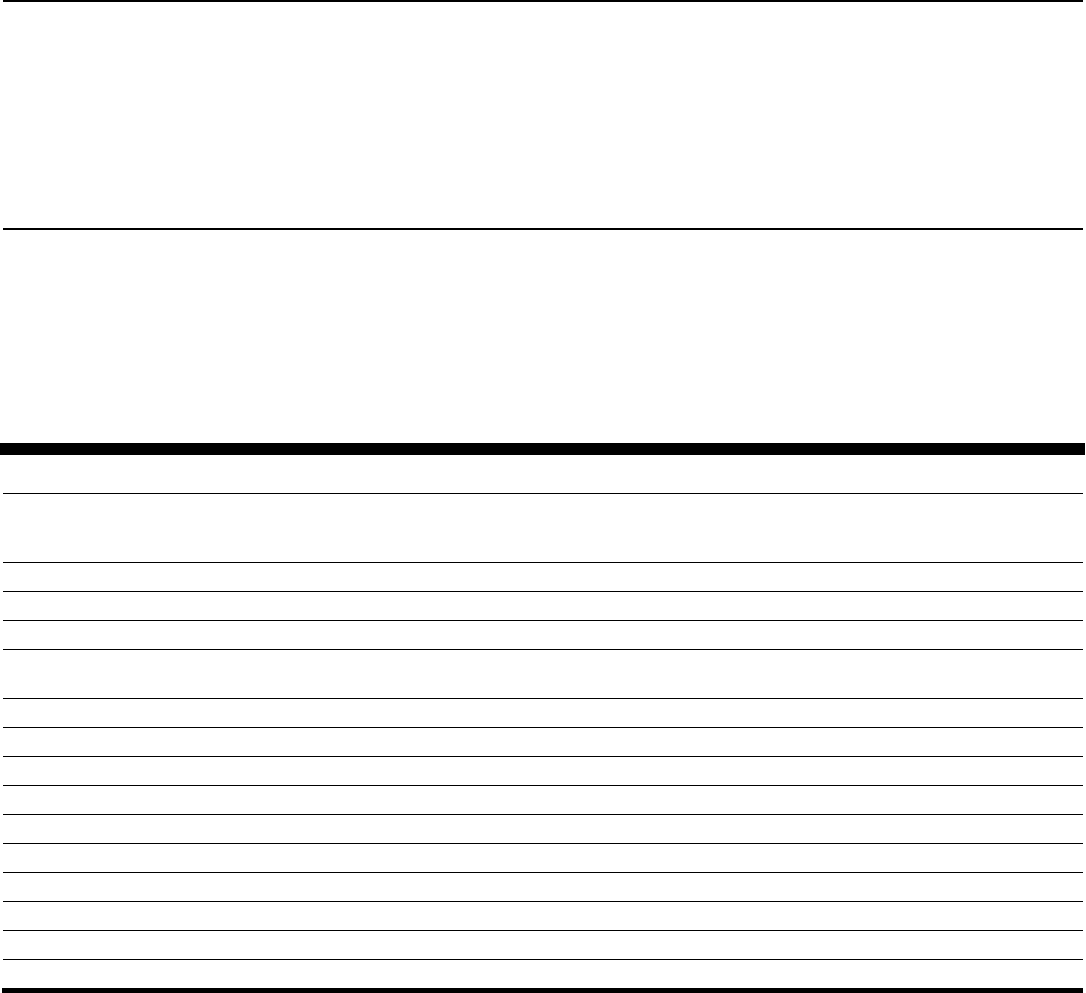
Appendix II: Additional Data on Glidepath and
Means-Based Assistance Estimates
Page 76 GAO-23-105977 Flood Insurance
We estimated the time it might take for the Federal Emergency
Management Agency to transition current policyholders to full-risk
premiums and the continued unappropriated federal cost until the
transition is completed. Our estimates included four key inputs: annual
premium increase caps, inflation rates, flood risk, and National Flood
Insurance Program (NFIP) policy renewal. Changing each input resulted
in different estimates (see table 3).
Table 3: Glidepath Time and Premium Shortfall Estimates
Scenario
Year when 95 percent
of policies reach
full risk
Total shortfall
(in billions)
Present value of
total shortfall
(in billions, 2022)
Baseline
2037
$26.7
$22.9
Alternate assumptions: statutory caps on annual premium increases
Increase all premium increase caps to 25 percent
2033
17.5
15.8
Decrease 18 percent premium increase caps to 9
percent
2055
67.2
46.4
Decrease all premium increase caps to 9 percent
2056
69.3
48.3
Alternate assumptions: inflation
Higher inflation
2037
27.2
23.3
Lower inflation
2037
25.0
21.5
Alternate assumptions: flood risk
Higher flood risk
2037
26.4
22.6
Lower flood risk
2037
25.8
22.1
Alternate assumptions: policy nonrenewal
3 percent nonrenewal
2036
22.1
19.2
6 percent nonrenewal
2034
19.2
16.9
Source: GAO analysis of Federal Emergency Management Agency data. | GAO-23-105977
Note: The baseline scenario assumes that all policies on the glidepath would renew National Flood
Insurance Program coverage and that flood risk would increase by 0.31 percent annually. The
alternate inflation scenarios assume that inflation would be 1 percentage point higher or lower in the
first year and converge to the baseline over 5 years. The higher and lower flood risk scenarios
change the annual increases in flood risk to 0.40 percent and 0.22 percent, respectively. The present
value amounts were determined using a discount rate of 2.82 percent.
We estimated the cost and number of recipients of a means-based
assistance program for which only current NFIP policyholders of primary
single-family residences would be eligible (see table 4). We also
estimated how these numbers would change by limiting eligibility to
policyholders with properties in special flood hazard areas. We used two
alternatives for determining the assistance amount. The first alternative
would cover the amount of the premium that exceeded a certain
Appendix II: Additional Data on Glidepath
and Means-Based Assistance Estimates
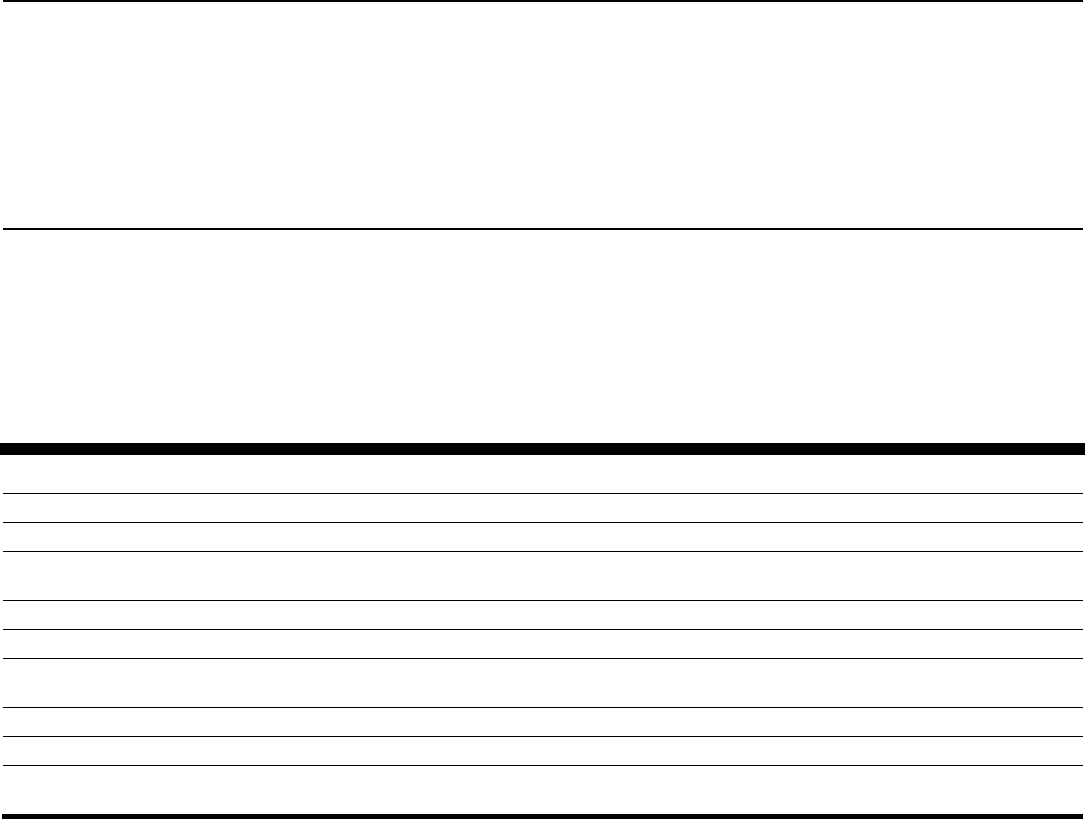
Appendix II: Additional Data on Glidepath and
Means-Based Assistance Estimates
Page 77 GAO-23-105977 Flood Insurance
percentage of household income (1 or 2 percent) and restrict eligibility to
policyholders whose household income was below a certain percentage
of the area median income (80, 100, or 120 percent). The second
alternative would provide premium discounts on a sliding scale, whereby
the discount would increase (from 40 to 80 percent) as a policyholder’s
household income decreased relative to area median income (from 100 to
50 percent).
Table 4: Estimated Participants and Costs of Alternative Means-Based Assistance Programs
Alternative 1
Alternative 2
AMI eligibility threshold
≤ 80%
≤ 100%
≤ 120%
≤ 80%
≤ 100%
≤ 120%
≤ 100%
Percentage of household income at
which assistance begins
1% 2% n/a
All policies
Eligible policyholders
756,159
1,236,585
1,555,816
473,894
718,359
875,569
1,549,904
Total cost of federal assistance
(first year, dollars in millions)
$907
$1,556
$2,030
$585
$969
$1,237
$1,308
Policies in special flood hazard areas only
Eligible policyholders
378,710
632,449
795,342
259,556
410,009
508,641
721,209
Total cost of federal assistance
(first year, dollars in millions)
$559
$977
$1,287
$383
$646
$840
$752
Legend: AMI = area median income; n/a = not applicable
Source: GAO analysis of Federal Emergency Management Agency data. | GAO-23-105977
Note: This analysis assumes that a means-based assistance program would replace the glidepath, so
any policy receiving assistance would immediately convert to the full-risk premium. The assistance
would cover all costs of flood insurance, which include premiums as well as any assessments,
surcharges, or fees.
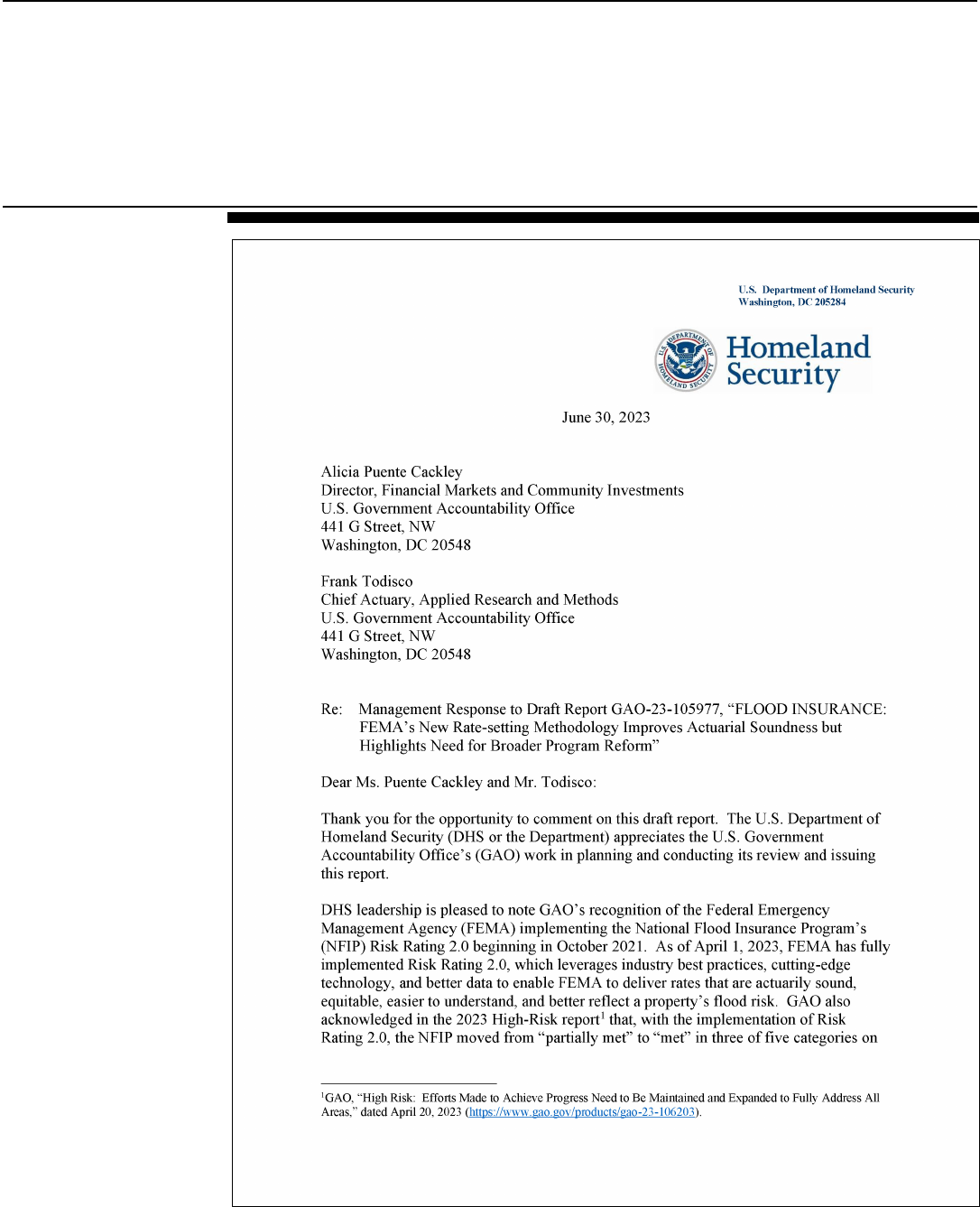
Appendix III: Comments from the Department
of Homeland Security
Page 78 GAO-23-105977 Flood Insurance
Appendix III: Comments from the
Department of Homeland Security
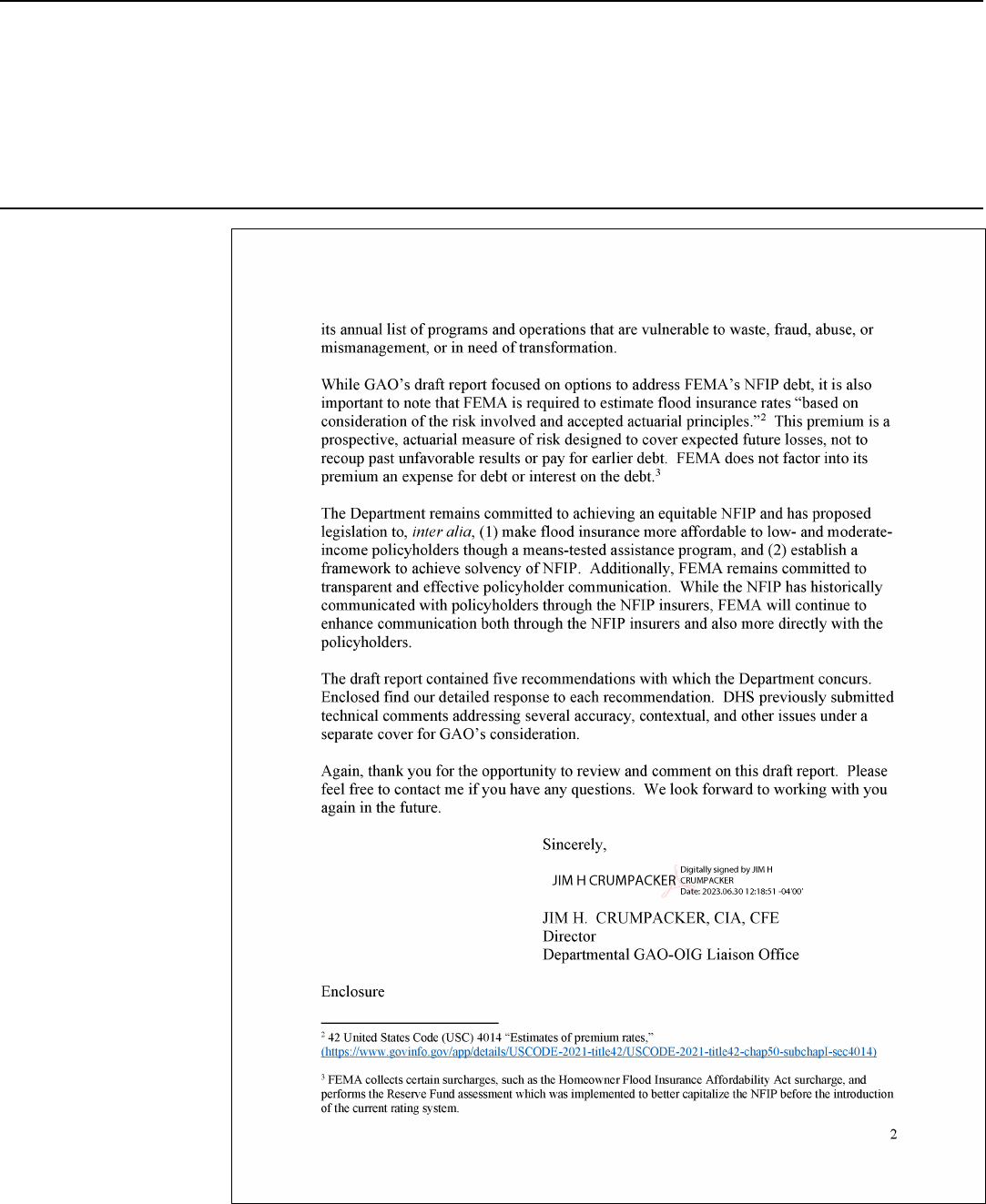
Appendix III: Comments from the Department
of Homeland Security
Page 79 GAO-23-105977 Flood Insurance
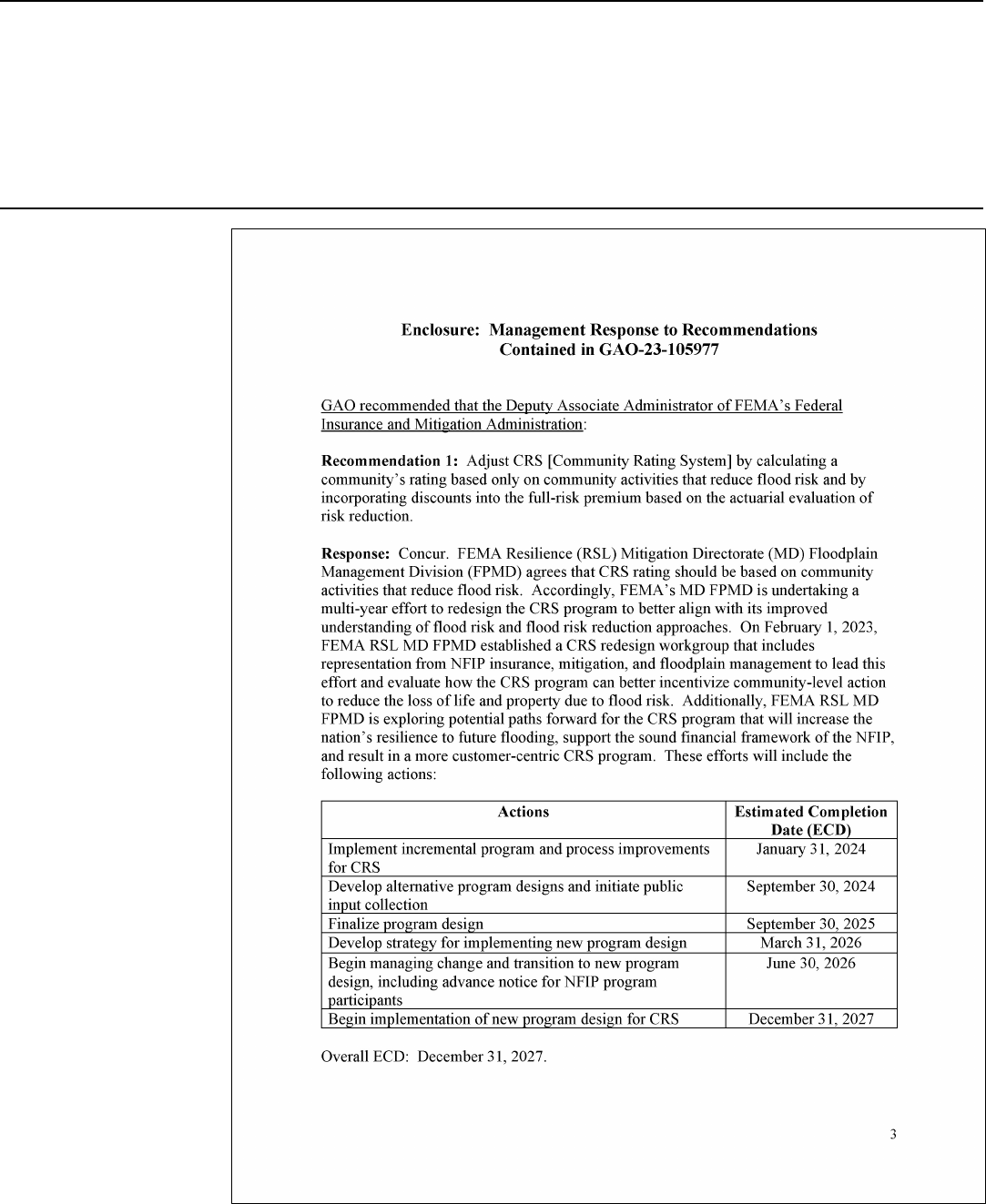
Appendix III: Comments from the Department
of Homeland Security
Page 80 GAO-23-105977 Flood Insurance
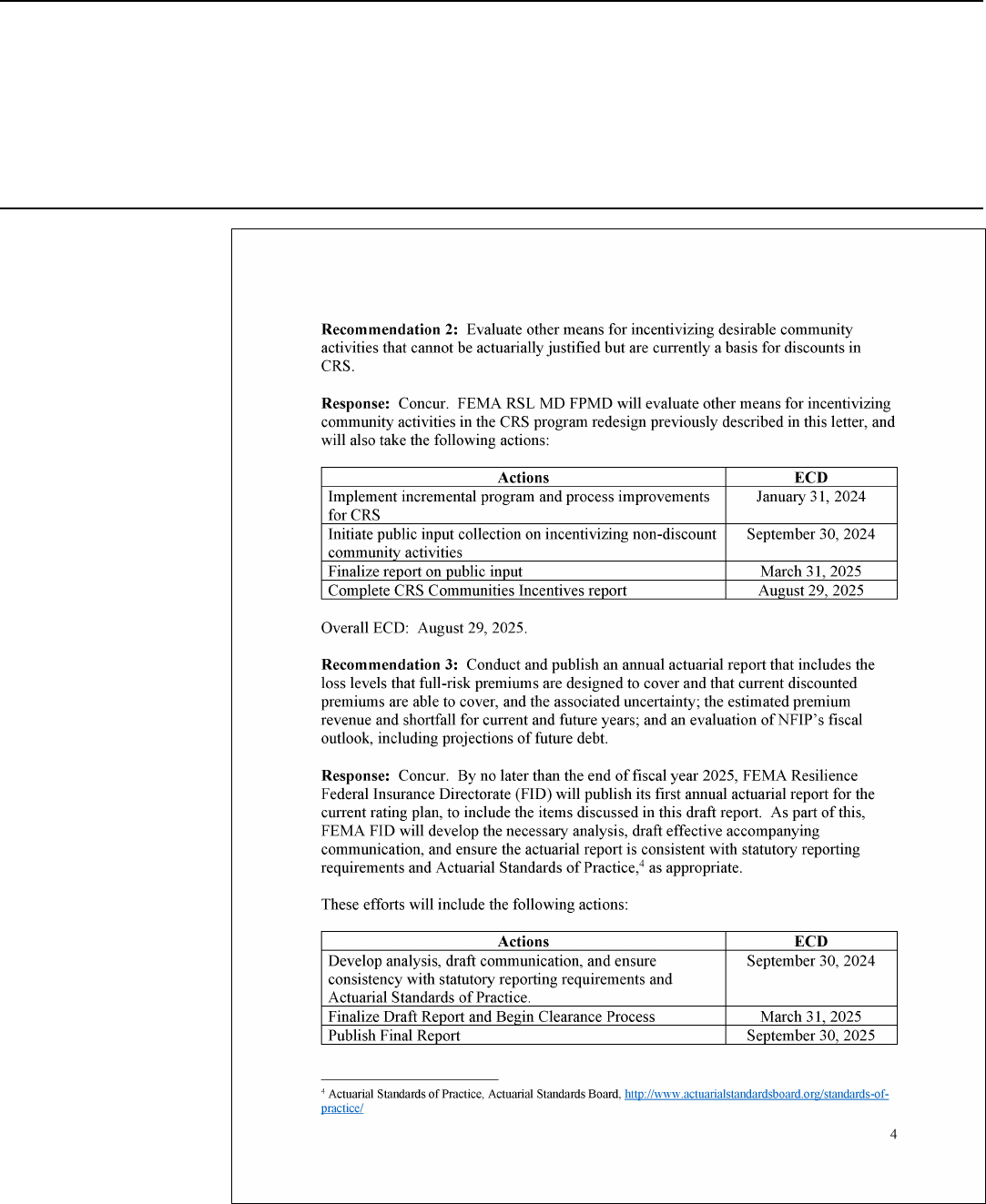
Appendix III: Comments from the Department
of Homeland Security
Page 81 GAO-23-105977 Flood Insurance

Appendix III: Comments from the Department
of Homeland Security
Page 82 GAO-23-105977 Flood Insurance
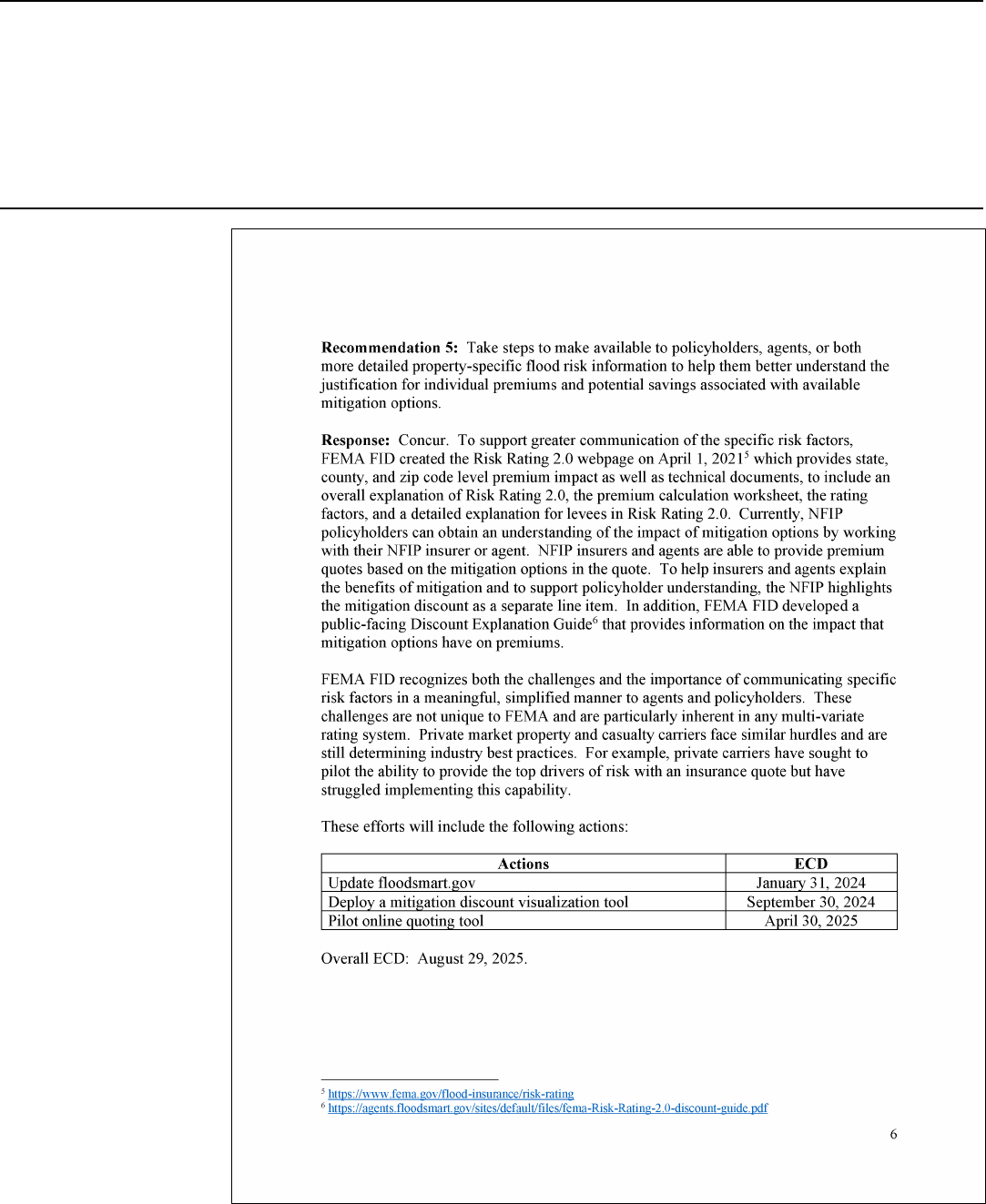
Appendix III: Comments from the Department
of Homeland Security
Page 83 GAO-23-105977 Flood Insurance

Appendix IV: GAO Contacts and Staff
Acknowledgments
Page 84 GAO-23-105977 Flood Insurance
In addition to the contacts named above, Patrick Ward (Assistant
Director), Christopher Forys (Analyst in Charge), Xiang Bi, Dylan
Desjardins, Lijia Guo, Jocelyn Kuo, Jill Lacey, Sailaja Ledalla, Matthew
Levie, Scott McNulty, Marc Molino, Angela Pun, Steve Ruszczyk, Jessica
Sandler, Jennifer Schwartz, and Jeff Tessin made key contributions to
this report.
Appendix IV: GAO Contacts and Staff
Acknowledgments
GAO Contacts
Staff
Acknowledgments
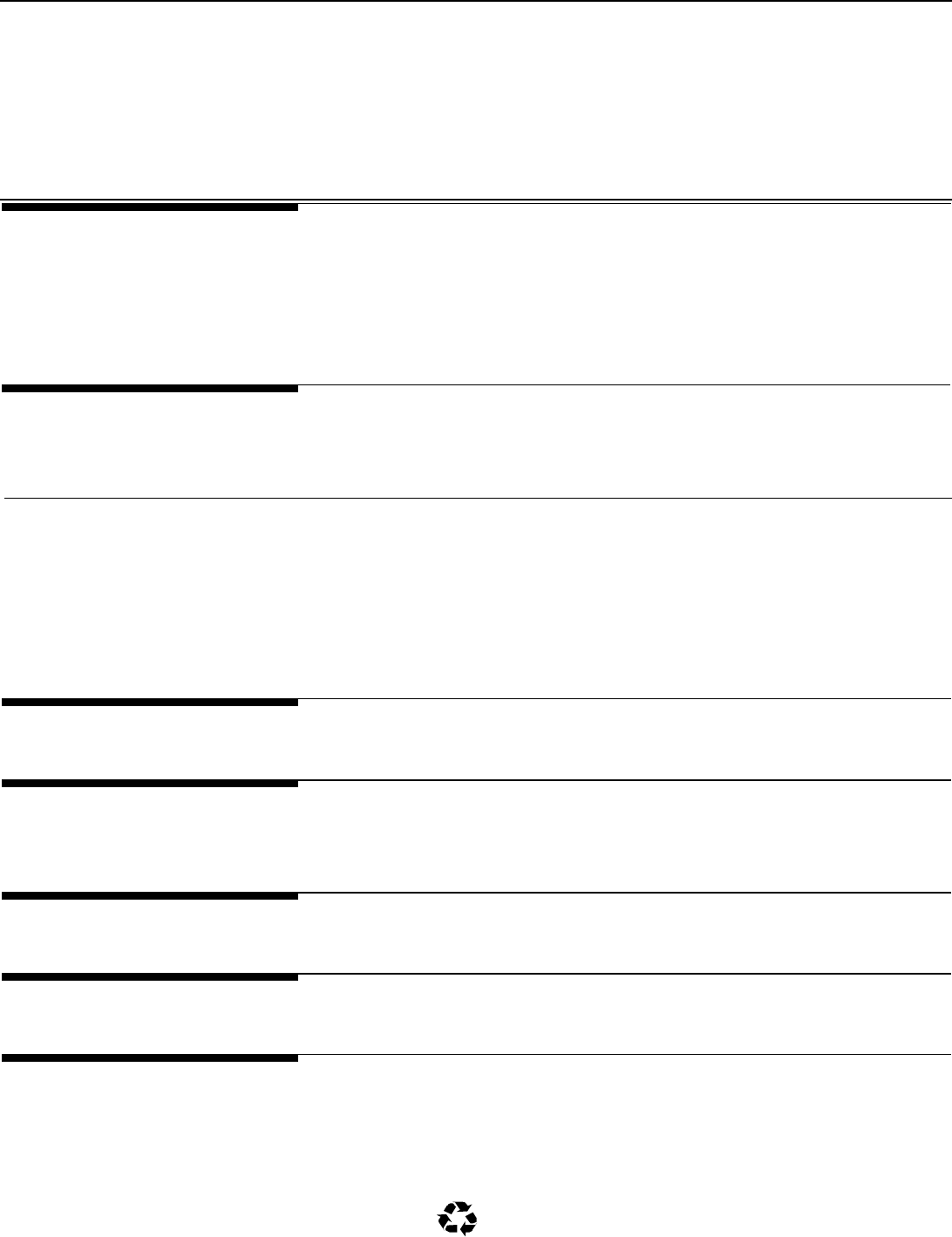
The Government Accountability Office, the audit, evaluation, and investigative
arm of Congress, exists to support Congress in meeting its constitutional
responsibilities and to help improve the performance and accountability of the
federal government for the American people. GAO examines the use of public
funds; evaluates federal programs and policies; and provides analyses,
recommendations, and other assistance to help Congress make informed
oversight, policy, and funding decisions. GAO’s commitment to good government
is reflected in its core values of accountability, integrity, and reliability.
The fastest and easiest way to obtain copies of GAO documents at no cost is
through our website. Each weekday afternoon, GAO posts on its website newly
released reports, testimony, and correspondence. You can also subscribe to
GAO’s email updates to receive notification of newly posted products.
The price of each GAO publication reflects GAO’s actual cost of production and
distribution and depends on the number of pages in the publication and whether
the publication is printed in color or black and white. Pricing and ordering
information is posted on GAO’s website, https://www.gao.gov/ordering.htm.
Place orders by calling (202) 512-6000, toll free (866) 801-7077, or
TDD (202) 512-2537.
Orders may be paid for using American Express, Discover Card, MasterCard,
Visa, check, or money order. Call for additional information.
Connect with GAO on Facebook, Flickr, Twitter, and YouTube.
Subscribe to our RSS Feeds or Email Updates. Listen to our Podcasts.
Visit GAO on the web at https://www.gao.gov.
Contact FraudNet:
Website:
https://www.gao.gov/about/what-gao-does/fraudnet
Automated answering system: (800) 424-5454 or (202) 512-7700
A. Nicole Clowers, Managing Director, ClowersA@gao.gov, (202) 512-4400, U.S.
Government Accountability Office, 441 G Street NW, Room 7125, Washington,
DC 20548
Chuck Young, Managing Director, young[email protected], (202) 512-4800
U.S. Government Accountability Office, 441 G Street NW, Room 7149
Washington, DC 20548
Stephen J. Sanford, Managing Director, [email protected], (202) 512-4707
U.S. Government Accountability Office, 441 G Street NW, Room 7814,
Washington, DC 20548
GAO’s Mission
Obtaining Copies of
GAO Reports and
Testimony
Order by Phone
Connect with GAO
To Report Fraud,
Waste, and Abuse in
Federal Programs
Congressional
Relations
Public Affairs
Strategic Planning and
External Liaison
Please Print on Recycled Paper.
